Miss Wanderitall

The Salkantay Trek without a guide or tent
- 16 April 2020 15 October 2022
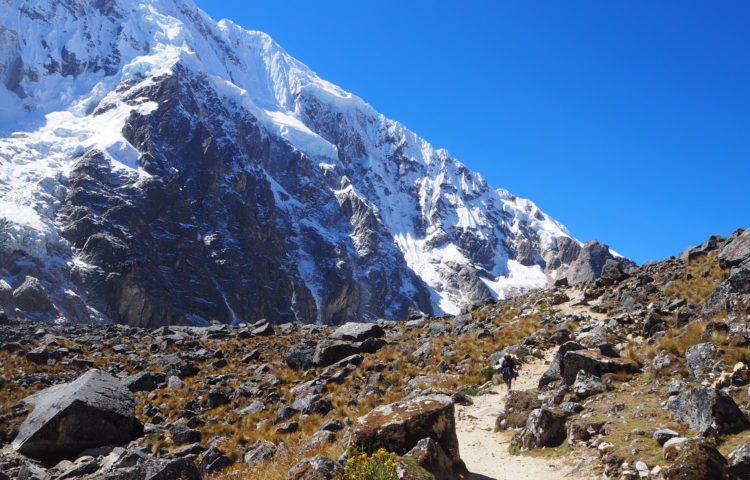
The Salkantay Trek to Machu Picchu is one of the most popular trekking routes in Peru , however, is it possible to do it on your own and sleeping at guesthouses , avoiding to hire a guide or carrying your tent and your own food? We found out it was and, moreover, it was amazingly easy and cheap ! So here we provide all the information for you to also live this experience.
The basics of our Salkantay Trek without a guide:
Duration: 5 days/4 nights Date of travel: from June the 23rd to June the 27th, 2019 Number of travellers: two people Time of preparation: a month for the organisation, way longer for the physical training
In this post you will find everything you need to know to prepare for the Salkantay Trek without a guide, on your own and even better, without carrying a tent to sleep or food for the whole trek ! We will cover where to sleep and eat , all the transportation you will use to get to the starting point of the trek and return to Cusco and how is every day of the trek going to look like .
When you finish reading, you will know everything you need to prepare for this trekking that will take you right to one of the World’s Seven Wonders: Machu Picchu.

Also, if you want to have some useful information about the difficulty of the trek and how to determine if you are prepared to do it, how to prepare the track and what tools you can use to navigate the route, information on altitude sickness and how to minimise its effects, safety along the route and what does your backpack need to contain, check my other post ‘ Salkantay Trek on your own: 5 essentials to prepare ‘.
Salkantay Trek on your own: 5 essentials to prepare
Can I do it on my own?
The salkantay trek without a guide in figures, first night – soraypampa, second night – chaullay, third night – lucmabamba, fourth night – near aguascalientes, 2.3. where to eat, 2.4. transportation, before you start…, side trek to humantay lake, day 2: soraypampa – abra salkantay – chaullay, day 3: chaullay – lucmabamba, from hidroeléctrica to aguascalientes, machu picchu mountain and citadel, to hidroeléctrica and back to cusco, 4. the cost of the salkantay trek without a guide, 1. the business around the salkantay trek.
When we were preparing for our trip to Peru, we learnt that we could arrive to Machu Picchu by trekking instead of taking the train or a bus and we instantly knew that was the option for us. However, almost every piece of information we found regarding the Salkantay Trek was directed at those trekking with a guide or alternatively on how to trek on your own but carrying tent and food. Either was the experience we were looking for. We wanted to carry a light backpack and sleep and eat at guesthouses .
After many searches, we found the amazing blog of Career Break Adventures and their post ‘ Salkantay Trek to Machu Picchu (Without a Tent or Guide) ‘. It was our inspiration to prepare our itinerary to trek by our terms : without a guide, without a tent and without carrying the food we would eat for five days.

Once at Cusco and along the trek we spoke with locals and we understood the Salkantay Trek is a huge tourist attraction . Travel agencies are not really interested in you going on your own . For this reason, if you search in the web and if, once in Peru, try to gather information from travel agencies, they will tell you that the trek is not safe and that it’s not possible to do it on your own because you won’t find accommodation or meals. This is absolutely not true .
If you keep reading you will find that the Salkantay Trek passes through several towns and small villages . Almost all of them have accommodation and provide food for their guests. Depending on the day of the trek and your budget, this accommodation may be a private room, a shared dorm or a tent . Your hosts will provide you with everything you need.

Moreover, we were able to keep the cost of the experience at a little less than 150 € per person. All expenses are included in this sum, even the Machu Picchu tickets to the citadel and Machu Picchu Mountain. This is significantly lower than the average cost of a guided tour, ranging from 240 to 420 € (tickets to Machu Picchu -60 € for the citadel, 75 € if you visit also one of the mountains- not included in this price). Later in this post, you will find a compilation of all the expenses we had in the Salkantay Trek without a guide.
Therefore, the only question that will remain is if you are physically and mentally prepared for this trekking, so be sure to read my post ‘ Salkantay Trek on your own: 5 essentials to prepare ‘ for information on that matter.
2. The trekking experience
2.1. in a nutshell.
The Salkantay Trek is a trekking route to arrive to Machu Picchu . It is an alternative to the more famous, but much more regulated Inca Trail, which has a limited number of trekkers allowed per day and gets full months in advance. This is not the case in Salkantay, as there is not a limit in the number of trekkers allowed.
It lasts five days and four nights , visiting Machu Picchu on the last day. With 92 km (57 mi) and almost 8,000 m (26,245 ft) of accumulated elevation gained/lost (3,000 m / 9,840 ft gained and 4,880 / 16,010 ft lost), it is a high demanding extremely beautiful trek. Also, one of the coolest experiences you will have in Peru. Cusco is the ‘base-camp’ you will leave from and where you will return after the adventure.
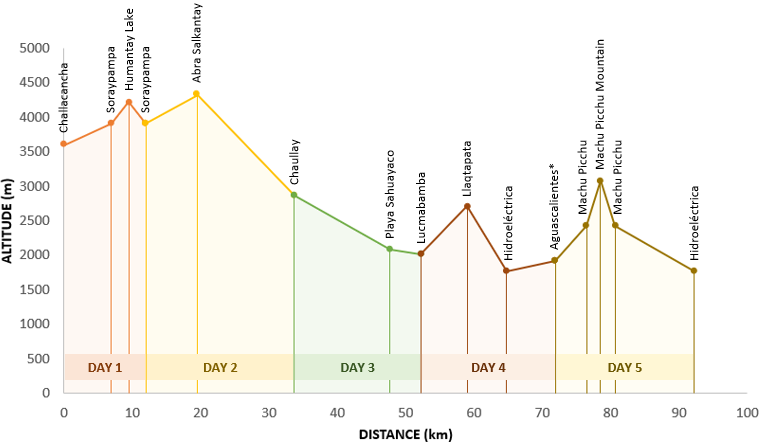
The Salkantay Trek can be done on your own (either sleeping and eating at guesthouses or carrying your own tent and food) or with an organised group with a guide and porters.
The Salkantay Trek does not require any special skill apart from general fitness and determination . The path is clear and easy to walk, although you can expect some altitude sickness. I believe everyone who is in a good physical condition, has some general knowledge of mountaineering and has thoroughly prepared this trip can do it.
We chose to go on our own and do the Salkantay Trek without a guide and without carrying a tent and food . However, we did carry plenty of snacks (nuts and dehydrated fruit) to substitute most lunches during the trek. We slept every night at guesthouses or campings, where we also bought our meals.
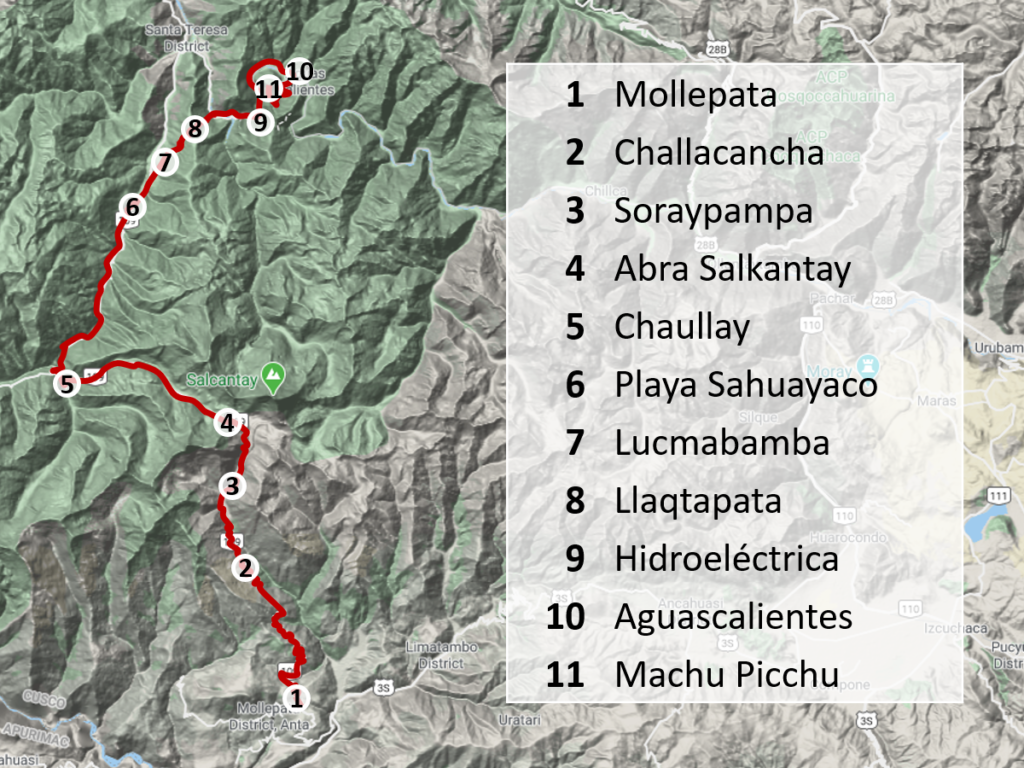
On the first day, we got up early and took the bus to Challacancha , where we started our trek. We walked to Soraypampa , found accommodation, had lunch and left our bags to climb to Humantay Lake .
We slept in Soraypampa and the next morning headed to Abra Salkantay , the highest point of the trek, and started our way down to Chaullay , where we slept on our second night.
The third day we followed a down and easy trail that took us to Lucmabamba to rest.
We started the fourth day climbing to Llaqtapata , then we descended to Hidroeléctrica . From there we followed a long, flat and easy trail to Aguascalientes , but we stopped roughly 3.5 km / 2.2 mi before the town to sleep closer to the Machu Picchu entrance. We still were about 2km / 1.2 mi from the entrance, so we would recommend finding a closer accommodation. We never visited Aguascalientes.

On the fifth day we woke up early again to be among the first ones to enter Machu Picchu . We had a hard, short climb to the entrance still at night. Once at Machu Picchu, the first thing we did was climb the quite demanding Machu Picchu Mountain . When we returned to Machu Picchu archaeological site, we took a guided tour and then raced down to Hidroeléctrica to take a direct bus to Cusco .
The second and last day were definitely the most challenging ones.
These are the main numbers that can help you get an idea of what you will be facing:
* We slept roughly 3.5 km / 2.2 mi before Aguascalientes, to be closer to the Machu Picchu entrance
2.2. Where to sleep
In general, you can sleep in guesthouses, home-stays, campings (in which case your hosts will provide you with the tent, sleeping bag and even a pillow). You will even find fancy expensive domes at some towns. You can’t book these accommodations in advance if you don’t travel with a group, so it’s generally recommended to arrive early to ensure you find a place.
What would happen if you didn’t? You would need to walk a few extra kilometres to reach the next, less popular town. You would for sure find a place to sleep there, but you will probably be tired from the long day walk.
There is hot water everywhere. In general, showers are not included and you need to pay about 10 PEN per person. Toilets can be either private or shared . This will play a role on the price of the room and whether the shower is included or not.
In Soraypampa you will find plenty of guesthouses, campings and domes so just ask around to find the option that works for you.
We slept in a camping. We rented a tent which our hosts prepared for us under a hay cover. Sleeping bags, mattress and a pillow were included, although we didn’t have a shower available. It was a slightly cold night, but we attribute that to the altitude as we were very sheltered from the wind.

For two people, we payed 20 PEN for the accommodation, being our cheapest night in the Salkantay Trek.
We found that most guesthouses offer either rooms, a space for your tent and tents to rent . Showers are available at an extra cost. We arrived at 16.30h and were able to secure one of the last rooms available for 40 PEN for the both of us, so we would recommend to try to arrive earlier, even this is one of the hardest days of the trek.
If rooms are not available when you arrive, you can rent a tent or keep walking to Collpapampa if you still have the energy. It is about 1 km / 0.6 mi from Chaullay and also has plenty of options for accommodation.
As a curiosity, in Chaullay our hosts asked us to have our meals in the kitchen, isolated from other guests. They didn’t want us to share with them that we were doing the Salkantay Trek without a guide.
We found that Lucmabamba was the less crowded place where we slept, because many groups sleep at Santa Teresa to visit its hot springs. There are a very few guesthouses or home-stays , but it is unlikely you find yourself without options because of the low number of tourists visiting.
For us, it was the best night of the whole trek. We rented a room with shared bathroom and a big comfortable bed at Sonia and Walter home stay, in the middle of a coffee plantation, for 50 PEN for both. It was the first night we had electricity.
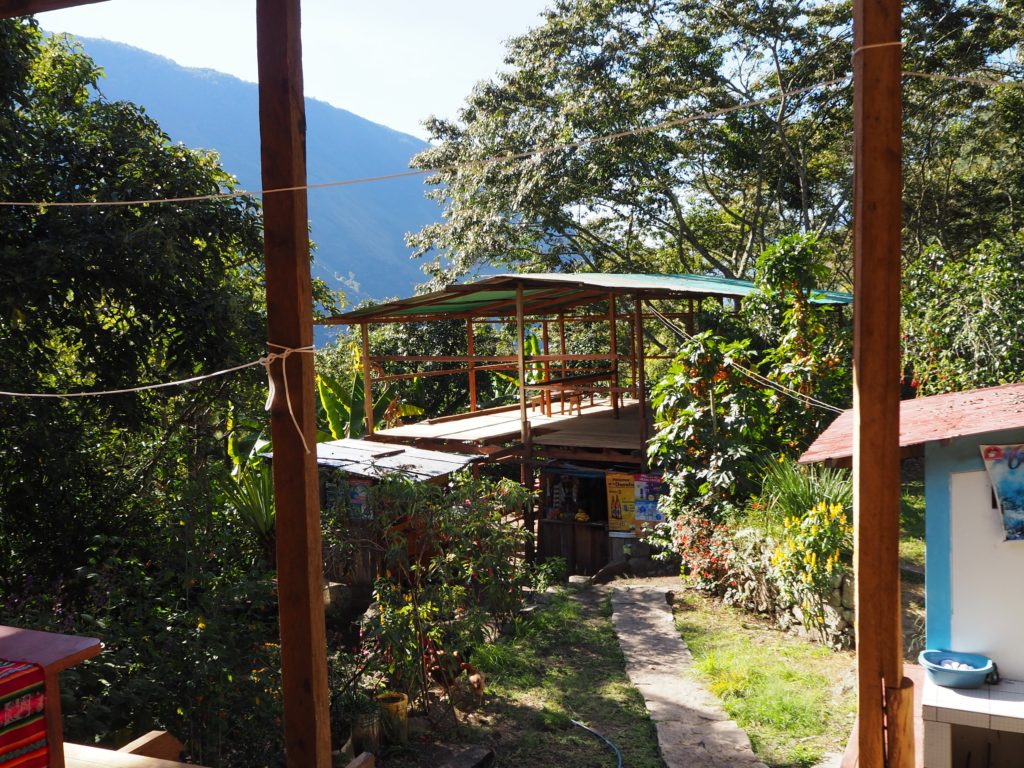
Some alternatives for this day are the lodges you will find near the main road, just before taking the trail to Lucmabamba (1km / 0.6 mi before Lucmabamba). Also, the nearest towns of Playa Sahuayco or Sahuayco, although they are roughly 4 km / 2.4 mi before Lucmabamba and this would mean a very long fourth day.
The most popular option is to sleep in Aguascalientes (also known as Machu Picchu Pueblo), in which case you will have a lot of options. However, we decided against this for several reasons:
- We were not going to take the train from Hidroeléctrica to Aguascalientes, nor the bus from Aguascalientes to the entrance of Machu Picchu. Therefore the closer we slept from the Machu Picchu entrance the better. We avoided to walk a few kilometres at the end of the fourth day.
- If we had stayed in Aguascalientes, that would mean returning there to get our backpack once our visit to Machu Picchu had ended. Therefore, 4 extra kilometres.
- Everything we read and were told about Aguascalientes prevented us to go there. We understood it is a town filled with tourists coming from the Salkantay Trek, the train to Machu Picchu and the buses to Hidroeléctrica from Cusco – Santa María – Santa Teresa. It has hot springs, party and drunk tourists. We don’t like either of these things, so we decided we could miss it. It is a very personal choice.
We stayed at Mandor (formerly Gea Lodge) , which is the only hostel you will find before Aguascalientes. A dorm with 4 beds, shared bathroom and electricity cost 40 PEN per person.
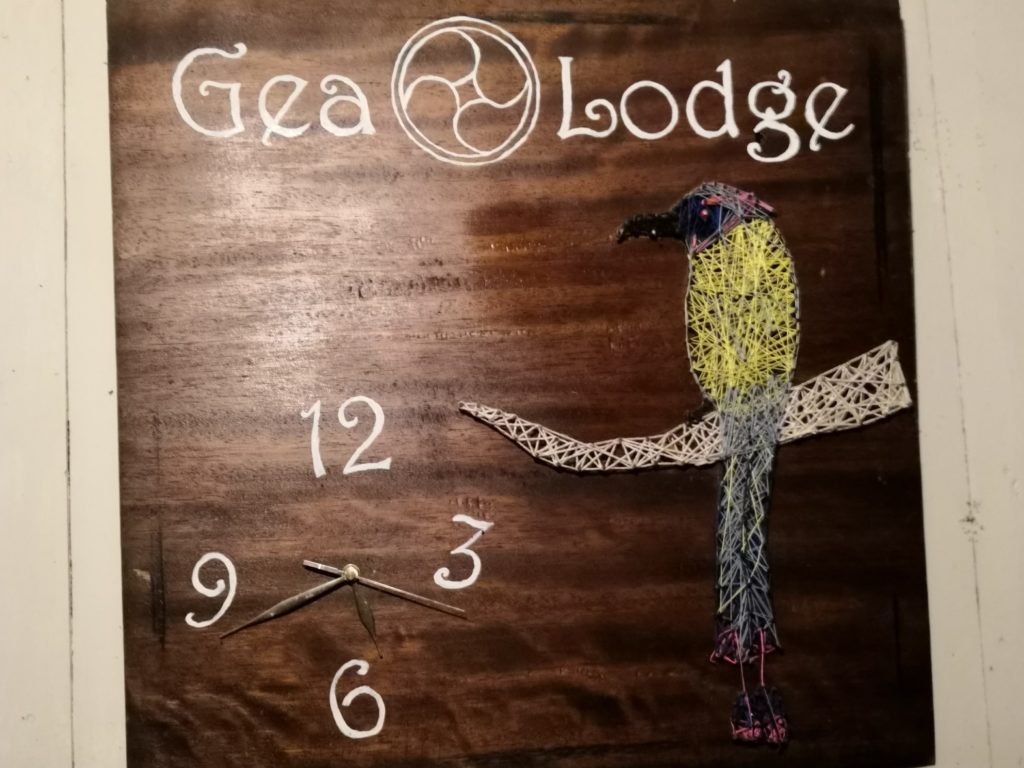
Around Mandor and until Aguascalientes, there are a few campings available . When we were there on June 2019, they only had tents, however, they were building some bungalows that were supposed to be ready in a couple of months. If we had to recommend you what to do, we would tell you to look for the closer camping to the Machu Picchu entrance, and rent a tent or bungalow to sleep there.
You will have breakfast and dinner in the guesthouse or camping where you sleep. The cost will range from 10 to 15 PEN per person per meal. Don’t expect anything fancy: it will probably consist on an omelette with vegetables and rice, coca tea (mate de coca), juice and coffee. Hot, abundant and nutritive, what else could you need?
Regarding lunch, you may be able to ask for it to-go. You definitely can just stop at any town during the route. However, when we are trekking we always skip lunch and eat plenty of snacks during the day instead (mostly nuts and dehydrated fruits). We prefer this option because we don’t want to waste time waiting for our lunch and, anyway, our body constantly needs the energy from nuts and fruit, and the rest you get from these short stops along the way.
As of water , we carried purification pills and were able to refill our bottles every few minutes for almost the whole trek. The only stage were we couldn’t find water was from Llaqtapata to Hidroeléctrica, on the fourth day. It is also possible to buy bottled water in guesthouses and in the villages you pass, but I would recommend you just to purify it to reduce your plastic waste.

- Bus from Cusco to Challacancha. Leaving from the intersection between Av. Arcopata and Av. Apurimac in Cusco, you take the bus to Mollepata. Once at Mollepata, from where the first bus left you, take another bus or taxi to Challacancha, where you will be starting the trek. You will need to wait for each bus to fill before you leave.
- Train from Hidroeléctrica to Aguascalientes. It will save you from a two hours flat and easy walk at an awfully expensive price: 31 USD per person. Also, if you want to sleep closer to the actual entrance to Machu Picchu, not in Aguascalientes, you will need to walk down some part of the trail, as the train only stops at the end of the line.
- Bus from Aguascalientes to the Machu Picchu entrance. The fact that it costs 12 USD per person is the reason why we decided to walk instead and why we didn’t sleep in Aguascalientes but closer to the Machu Picchu entrance. However, it will save you from a considerably demanding climb.
- Train from Aguascalientes back to Hidroeléctrica.
- Bus from Hidroeléctrica to Cusco. The last direct bus leaves at 16h and arrives at 21.30h, so you better plan your visit to Machu Picchu accordingly. The alternative is changing the bus at Santa Teresa and then again at Santa María, which would take even longer.
- Alternatives for tiredness or sickness. From Playa Sahuayaco (end of third day of the Salkantay Trek) it’s possible to take a bus or taxi to Santa Teresa (popular alternative, particularly among guided groups, because of its hot springs), and another one from Santa Teresa to Hidroeléctrica. Also, the trekking trail goes in parallel to the road during the third day of the trek, so you could take a bus or taxi there.
3. Salkantay Trek without a guide – day-by-day route
Before the trek, we had stayed two nights in Cusco, having previously spent two days in Titicaca Lake and two days in Arequipa, so altitude sickness was not new to us . Also, in this high altitude we had been very active and done a few short treks and a lot of ups-and-downs in the streets of Cusco, so we were better equipped to walk in altitude.
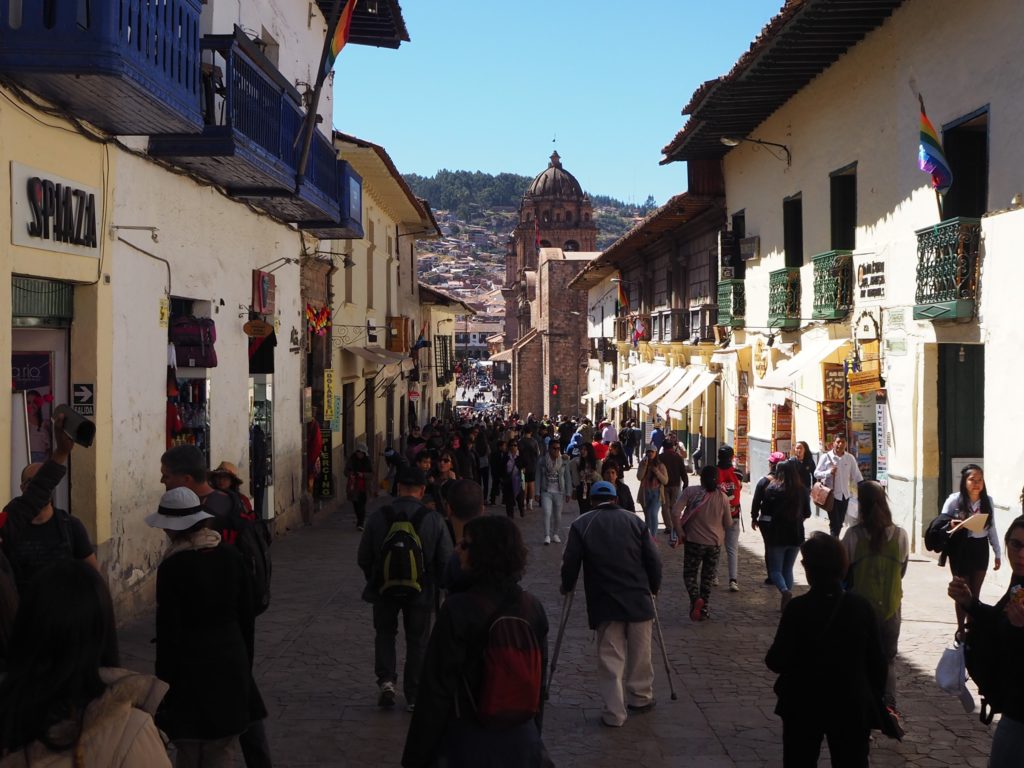
Cusco is also the perfect place for last-minute purchases for the Salkantay Trek without a guide: topographic map and compass, hat, trekking poles… There are plenty of stores with mountaineering equipment around Plaza de Armas so just take the time to visit a few of them to find products and prices that convince you.
In the case of the trekking poles , we bought a pair of them for 80 PEN instead of renting. When we returned back to Cusco, we sold the poles back to one of these stores for 30 PEN. It was way cheaper that if we had rented them, although we had to visit a few stores to find one that would take them.
It was not easy for us to buy a topographic map at Cusco (we had to visit several stores) because, as I said, everything is prepared for you to go in an organised group, so it may be a good idea to buy it online .
Day 1: Cusco – Mollepata – Challacancha – Soraypampa – Humantay Lake
We woke up at 2.45h to be at 3.45h in the Bus Station to Mollepata . We arrived by Uber for 6 PEN from the centre of Cusco. After waiting for half an hour for the bus to be full, and for 15 PEN per person it took us to Mollepata , arriving at 6.15h. Just before entering the town, we passed through a control were we had to pay our 10 PEN per person entry fee to the Salkantay Trek.
We were supposed to take another bus from Mollepata to Challacancha but were told that a taxi was the only option we had available. Apparently, buses are only for organised groups.
So we took a taxi. We were lucky enough to find another couple of travellers that were following the exact same route we were following (also inspired by Career Break Adventures ), so we shared the 15 PEN per person 50 minutes ride. This was the only price we were able to bargain during the trek.
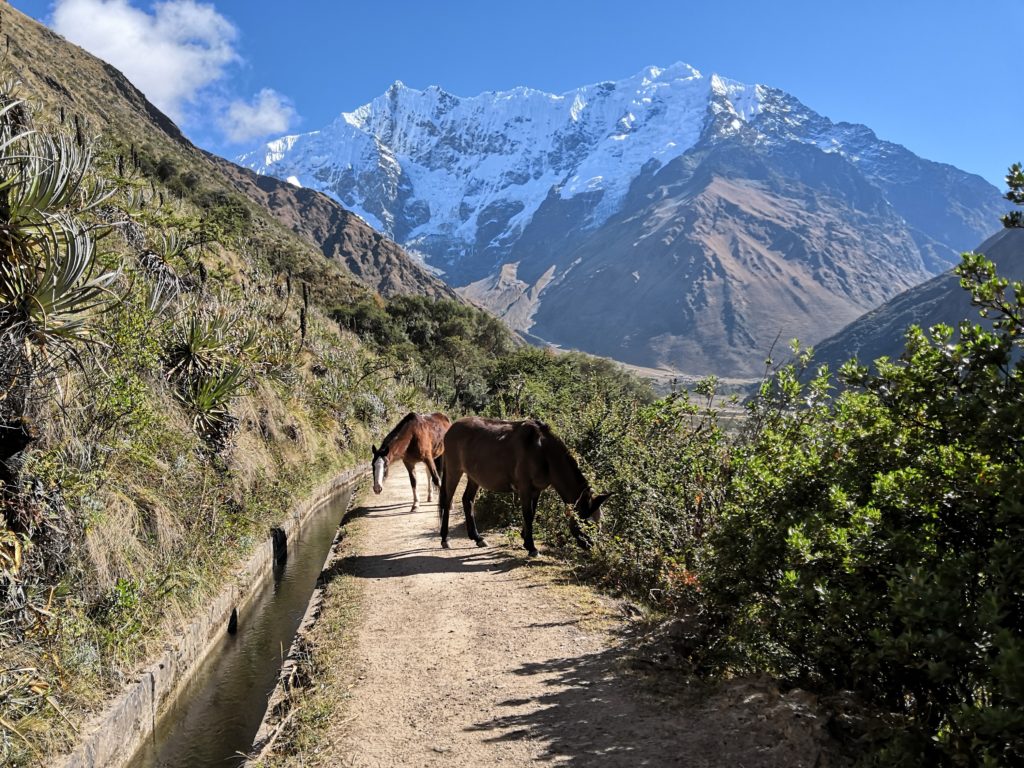
The 2.5h trail from Challacancha to Soraypampa is generally easy. It is steep at the beginning and just before arriving to Soraypampa. In between, it goes next to a river and is flat and narrow.
Once we had found accommodation we took a short nap, had lunch and started our way up to Humantay Lake . It was not long (about 1.5h) but harder than we expected, even with our bags at the campsite. The path was very steep and you definitely felt the lack of oxygen.
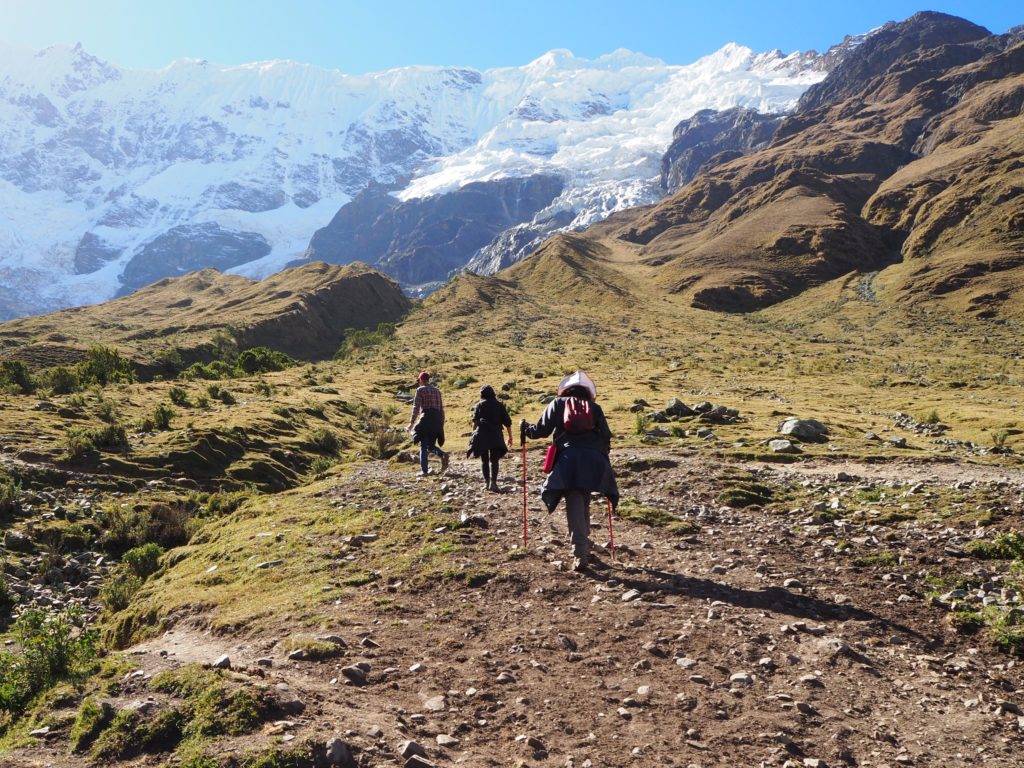
You forgot about all that once you arrived to the lake. It is one of the most beautiful places we have ever visited. We lingered there for a little longer than we should have, relaxing, taking pictures and exploring the surroundings. We watched the sunset from that point. On the way down, the sun was already leaving. It was considerably easier, but a little hard on the knees.

The weather had been very pleasant the whole day, we weren’t cold even at the Humantay Lake (4,221 m / 13,848 ft). However, at night temperatures were notably lower and we were glad to have the shelter from the hay cover and the sleeping bag. The sky was clear and full of stars.
In the second day of the Salkantay Trek without a guide, we started walking at 6.30h. A very steep trail with plenty of zigzags that allowed us to gain altitude fast, let you arrive to Abra Salkantay in 4.5h.
We felt lightheaded and fatigued all the way up, having to stop several times to catch our breath. We even had to stop once for half an hour because I felt extremely dizzy. Rest and food helped and healed us every time. Don’t try to hurry to the Pass, listen to your body and give it the rest it needs. Luckily the surroundings are amazingly beautiful.
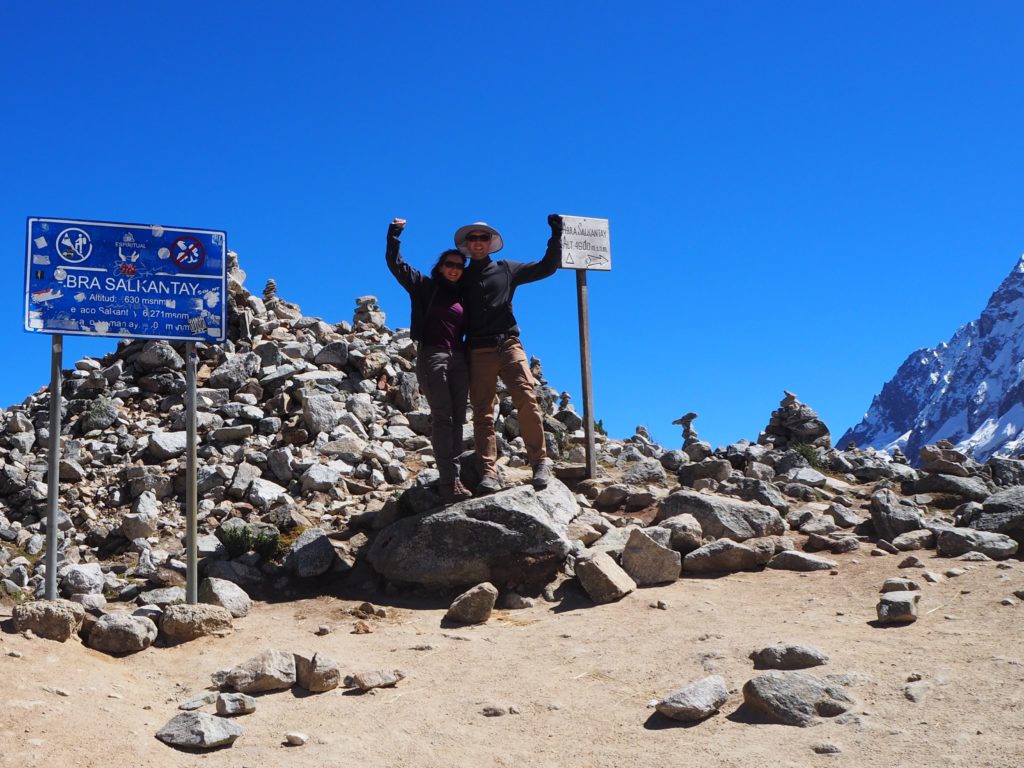
Once at the top, having completed one of the hardest sections of the trek, the landscape was spectacular. We were not cold at all and we spent a few minutes soaking on the beauty of the mountain range. Then, we started the long 5.5h descend. Very welcomed at the beginning because it was easy and the amount of oxygen was higher and higher. However, 13 km / 8 mi and 1,800 m / 5,905 ft of descend are no joke. It truly felt like the day never ended and the last few hours were nothing short from infernal.

We arrived to Chaullay at 16.30h, got a room, took a shower, had dinner and went to sleep exhausted.
Overall, it was one of the most physically demanding days of my whole life.
We started walking once again at 6.30h. This third day of the Salkantay Trek without a guide was generally easy and downhill, but long. During the first few minutes we walked in the road, until we turned left across the river and took the trail.
From Chaullay to Playa Sahuayco , the path goes down with a few easy and short climbs. For most of the time it crosses the jungle, so be prepared for heat and insects. Once you arrive to Playa Sahuayco and until you turn left for the trail to Lucmabamba , you walk again in the flat road.

Playa Sahuayco and Sahuayco are real towns, not the small villages you will have encountered so far. It will be possible for you to have lunch there, however, we decided to continue.
The last climb from the main road to Lucmabamba is short and not particularly steep. However, we were so tired that it was a huge effort for us. We passed the first home stay we found and settled in the second one because it was slightly cheaper.
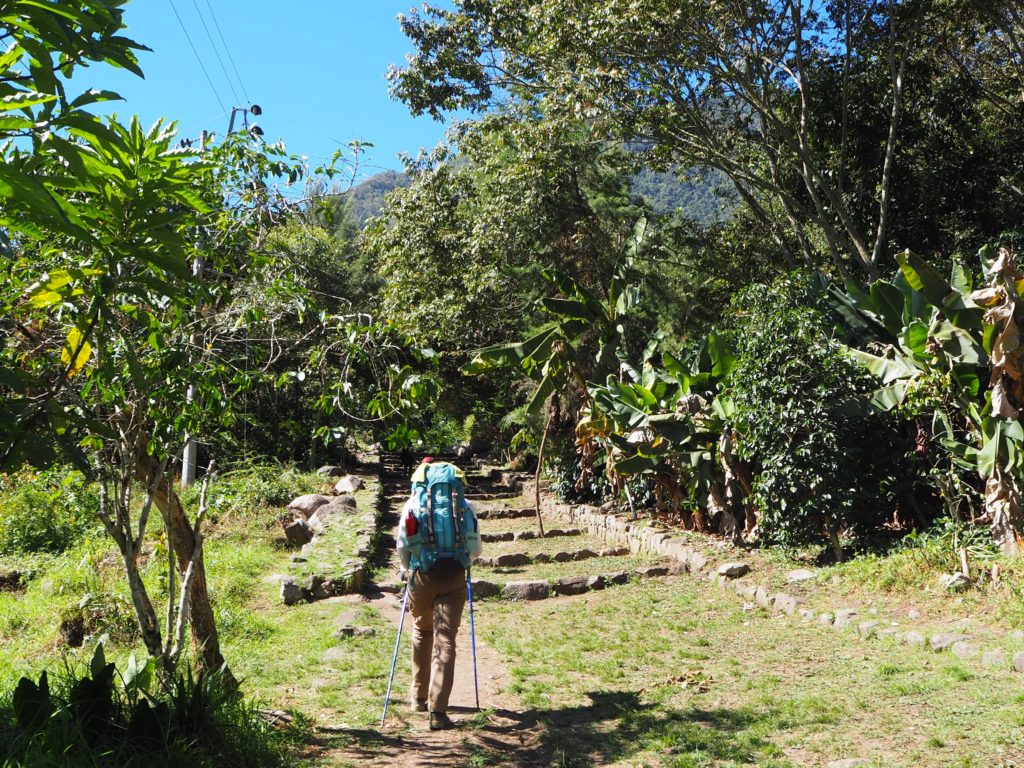
It was 13.30h and we had already finished the trekking of the day, so we were really proud – and tired. We rested for almost an hour, took turns on the shower and spent a great part of the afternoon massaging our muscles and stretching. The dinner was amazingly good and we went to sleep feeling a little repaired.
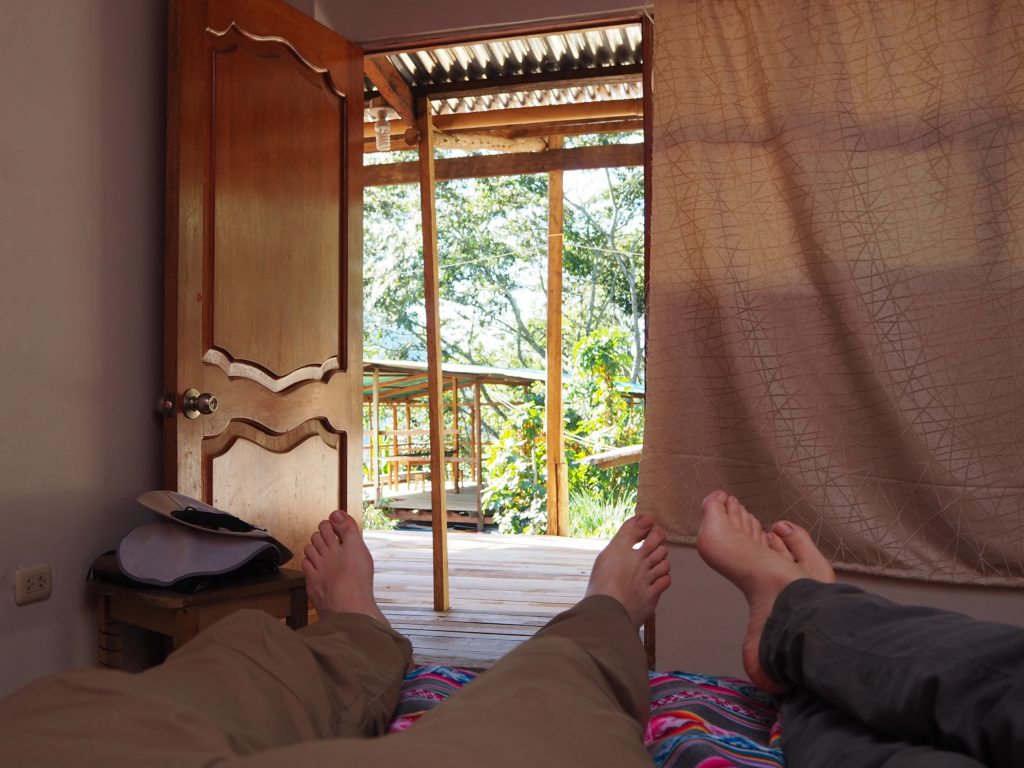
Day 4: Lucmabamba – Llaqtapata – Hidroeléctrica – Aguascalientes
At 3.21h, the rooster that lived next to our room started crowing and didn’t stop. There was not a single ray of light in the sky, so we couldn’t understand what was wrong with that animal, but we slept OK despite of that.
We started walking on our fourth day of the Salkantay Trek without a guide at 6.30h after an amazing breakfast. The first stop of the day was a swing on the way to Llaqtapata viewpoint. We arrived there at 9.30h, after a generally easy climb that combined demanding and relaxed stages. We entertained ourselves for a few minutes swinging and taking pictures.
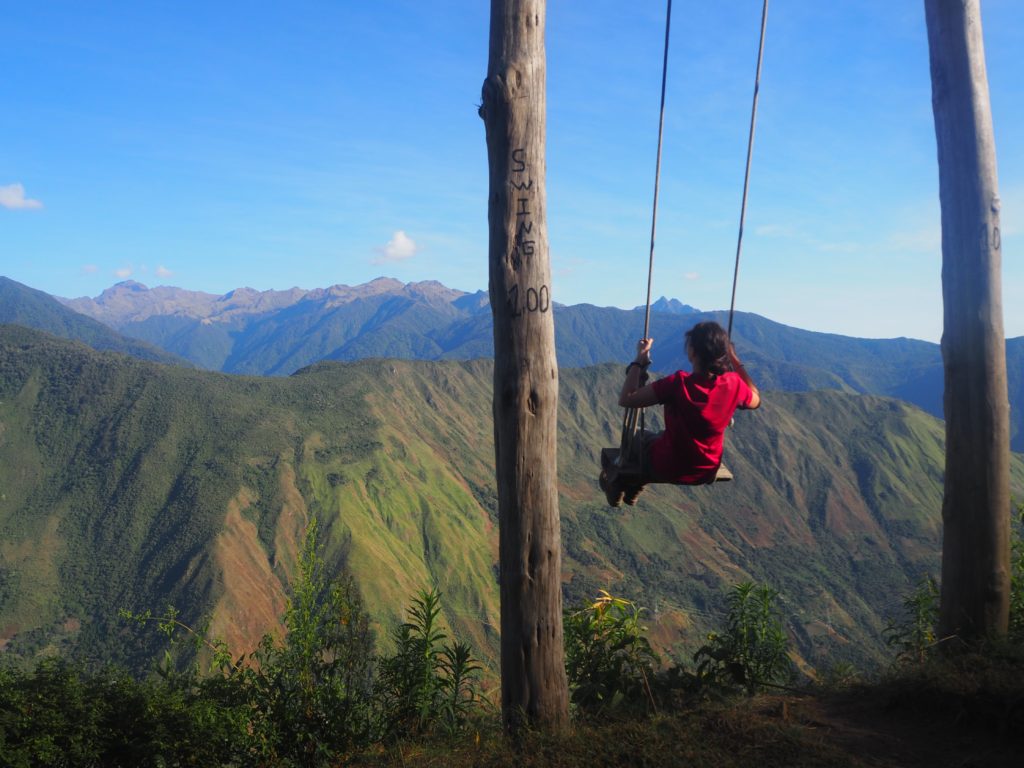
The short climb from the swing to Llaqtapata viewpoint, where we arrived at 10h, was a little more demanding. There you have views over the whole range of mountains, including the Machu Picchu, so it’s also one of the most spectacular landscapes of the trek.

The descend from Llaqtapata to Hidroeléctrica was long, hot and infernal again. The first stage was easy and fun until you found the zigzags, which descended very steep and lasted for a lot of time. It was not friendly on the knees. After the zigzags, you walked about 2 km / 1.2 mi in the flat road under the noon sun.
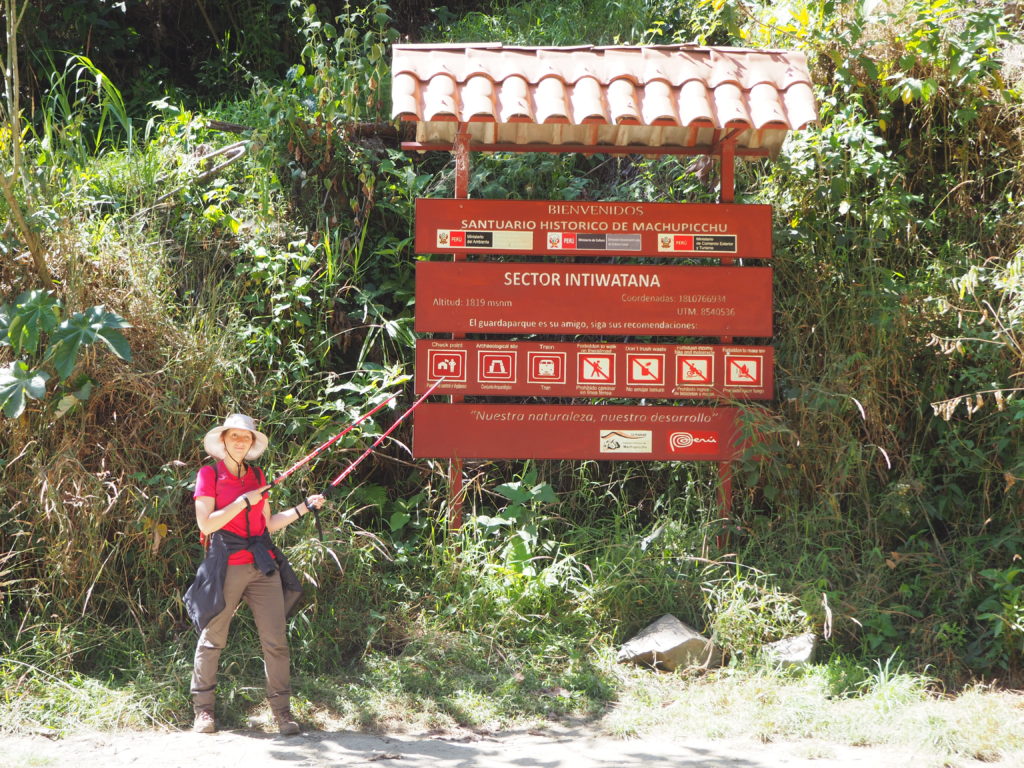
Our main problem in this descend and the road, apart from its steepness, was the sun and the lack of water. The shadows of the trees ended almost at the beginning of the zigzag. Also, from Llaqtapata and right before arriving to Hidroeléctrica, there was nowhere were you could refill nor buy some water. You better remember to fill your bottle up before starting this stage!
We left Hidroeléctrica at 13h . The first 10 minutes you will be following an intense climb through the forest. After that, you will find yourself again in the train rails, which you will follow until you arrive. This path is mildly ascending and easy.
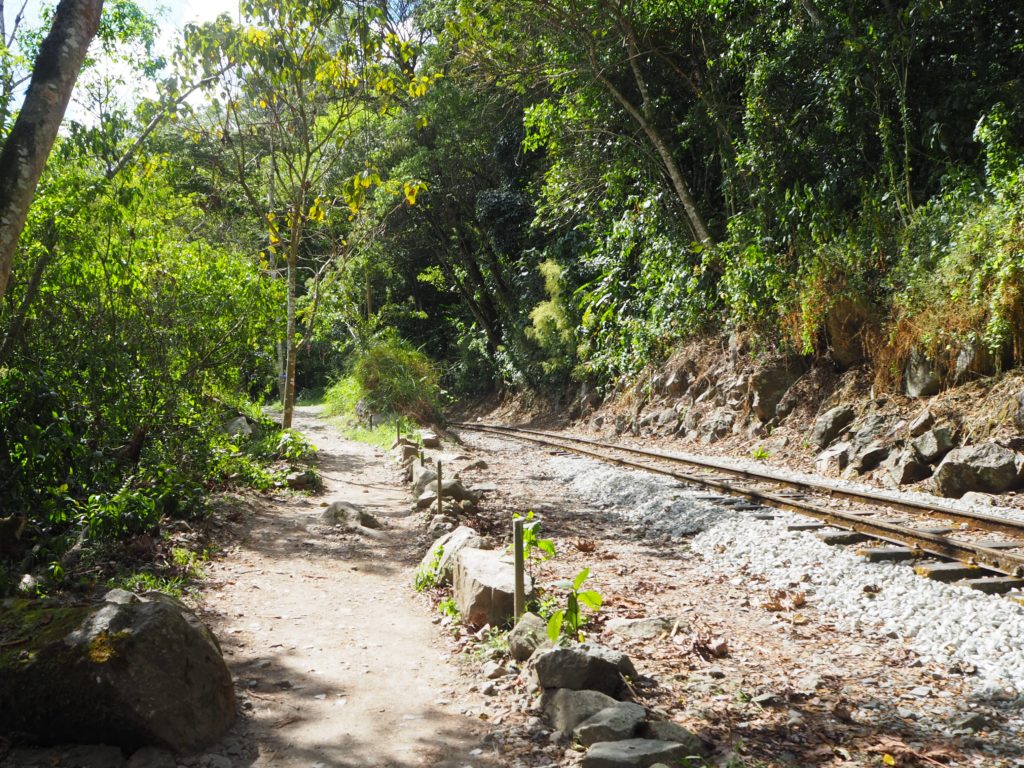
We arrived at Mandor (formerly Gea Lodge) , the hostel were we slept, at 14.45h. The room was not the best: we had a beehive next to our window. However, they had a nice terrace that overlooked the river. We spent most of the afternoon there tending to our muscles. We had dinner at Mamá Angélica (our only option) and went to sleep really early. An exciting adventure was waiting for us the following day!
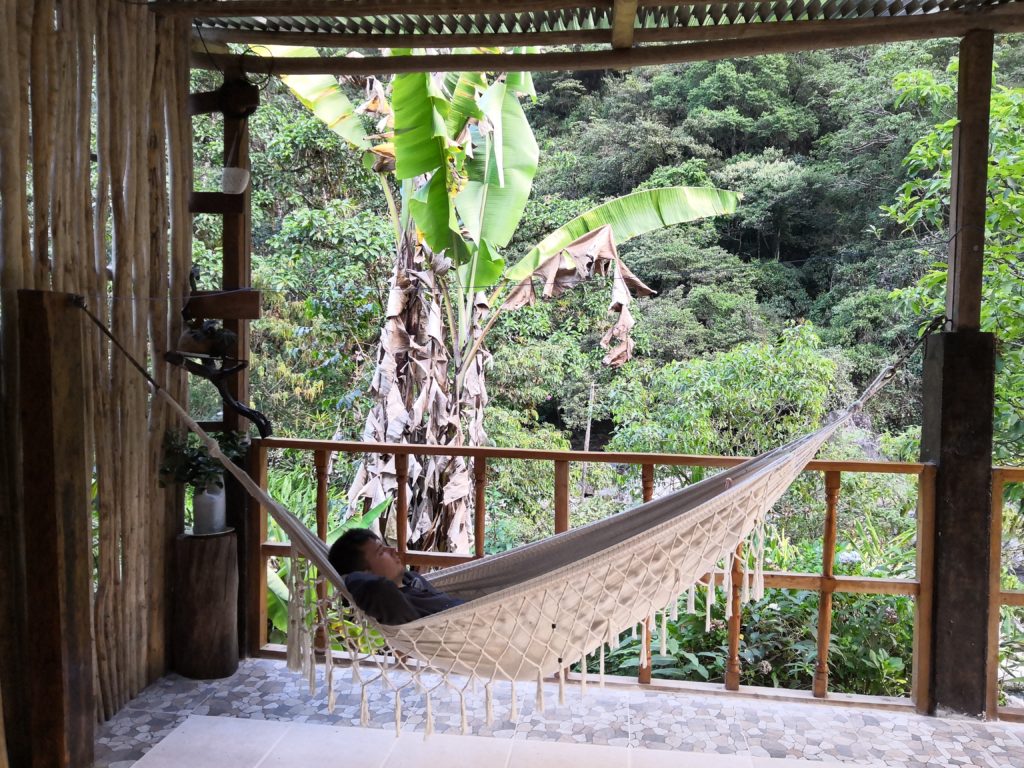
Day 5: Machu Picchu – Machu Picchu Mountain – return to Hidroeléctrica and Cusco
On the fifth day of the Salkantay Trek without a guide we started walking at 4.15h. We were very light having left our backpack in the hostel, which was an improvement! However, it was still dark night, so we relied on our frontal lights to check the path.
We arrived to the queue to the Machu Picchu entrance at 4.45h and were among the first ones there. The entrance opened at 5h and at 5.10h we passed the control. Then, we started the race to the Machu Picchu citadel trying to beat the buses that were already arriving. Our goal was to see the archaeological site without the massive amount of tourists that would arrive.
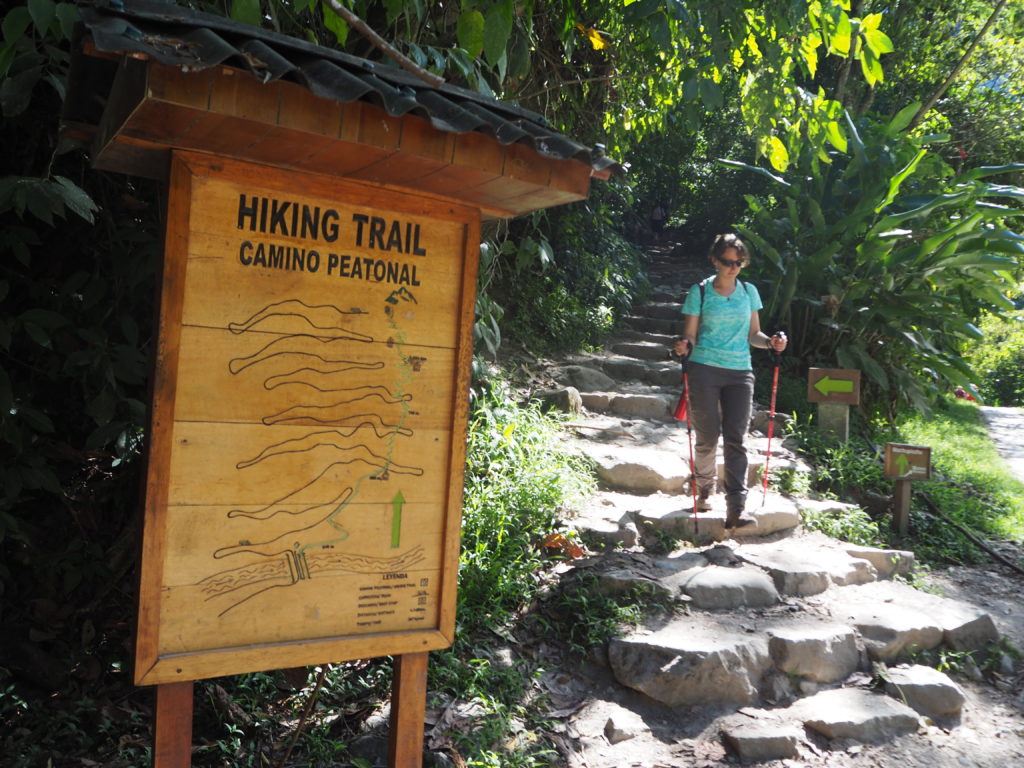
We were at the second control to Machu Picchu at 6.15h, exhausted and kind of overwhelmed after a very demanding climb filled with steps and still at night. There, we found that if you wanted to hire a guide you needed to do that before accessing the citadel. As our ticket was also for Machu Picchu mountain, we could first go to the mountain and then enter the citadel again with a guide. We guess this will also be possible if the ticket you have is for Huayna Picchu.
We also found that our trekking poles , in which we relied heavily after four days of trekking, had to be left in the lockers . Apparently, to protect the runes, they are only allowed for people over 65yo and with a certified medical condition. Even then, they need to wear a plastic cover.
When purchasing our tickets for Machu Picchu, we decided to climb Machu Picchu Mountain instead of Huayna Picchu because it is higher. And, you know, the higher the better. We didn’t factor that we would be extremely tired from the previous days of trekking, but still we don’t regret this decision.
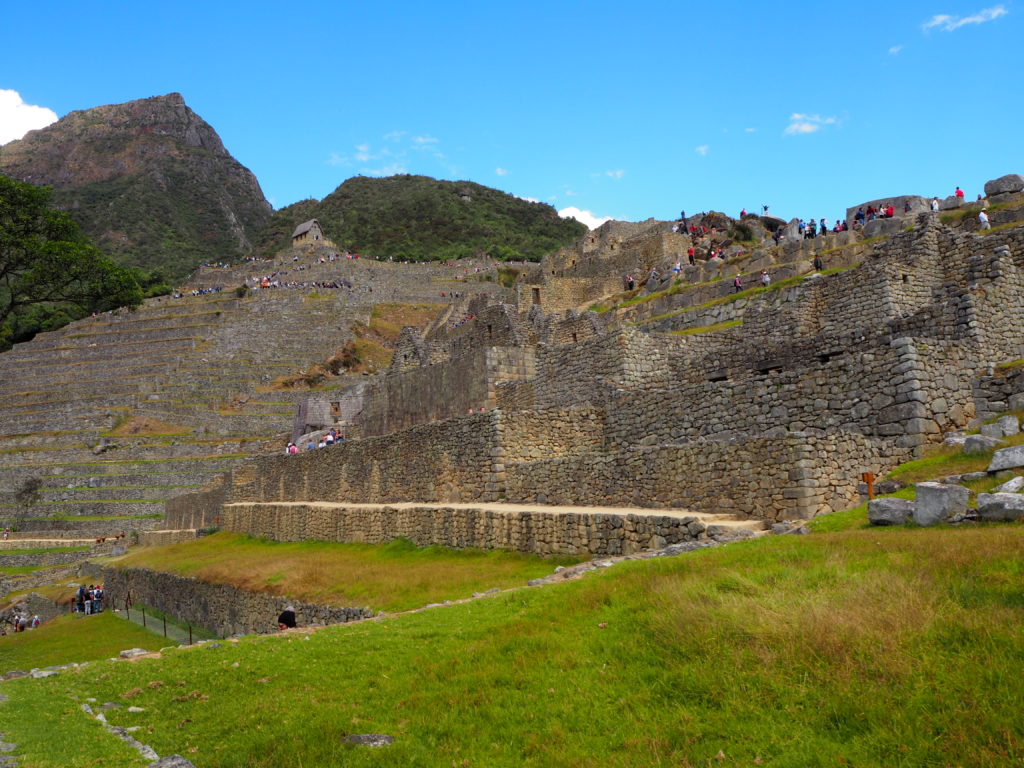
We checked at the Machu Picchu Mountain control around 7h, where we could stay for four hours. Desperately missing our trekking poles, we started the exhausting and difficult 2h climb. It was very steep with irregular and high steps. After four days of trekking, our legs almost couldn’t carry us. But nevertheless we arrived at the top, having left behind a few people that turned down because of the difficulty.
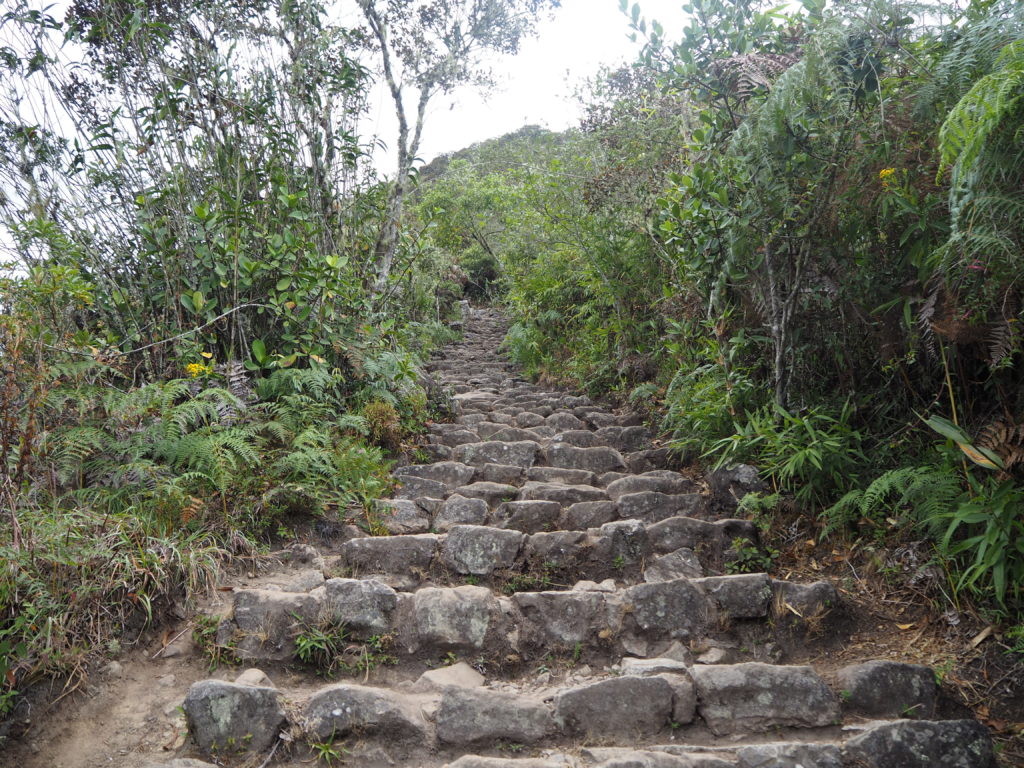
After resting for a while, we took the mandatory pictures and raced our way down in 40 minutes. Once at the citadel , we were lucky to find a guide who had just started the tour. We joined the group for 20 PEN per person, without having to go outside to look for a guide and enter again.
We truly recommend hiring a guide to be able to appreciate all the history and details of Machu Picchu. For us, the two-hour tour was extremely interesting but also exhausting. At this point, even standing still listening to the explanations of the guide was a huge effort.
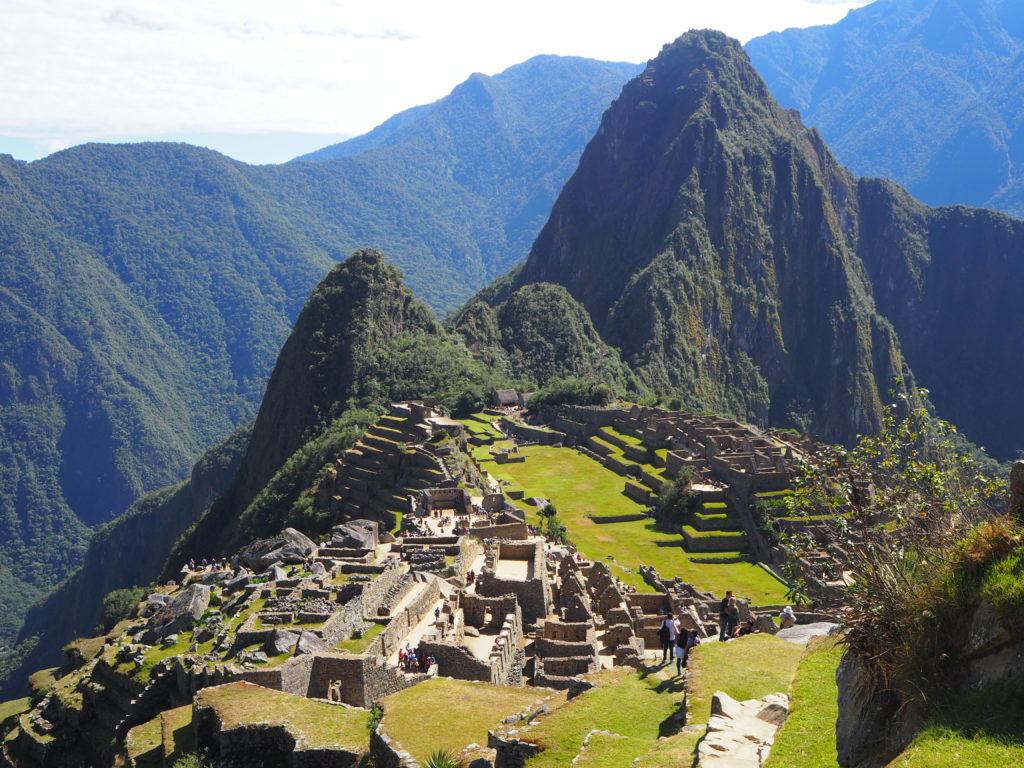
The guide was the one who told us that the last direct bus from Hidroeléctrica to Cusco left at 16h. Otherwise we would need to stop at Santa Teresa and then again at Santa María, and we would arrive to Cusco very late at night. It was already 12.45h.
With this new information and no energy left, we started racing down the stairs to the first Machu Picchu entrance . Once at the train rails, we stopped for a couple of minutes to eat a sandwich and have a sugary drink to try to regain some strength. It greatly helped.

We were at our hostel at 14.10h, picked up our backpack and at 14.40h we were back on the train rail, walking non-stop to Hidroeléctrica . It was not the best moment for us, because we had a very close deadline, 7 km / 4.3 mi to go, and we were exhausted. Mind over body, as they say it, so we kept walking. We arrived to Hidroeléctrica at 15.58h and were able to secure passages in the last direct bus to Cusco for 35 PEN per person that left a minute after we arrived.
The first part of the road until you leave the mountain range is interesting, so to speak. The road is very narrow and irregular, drivers tend to drive faster than they should and you have mountain at your left and a very high cliff on your right. It was without a doubt the most dangerous part of the Salkantay Trek. The rest of the drive, using more conventional roads, is only long and boring.
We arrived at Cusco at 21.30h and had enough energy only to take a shower and go to sleep without having dinner.
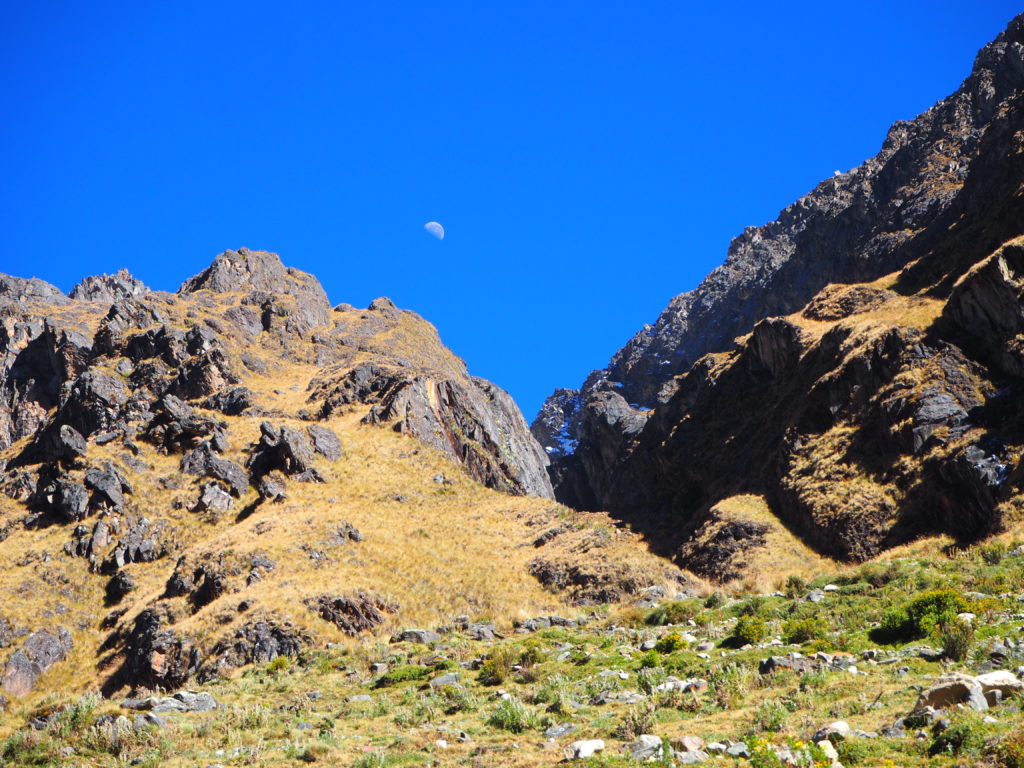
We have been giving information about prices during the whole post, however, we have also compiled all the costs we had so you can get an idea of how much will you be spending for each category:
In case it is easier for you, here you will find these same amounts in Peruvian soles (PEN):
Note: the cost of the Machu Picchu tickets are not included in the totals of this table
Was this post useful for you? Please let me know and feel free to ask any question in the comments section! You can also support my work and Buy Me A Coffe . I will be immensely happy 🙂
Buy me a coffee
Also, if you want to have some additional useful information about the difficulty of the trek and what you need to assess to determine if you are prepared to do it, how to prepare the track and what tools you can use to navigate the route, information on altitude sickness and how to minimise its effects, safety along the route and what does your backpack need to contain, check my other post ‘ Salkantay Trek on your own: 5 essentials to prepare ‘.
Day-by-day Itinerary Machu Picchu Nature Peru Salkantay South America Trekking
Salkantay Trek Without a Tour (or Tent)
Updated: Oct 16, 2022
Hiking the Salkantay Trek & Machu Picchu by Yourself for 5 days

Looking at hiking the Salkantay Trek (with Machu Picchu) without a tour or tent for 5 days but aren't sure where to start? I've put together a complete guide with costs*, accommodation, and everything you should know before starting.
*Disclaimer: cost will depend on accommodation, optional activities, the food you purchase, and the exchange rate.
Table of Contents
1. quick glance, 2. how to get salkantay trek.
3. Trail Information
4. 5-Day Itinerary
Day 1: cusco to soraypampa to laguna humantay, day 2: soraypampa to collpapampa, day 3: collpapampa to lucmabamba, day 4: lucmabamba to aguas calientes, day 5: machu picchu, 5. basic precautions for the salkantay trek without a tour.

Time: 5 days, 4 nights
Distance: ~68km
Trail: Point to point
Difficulty : hard (due to elevation and distance)
What to bring: 2L water, snacks, electrolytes, an extra layer (windy/cool up top), and hiking poles.
Elevation: Starting at 3827m, reaching the highest at 4600m
Other information: No internet for most of the hike, can rent mules to go up/down
Getting to Soraypampa is quite easy and straightforward from Cusco:
Cusco-Mollepata : take a van from the corner of Av. Ayahuasca and Av. Apurimac , before 5:30 am (road conditions and weather can make the trip longer than expected), takes ~2 hrs. The van leaves when full (11 people).
Mollepata-Soraypampa : pay the entrance fee and wait for a taxi or ask a tour van to catch a ride. A taxi can be split between 4 people (wait and see if others that will join) and takes ~1 hr.
You will get dropped off at Refugio Nacho (with all the tour buses) where the trail starts.
Van from Cusco to Mollepata; entrance ticket for Mollepata
3. Trail Information for Salkantay Trek
**Due to the high elevation (over 4200m), it is recommended to stay in Cusco for a few days to acclimatize. Before leaving Cusco, chew some coca leaves or drink tea to help with the altitude. Also, chew/drink some before starting Day 2 up to Salkantay Pass.
Salkantay is a long, hard hike that goes through various altitudes where you will be hiking long distances and long days. Proper rest, hydration, and fuel are needed. You need to realistically look at your fitness level to determine if you can do the entire 68-74km.
There are options to rent mules if the elevation is too much. Check with your guesthouse. There are shops along the way for snacks but I would highly recommend you bring enough to go 4-5 hours without seeing one.
YOU MIGHT ALSO LIKE:
10 tips for hiking in cooler weather.
Distance: ~7km | Time: 3-6 hours | Highest Elevation: 4283 (~450 elevation gain) | Cost: S/.138 ($35.79 USD)

Transportation : from Cusco, take the 11-person van to Mollepata where you will have to take a taxi to Soraypampa (you will get dropped off at Refugio Nacho) to start the trail.
Taxi to Van: S/. 10
Cusco-Mollepata van: S/. 20
Mollepata-Soraypampa taxi: S/. 80 (but can be split between 4 people. We had 3 so it was S/. 27/person)
Mollepata Entrance Ticket: S/. 20
Laguna Humantay : I have written a whole blog about Laguna Humantay but here are a few key points:
Morning tour groups arrive between 8-9:30 am and are gone by noon. Afternoon tour groups start to arrive around 3 pm. The best time to visit Laguna Humantay is between 12-3 pm.
The best time to start hiking is around 10 am (if you want to beat the crowds).
Takes about 4-6 hours to complete (enjoying the views at the top).
There is a little shop at the top that sells snacks, beer, and drinks.
There are mules you can rent if the altitude is too much.
Views of Laguna Humanaty
Accommodation : There are a lot of options for places to stay, depending on what you would like to pay. We stayed at Refugio Nachos in a twin room with a shared bathroom (no hot water). There are 12 rooms with the option of a private bathroom with hot water. They also provided all the meals at an extra cost (which are huge portions). They were nice enough to even make us a breakfast and lunch sandwich for that day. They do have wifi but you need to pay for it (S/. 10 to use, S/. 5 if staying). The cost depends if you are staying there or not.
NOTE : there are limited plug-ins (we used a candle for our light in our room) so charge your things when you can.
Twin Room: S/. 60 twin room (S/.30/person)
Breakfast & lunch sandwich: S/. 8 each
Supper: S/. 15
It does get chilly at night here, make sure you have the appropriate layers especially if you decide to camp.
Inside Refugio Nacho; hot coffee upon arrival
Snacks and supper at Refugio Nacho
Distance: 22km | Time: 8-10 hours | Highest Elevation: 4620 (~660 elevation gain) | Cost: S/.77 ($19.97 USD)

You will want to start early , no later than 6 am as you have a long, hard hike ahead of you. This is where you will be going through the Salkantay Pass, with an elevation of 4600m . I would recommend chewing or sipping some coca leaves before you leave.
There are only a few shops before the Salkantay Pass. When you arrive at Salkantaypampa, this is the last shop for the next 4 hours!
Meals : you will get a very filling breakfast at Refugio Nachos that should last you till the top of the pass. If you want a lunch option, they will make you a takeaway sandwich.
Breakfast: S/.15
Lunch: S/. 10
Salkantay Pass: this will be the hardest part of the day. Not only are you climbing up over 600m, but you are also going to an elevation of 4600 m. Take your time and remember to hydrate. It will take anywhere from 3-5 hours. Enjoy your lunch here and the views.
Walking to Salkantay Pass; at the highest point of the hike
Accommodation : once you have climbed to the highest point, you now have to climb down! It is a gradual down with amazing scenery, going from the snow-capped mountains to the beginning of the jungle. This will take you around 4-5 hours to get to Challway or Collpapampa (there are little towns between to buy snacks/water) but the last 3 km will seem to take forever! These two towns are 1km apart and the majority of people stay in Challway. We opted for Collpapmpa (Camping el Mirador-last place on the right before the bend to leave town) and found a triple room with wifi, supper, and a hot shower but Collpapmpa seems more for people who are camping.
Room with Supper: S/.50
Extra: S/.2 juice box

Supper and room at Camping el Mirador
DAY TRIP TO LAGUNA HUMANTAY WITHOUT A TOUR
Distance: ~17km | Time: 4-6 hours | Highest Elevation: 2900 m (~660 elevation lost) | Cost: S/.150 ($38.90 USD)

You don't have to start as early today but you'll still be putting in the hours. There are 2 options for the trail: 1. You can take the actual trail or 2. You can follow the road. We were accidentally given the wrong instructions and took the road. I'm not sure if that was a blessing in disguise as the others said the trail was really hard with a lot of up-and-down sections. The road is a gradual decline which I think is what we needed after yesterday!
There is a shop called Grenadillas where you can get fresh juice, and snacks or enjoy the hammocks.
Breakfast: S/. 8
Juice at Grenadillas: S/. 5
NOTE : there are a lot of bugs that bite. I highly recommend wearing pants and a long sleeve and bringing bug spray.
Accommodation : we arrived at Lucmabamba and hit the jackpot for accommodation! After what we stayed in last night and for the price, this room seemed like a 5-star! Café Viamonte-Inca Inspired Lodge & Camping is a very up-to-date place with 4 rooms (1 double, 1 twin, and 2 triple) that comes with wifi, hot water, and a towel (free). Roger and his wife are some of the nicest people I have met! She even let us rinse out our smelly shirts, arranged a taxi for us to go to thermals in Santa Teresa, and even let us do a coffee tour that night (Roger's dad owns a coffee farm and it is S/.10/person).
Twin room: S/. 60 (includes supper and breakfast)
Café Viamonte-Inca Inspired Lodge & Camping
Santa Teresa Thermals:

We arrived around noon at Lucmabamba and decided to hit up the thermals to kill some time (and soak our bodies). You will need to take a taxi and the price is split between however many are in the vehicle. The driver will also wait for you there. There are a TON of BUGS ! Our bug spray seemed not to work, so wear long sleeves and pants. At the thermals, there are a few local restaurants to eat at and if you don't have a bathing suit or towel, you can rent one.
Lunch: S/. 15
Beer: S/. 8
Thermals Ticket: S/.10
Taxi S/. 40/way
At night we did a coffee tour and it has to be one of the best experiences I have done! Roger's parents are amazing people and are very passionate about what they do! They show you all the steps of how they collect their coffee, even letting you participate. They sell coffee beans, ground coffee, and amazing coffee liquor (that I had to buy). Roger also has a honey farm and you can purchase his honey there.
Coffee tour at Café Viamonte
Distance: 22 km | Time: 8-10 hours | Highest Elevation: 2800 m (~800 elevation gain) | Cost: S/. 201 ($50.66 USD)

The last day of the hike but also another long one! Eat the hearty breakfast they serve you as you will climb up 700m quickly and descend just as quickly. Bring enough water as the weather is warmer since you're entering the jungle. There are a couple of shops along the way but I would highly recommend stopping at the one just before you reach the top (and after the swing). Enjoy freshly squeezed orange juice with a view.
Freshly squeezed orange juice: S/. 5
Snickers: S/. 7

Once you reach Hidroelectrica, you'll need to sign in and there are many shops to buy snacks at or restaurants to eat at. From Hidroelectrica to Aguas Calientes, it is 10km walking along a rail track and takes about 3 hrs. The rail track is very active , so keep a watch out for trains. This was probably the worse part of the entire trek, I was tired, my feet hurt and I just wanted to be done. It was a long 10kms! Luckily there are a few shops along the way that even serve ice cream!
Gatorade: S/. 5
Ice cream: S/. 5
Accommodation : I've never been so happy to see Aguas Calientes, but once you arrive there, you have unlimited hotel options. Do note that Aguas Calientes is a bit more expensive than other places in Peru. I stayed in Casa Machu Picchu Hostel in a dorm room that had wifi and a hot shower (this is next to the train station and if your room is facing that side, it can be quite loud. My room was facing the river so I don't hear much).
Dorm: S/. 29
Supper: S/. 25
Beer: S/. 15
After walking 68km, it was a pretty early night, and also I had to get up early to go to Machu Picchu. For bus tickets up to Machu Picchu (or you can walk the 10km up), you can buy them the day before or the day off. The ticket office is open from 5 am-9 pm. You will need your passport and they also take credit cards. You can also buy bus tickets at Machu Picchu if you walked up or didn't buy a return.
Bus return to Machu Picchu: S/. 95 ($ 24 USD)*price is given in USD
Cost: S/. 596 ($150.22 USD)

**Tickets for Machu Picchu usually need to be purchased weeks to months in advance . You cannot show up and buy a ticket!** When you purchase your ticket for Machu Picchu, you will need to pick a time and a circuit route. The time on your ticket is the time you need to enter by.
The first bus leaves at 5:30 am but don't worry, they have numerous buses leaving at that time. If you're walking up, Machu Picchu doesn't open until 6 am. If you want a guide, there are many of them waiting at the bus stop or even at Machu Picchu. Guides are a set price, so if you're by yourself, try to find others to split the cost.
If your ticket includes a mountain, do the mountain first before doing the circuit (usually there's a time you need to enter the mountain by).
Machu Picchu Entrance Ticket: S/. 208
Guide: S/. 250 (split between 3 people: S/.80)
Lunch: S/. 25
Views from Machu Picchu Mountain (Circuit 3)

NOTE : you can visit Machu Picchu and get the 3 pm train on the same day. This is what most people who are going back to Cusco (there are also cheaper transport options back). There are 2 train stations in Cusco: Poroy (30 mins from Cusco) and San Pedro (downtown area). Look closely when purchasing your ticket.
Train to Cusco (Poroy): S/. 273 ($69 USD)* price is in USD
Taxi to Cusco: S/. 40 (split by total in the vehicle, S/. 10)
TOTAL COST OF 5D/4N SALKANTY TREK: S/. 1162 ($293 USD)
Per day: S/. 232 ($58.48 USD)
The total cost of this tour was S/. 1162 or $293 USD (S/. 232 or $58.48/day). You can do this cheaper by bringing your own food, and camping equipment, not getting a guide, hiking up to Machu Picchu, and choosing a cheaper transport option back to Cusco.

The Salkantay Trek reaches high elevations and if you're going to do it on your own, here are a couple of precautions to take (here's the whole list ).
1. Be realistic about your fitness especially if you're going to hike it all without help.
2. The highest elevation you will reach is 4600m, you should acclimatize in Cusco first.
3. Drink or chew coca leaves BEFORE you feel the altitude.
4. Hydrate, nutrition, and rest are ALL important!
5. It is not a race, ascend gradually.
6. Know the symptoms of altitude sickness.
There is no internet for most of the hike.
Bring an extra layer as it is cooler, and windier at the top.
Always have 2L of water. There are shops along the way to refill but it can be hours between.
Bring hiking poles to help with the incline/decline.
Always wear sunscreen (bring a hat/sunglasses) and bring bug spray.
Wear proper shoes, it is a rocky trail.
If you have sweaty feet, change your socks during the day or you will get blisters.
Bring a towel or you might be charged for it at the accommodations.
If you plan on going to the thermals, you can rent a bathing suit and towel there.
Bring water tablets to reduce the cost of buying bottled water.
Bring electrolytes (you can buy them at Tatoo Adventure Gear in Cusco). I found they helped a lot.
If you liked this post about the Salkantay Trek, pin it on Pinterest!
5 day, 4 night salkantay trek without a tour or tent.
- Peru Hiking
Related Posts
10 Tips for Hiking in Hot Weather
Day Trip to Laguna Humantay without a Tour

- PERU: +51 992 509 095
- SALKANTAY TREKS TOURS
- Reviews on TripAdvisor
- Inca Trail Availaility
- +51 992 509 095
- Inca Trail 4 Days to Machu Picchu
- Salkantay Trek 5 Days
- Salkantay Trek And Short Inca Trail To Machu Picchu 5 Days
- Salkantay and Inca Trail 7 Days to Machu Picchu
- Salkantay Trek 4 Days
- Salkantay Trek 5 days to Machu Picchu
- Machu Picchu Day Tours – Trip from Cusco
- Choquequirao Trek 4 Days
- Choquequirao Trek 5 Days
- Choquequirao Trek To Machu Picchu 6 Days
- Choquequirao Trek To Machu Picchu 7 Days
- The Classic Choquequirao Trek To Machu Picchu 9 Days
- Lares Treks
- Ausangate Treks
- Inca Jungle Treks
- Huchuy Qosqo Treks
- Ancascocha Treks
- Sacred Valley 1 Day
- Maras Moray Tour
- Qeswachaca Bridge One Day Tour
- Humantay Lake 1 Day
- Rainbow Mountain Tour 1 Day
- Palccoyo Rainbow Mountain
- Pallay Punchu Trek 1 Day
- Amazon Rainforest

Salkantay trek without guide
One of the most impressive multi-day treks in Peru is the Salkantay Path. This trail is often considered a more adventurous and time-consuming substitute for the standard Inca Trail which takes four days to complete.
The number of travel operators offering excursions along the Salkantay Trek increases annually in step with the trail’s rising profile. Taking part in a guided tour has many advantages. On the other hand, seasoned backpackers could enjoy a more challenging trip. As this route does not necessitate a permit, planning a Salkantay trek is considerably less of a hassle.
To help you plan your solo trek on the Salkantay , I have prepared this post and compiled this compilation of information, recommendations, and guidance. As long as you put some time and effort into planning, the Salkantay Trek may be accomplished without a guide.
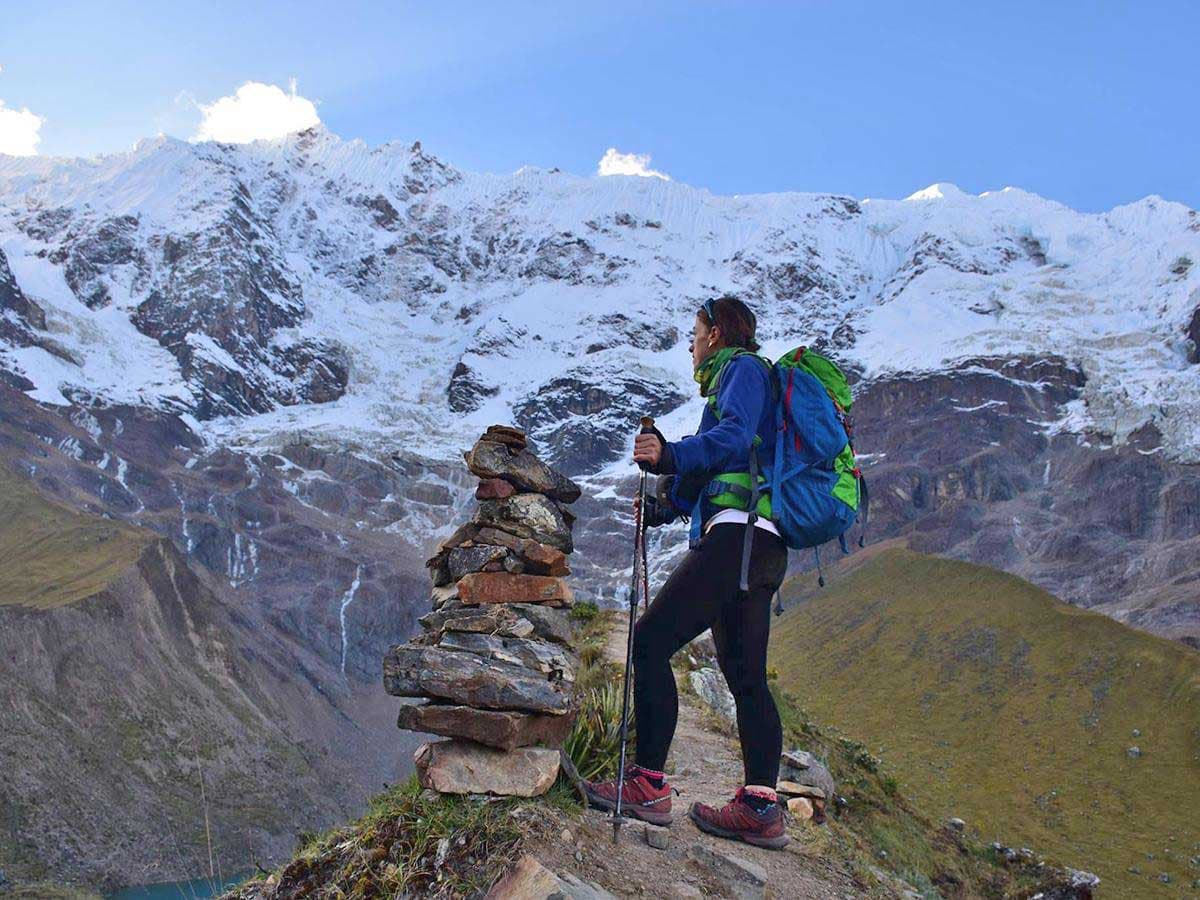
Is it possible to hike the Salkantay Trek independently?
That is a question to which the answer is unquestionably positive . The path is unambiguous, and the locals are happy to offer assistance. Anywhere you go, you can buy food and find a place to sleep. This implies that you can go on this journey without signing up for a guided trip with very little advance preparation.
It’s impossible to move through Cusco without coming across a travel agency advertising the Salkantay Hike. You may be informed that it is unsafe or too far away to trek alone if you inquire at these offices. No doubt about it! It is not in the interest of tour companies to market their most popular activity as something that can be done alone.
Learning basic conversational Spanish will serve you well . The ability to communicate in the native tongue will (quite literally) open doors for you while you are searching for lodging, directions, or a place to eat.
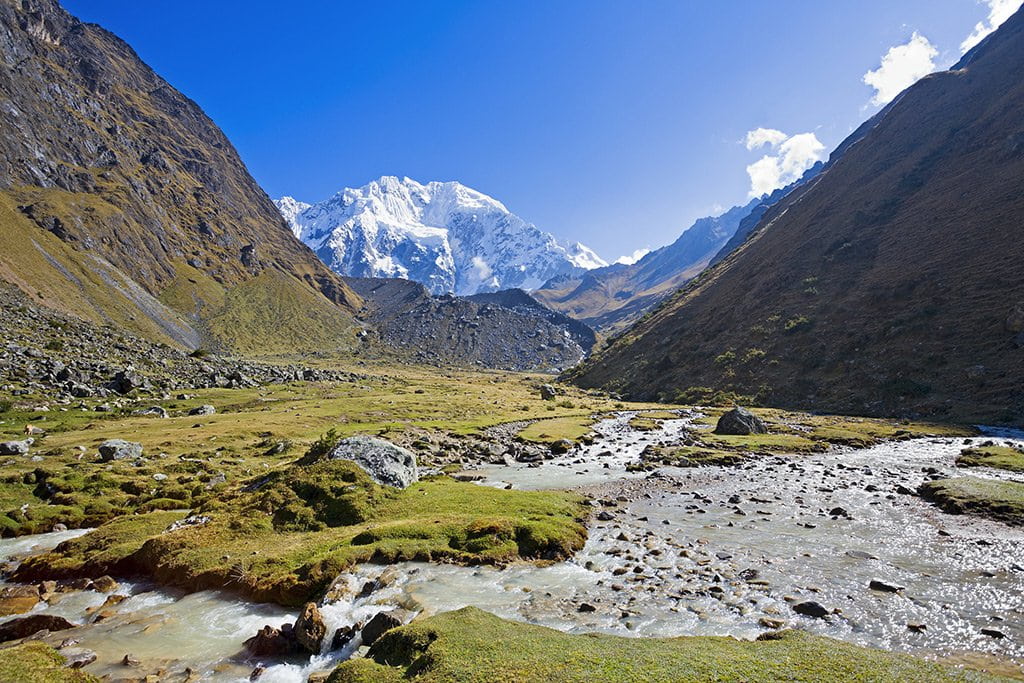
How Risky Is It to Hike the Salkantay Trail Alone?
I f you’re worried about walking alone, don’t be. The amenities along the trail have expanded in tandem with the trail’s rising popularity. Only on a rare occasion will you travel for more than three hours without coming across a rest stop replete with a convenience store and restrooms.
A few other hikers, including a solitary female traveler like myself, were encountered during my time on the Salkantay trail. These hikers, all of whom were without guides, had no complaints. Having the option to get up whenever they pleased and proceed with their day as they saw fit was highly valued by the vast majority.
The trail is also frequently shared by other hikers. Get yourself into a jam, and help won’t be far away. Include your regular medication and a first aid kit with the basics in your packing.
you can also see
salkantay trek 7 days
salkantay trek 5 days
salkantay trek 4 days
Where do I sleep while trekking the Salkantay?
The thought of carrying a tent up the mountainside put me off of solo hiking the Salkantay for a while. On the Salkantay Trek, however, you can choose from a wide variety of lodgings.
The destination of each day will be a predetermined camp or settlement. Getting a place to sleep at night is quite simple. In most cases, you’ll be able to find a homestay or a cheap dorm room in one of the nearby cities. You can also stay in campgrounds that provide tents, mattresses, and sleeping bags. Glass domes are one of the more opulent options available in some cities.
The options vary in price. You might have to do some exploring to find a spot that isn’t reserved by a tour group. While out for a stroll in Santa Theresa on my third night of the Salkantay Trek, a kind local gave me a place to stay and a beer. Finding a bed is as simple as looking for one.
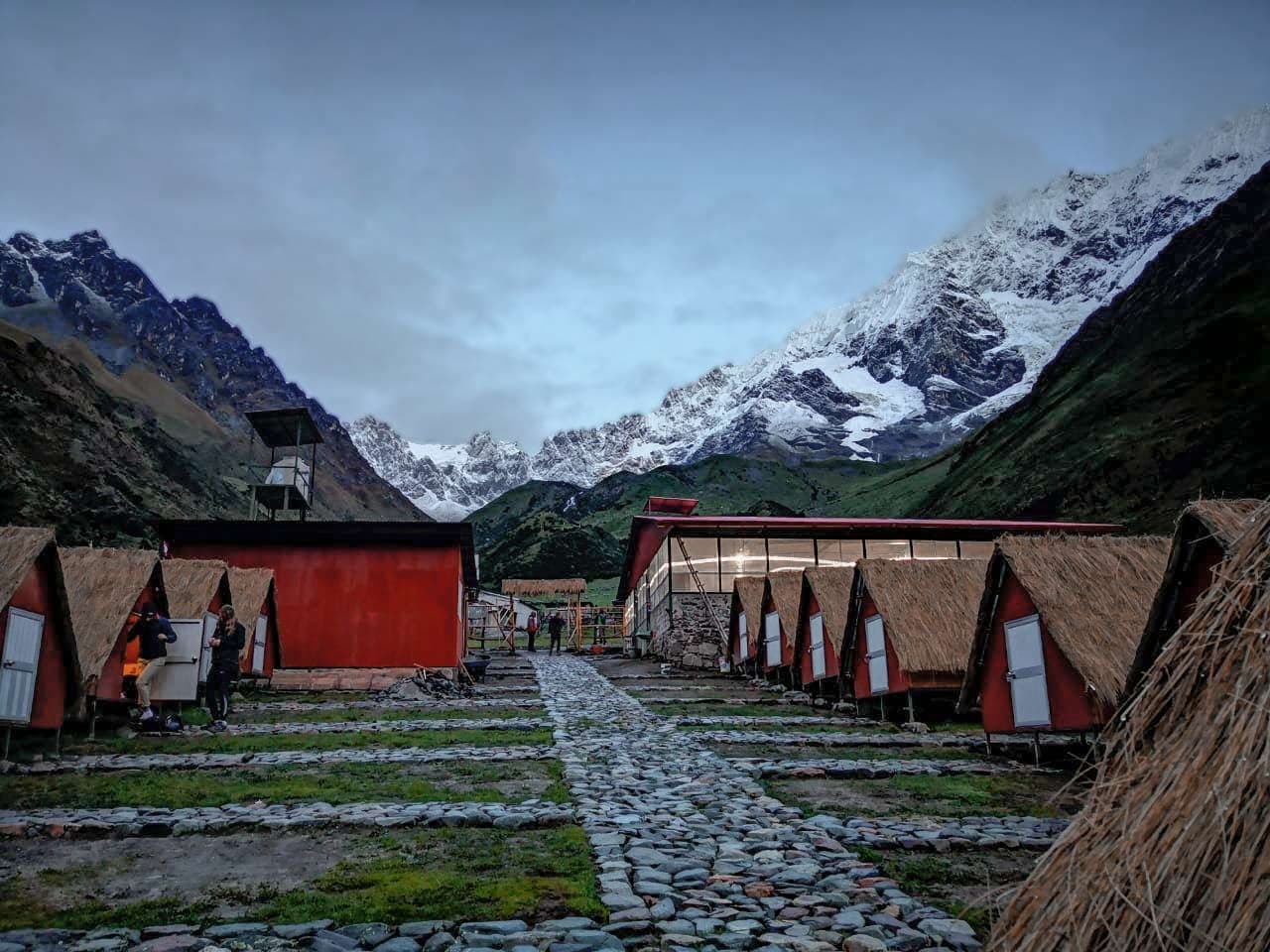
When I go on the Salkantay trip by myself, what should I eat?
The good news is that you won’t have to worry about bringing enough food for the next five days on this trek. There are dining options in the towns and campgrounds spread out along the trail.
Almost every meal will include options for purchase, such as a plate of food or a sandwich. Most hostels and guesthouses provide meal packages for an additional fee, so long as you aren’t too particular about where you eat.
Before you head out on the path, it’s a good idea to stock up on food. Costs are somewhat higher in areas frequented by trekkers. At the markets of Cusco, you can get an incredible variety of dried fruit and nuts at very reasonable prices. There is the largest selection of trail-friendly groceries at San Pedro Market.
Kiwi bars are a great lightweight option for hiking food. These cereal bars may be found at any convenience store or supermarket in the Cusco area. Each one fetches a price of about 1 sole ($0.25c!).
You can be a true outdoorsman (or outdoorswoman) and prepare your own meals. In such a circumstance, you’ll require some sort of culinary utensils. This is a selection of high-quality camping equipment and camping gas stoves that you may bring on your solo Salkantay Trek.
What does it take to go on the Salkantay Trek by yourself in terms of money?
You may tackle the Salkantay Trek on your own for about $175-$200. Meals, lodging, and transportation to and from Machu Picchu are all included. The cost is conditional on the accommodation and food chosen.
It will also make a difference in price if you opt to rent hiking and camping gear. Sharing hiking expenses is easier if you’re going with a friend or significant other.
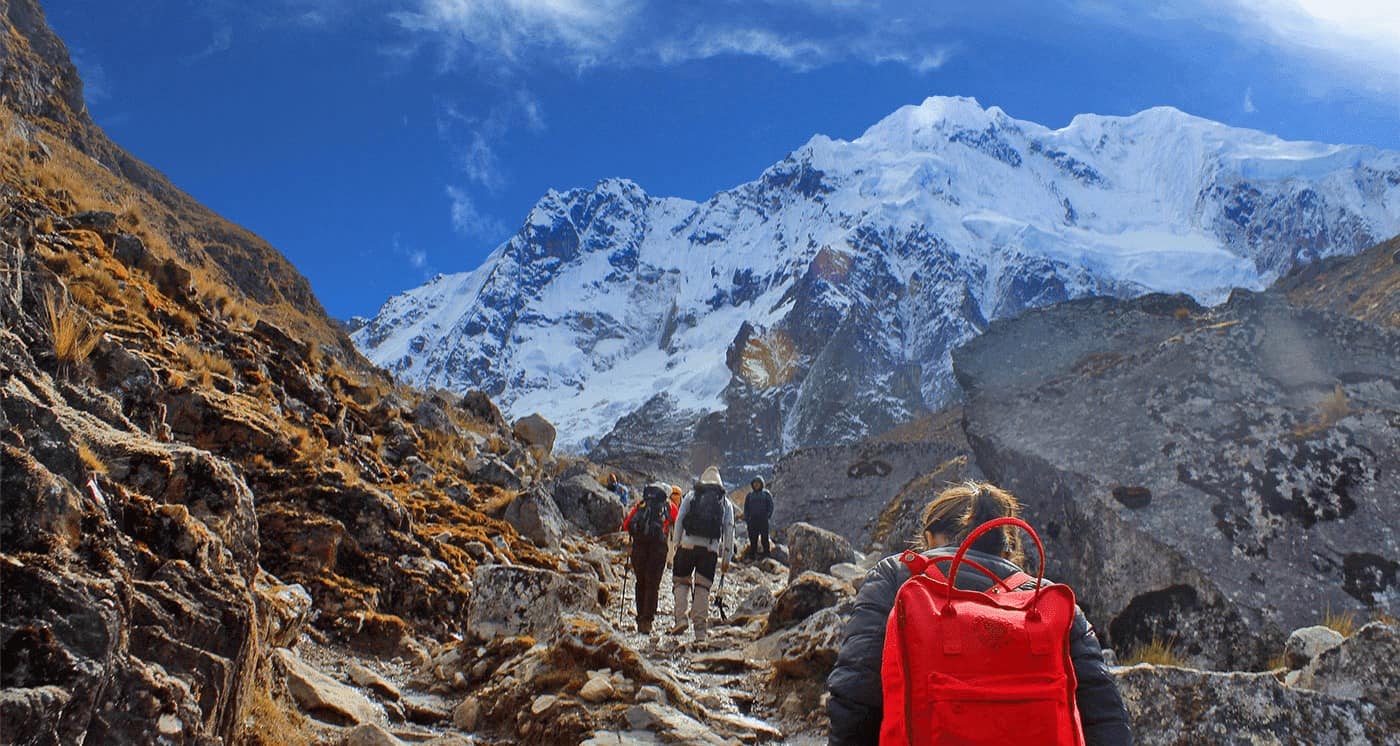
How to Backpack Like a Pro for Your Alone Salkantay Trip
If you plan on hiking the Salkantay Trail on your own, you’ll have to bring everything you need with you. There are places to stay along the journey, but you might find it more convenient to pack a tent. Only do this if you intend to camp in a less populated area.
Don’t over-compare and take only the essentials with you on your trip. You shouldn’t need two pairs of pants for hiking, for instance.
Food and drinks can be purchased at rest stops. Make sure you have some emergency food supplies like ramen noodles, trail mix, and energy bars.
Bringing more than 15 kilograms of gear will greatly increase the difficulty of the hike. In Mollepata, you can hire the services of an arriero (horseman) if your luggage is too big to handle. There is a daily fee of 30 to 40 Soles for each mule, plus another 30 to 40 Soles for the workers.
Moving From Mollepata to Soraypampa on Day 1 (13 km )
It takes about three hours by minibus to reach Mollepata from Cusco. The start of the Salkantay Trail is in Challacancha , from where you can hike to Soraypampa along a dirt road. To begin, there is the campsite known as Soraypampa.
in the afternoon you can visit the famous humantay lagoon with beautiful views and the magic lagoon and surrounding mountains.
Soraypampa to Collpapampa over the Salkantay Pass, Day 2. (23 km)
Walkin g from Soraypampa to Salkantay Pass, the trail’s highest point, should take about three hours. Incredible views of snow-capped Mount Salkantay can be had from this pass. Your second night’s campsite is located in Collpapampa, which you can see descending from the Salkantay pass.
Leaving Collpapampa for Lucmabamba on Day 3 (9.9 miles)
Camp out for the night at the welcoming community of Lucmabamba. The town is a good place to stock up on groceries and sample some regional fare.
Traveling from Lucmabamba to Aguas Calientes via Llactapata on Day 4 (15.5 miles)
The route will start with a steep uphill climb to the Llactapata archaeological site, from which it will descend to join the Hydroelectric Plant. If you stick to the railroad, you’ll end up in Aguas Calientes, a town not far from the spectacular Machu Picchu.
Machu Picchu and Aguas Calientes on Day 5 (5.6 miles)
From Aguas Calientes, you may reach Machu Picchu by a hard stairway climb that takes around 45 to 90 minutes. After spending the day seeing one of the world’s most renowned cultural landmarks, you may get a train back to Cusco from Aguas Calientes; the journey takes about four hours.
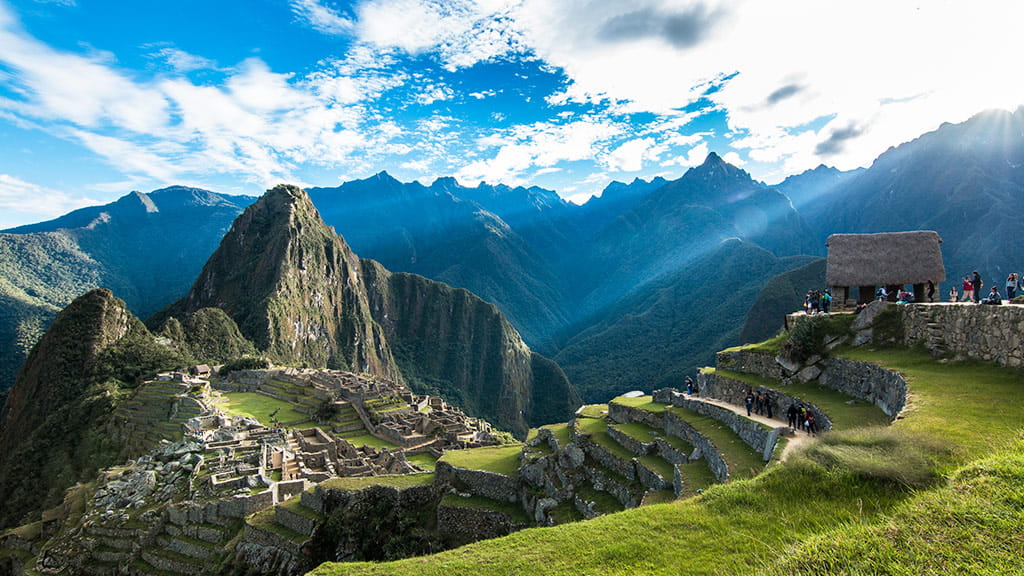
Salkantay Trek Packing List
Here is your packing list , and go over what is helpful, and what is a waste of money and backpack space.
To help our trekkers on the Salkantay Trek to Machu Picchu .
Now we show you the packaging list you need for Salkantay Trek , things like sleeping bags, shoes, t-shirts, and more.
This List is like the Inca Trail packing list to Machu Picchu , and another trekking in Cusco, make your trip more amazing by doing Salkantay Trek to Machu Picchu , because is the first alternative trek to the Inca Trail to Machu Picchu .
The Salkantay Trek , at this time the best alternative trek to Machu Picchu in Peru after Inca Trail sold out, is the main trip to go to this wonderful city of Incas, the trekking is hard in some parts of the route, we strongly recommended to read the Salkantay Packaging list .
- Passport ORIGINAL.
- 2 bags, 1-day pack, and 1 large backpack to hold everything else. Your guides will carry up to 5 kilos for you each day, so if you have 2 packs, you can divvy up the weight pretty easily and only keep on you what you need.
- 1 sleeping bag –which you need… hands down, it gets really cold at night, so is recommended a bag that can handle -10 degrees Celsius.
- Hiking boots. When you walk as much as you do on the trek, go through waterfalls, and up and down mountains, extra support and coverage can really be a lifesaver.
- 5 pairs of underwear, 6 pairs of socks. It is nice to have a couple of extra pairs of socks to change into at night when you’re not trekking. Also, We recommend bringing both really heavy hiking socks, and lighter socks as well. The weather is all over the place, so you want to make sure you’re not too cold or overheating.
- 2 pairs of long underwear, 1 super thick, 1 capeline midweight–which is perfect
- 2 pairs of pants, 1 hiking, 1 cotton–which is just enough. Please spray both pairs with insect repellent spray the clothes before the trip.
- 2 T-shirts , 2 long sleeve shirts. Actually, you will stay in a hostel in Machupicchu village and for sure you will get a long shower, and you will need 01 more T-shirt for your Machupicchu tour day.
- 1 hoodie, 1 fleece jacket, 1 fleece shirt for layering, and 1 vest, this item will be good for a cold person. Other people on the trek definitely will get away with fewer layers, the layers help.
- 1 rain jacket, 1 warm/winter jacket. The first night the temperature can be as -10 degrees Celsius and the second day you go up close to a snow-covered mountain, so the big coat is a must. The rain jacket can be helpful, cause there are rainy days (even if we are dry season!)
- 1 Cocoon sleeping bag liner. It is super lightweight and easy to pack and definitely does its job.
- Snacks, gum, and lozenges–which are needed. The trek is long and we don`t take many breaks. So if you keep a bar or some nuts in your day pack, they will really help you keep going.
- CASH–Few places in Peru accept credit cards, and in the mountains, you’re not going to find an ATM. about 500 soles, and we would recommend bringing at least that much in case something goes wrong or you need help.
- Travel-sized tissues and wet wipes. The air is cold and damp, so your nose is going to run a lot. Everyone seemed to run out of tissues by the end of the trek. Also, most bathrooms do not have toilet paper (if you even get a bathroom), so wet wipes are key.
- 1 bathing suit–which came in handy. The third and fourth nights are near hot springs, so if you plan to go, bring one. A lot of people bring towels, but you don’t need them. You can rent towels at the hostel or hot springs for 1 or 2 soles, which frees up a lot of backpack space.
- 1 pair of flip flops–which are nice, you can wear them to the hot springs, and in the shower at the hostel.
- Toothbrush, toothpaste, etc. –which you need, but pack light. You’re going to be filthy and gross, so you don’t need shampoo and soap and all of that. Pack the day-to-day minimum.
- Bug spray with 30% DEET in it –which you need, but it doesn’t work very well in Peru . The issue with Salkantay is that most of the bugs are not mosquitoes. They are these small flies you can’t even see that leave weird bites that first look like you pricked your finger, and then blow up into itchy red bumps. Unfortunately, these bugs seem to bite you no matter what kind of spray you put on.
- A headlamp–which is useful. If you don’t have one, at least bring a small flashlight.
- A camera… to take the best photos at the time you are in Peru .
- Iron tablets and pills for altitude sickness. Several people on the trek have varying degrees of altitude sickness, and both of these remedies (in addition to the coca tea) are very helpful in alleviating the symptoms.
- A watch with an alarm. You don’t need it, but there are a lot of early mornings wake-up calls, and on the last day to get to Machu Picchu, you need to wake up on your own. Also, the guide talks about the time a lot (meet at 6, dinner at 7, etc.) so a watch would be nice to have.
- Sunscreen , there are days when the sun gets really hot.
- Imodium AD or something for your stomach. Some people get an upset stomach at one on the trek, with 8-10 hours of hiking each day, you need to get over whatever the day throws at you quickly, so bring some meds.
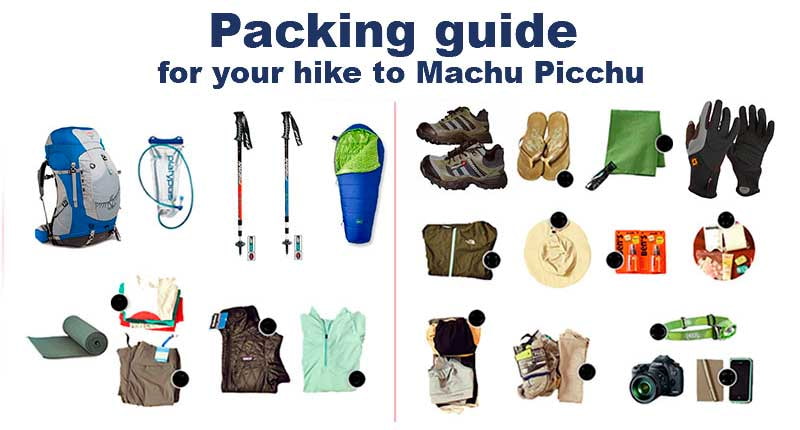
In sum, the Salkantay Trek is one of the most fascinating hikes in the world. It has stunning scenery and is packed with adventure, risk, and excitement, making it a truly unforgettable hike. By according to the map’s instructions, you can see everything worth seeing on your tour without missing a thing. Don’t go without the things you’ll need. You shouldn’t hike without company if you have any. Due to the difficulties of the trek, this strategy is the safest option available.
- [email protected]
- Second floor, Matara 242, Cusco

Go Treks Perú , is a local operator specialized in trekking, tours, hikes to Machu Picchu, Cuzco and other destinations in Peru. We have travel packages with alternative routes to Machu Picchu.

- Salkantay Trek
- Inca Jungle Trek
- Huchuy Qosqo Trek
- Ausangate Trek
- Vilcabamba Trek
- Choquequirao Trek
- Huayna Picchu
- Altitude Sickness
- Packing List
- Humantay Lake
- Lake Titicaca
- Nazca Lines
- Rainbow Mountain
- Get A Trek Quote
A Solo Salkantay Trek – How To Hike The Salkantay Unguided
The Salkantay Trail is one of Peru’s most spectacular multi-day hikes. It is seen as the wilder and longer alternative to the classic 4-day Inca Trail .
As the trail grows in popularity each year, so does the number of Salkantay tour companies selling it. There are definite perks to joining an organized tour. However, experienced backpackers may prefer a more rugged experience. No permits are needed for this route which makes hiking the Salkantay a lot easier to organize.
After hiking the Salkantay trail myself, I have written this article and compiled this list of info, tips, and advice for planning your solo hike. With a little preparation, you should have no issue taking on the Salkantay Trek unguided.
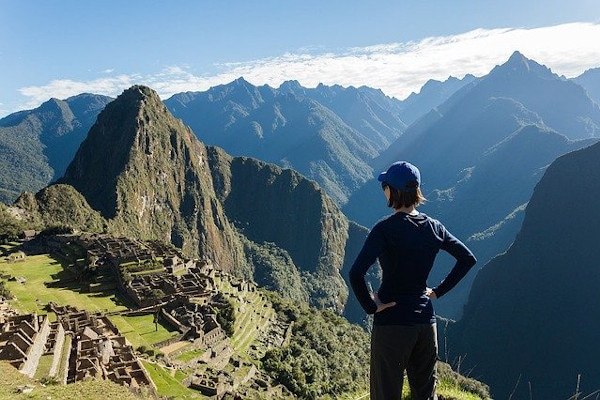
Get a Machu Picchu trek quote
Start planning your Machu Picchu hiking holiday.
A Solo Salkantay Trek - Hiking Advice for the DIY Backpacker
Can i hike the salkantay trek without a guide.
The answer to this is 100% yes. The trail is very clear and the local people are friendly and helpful. You can easily find accommodation and food along the way. This means that, with minimal planning, you can embark on this trail without booking a tour.
You can’t throw a rock in Cusco without hitting a tour office selling the Salkantay trek. If you enquire at these offices, you may well be told that it is too remote or dangerous to hike solo. Of course! Tour operators are not about to promote their biggest seller as a DIY hike.
It will benefit you greatly to speak some conversational Spanish. Speaking some local lingo will (literally) open doors when you are trying to find accommodation, directions, or a place to eat.
Looking for a day tour? Here are my 5 favourite day tours around Cusco:
- Rainbow Mountain day trip (with meals)
- Moray and Salt Mines Quad Bike Tour
- Sacred Valley day tour
- Humantay Lake day tour
- Machu Picchu and Huayna Picchu entrance tickets
See more Cusco day trips .
Is It Safe To Do A Solo Salkantay Trek?
As far as safety goes, you will be fine walking without a group. As the trail has grown in popularity, so have the facilities around the route. You seldom go more than 3 hours without stumbling across a rest point with a snack store and toilets.
During my Salkantay trek, I met a handful of solo hikers, including solo female travelers like myself. None of these unguided hikers had any complaints. In fact, most were happy with the freedom to rise on their own schedule and set their own pace.
Also, there are multiple other people on the trail at any given time. If you get into a sticky situation, help wouldn’t be far off. Make sure you pack a first aid kit with the essentials as well as your prescribed medication.
You may also like...
- Can I hike the Inca trail unguided
- Inca trail dangers and safety
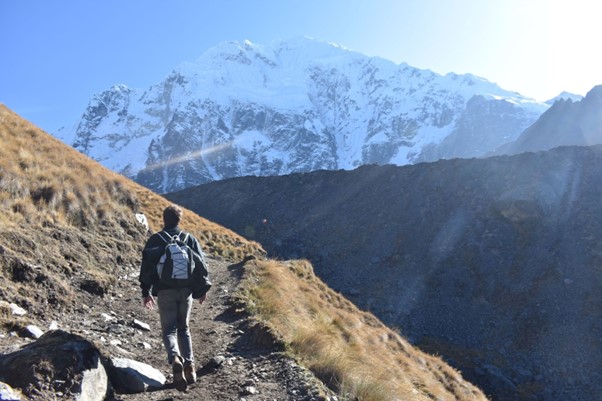
Where do I sleep on the Salkantay trek?
Imagining hauling a tent up the mountainside is what initially put me off hiking the Salkantay unguided. But in reality, you have a whole range of options for accommodation on the Salkantay Trek.
You will end each day in a set camp or small town. It is very easy to find somewhere to sleep. You can usually pay for a homestay or dorm room in the small towns on route. It is also possible to find campsites where tents, mattresses and sleeping bags are provided. Some towns have fancier options like glass domes too.
There is a variety of choices depending on your budget. You may have to hunt around a bit for a place that isn’t booked up by a tour company. On my third night hiking the Salkantay Trek, I was offered accommodation while strolling around Santa Theresa with a beer in hand. It’s really that easy to find a place to rest your head!
Cold showers and toilets are usually included in the price you pay for accommodation. If you ask around, you can sometimes find hot showers for an extra 10 soles.
I haven’t tried this option, but I doubt you could book some of these places in advance. I recommend arriving early to secure your sleeping arrangements for the night.
Where to stay? Here are 5 of my favourite accommodation options in Cusco:
- Sonesta Hotel (great 4 star hotel)
- Antigua Casona San Blas
- El Mariscal Cusco (very good value)
- Hotel Paradis (good 3 star hotel)
- Quechua Hostel Recoleta (cheap and cheerful)
See more Cusco accommodation options .
What do I do for meals when hiking the Salkantay trek unguided?
Have no fear, you do not need to plan and prepare 5 days' worth of meals for this hike. The villages and campsites along the trek have restaurants and ‘snack bars’.
You will be able to buy a plate of food or sandwich for almost every meal. Provided you are not too picky about where you eat, you can usually pay a little extra at hostels or guesthouses to include meals.
I recommend stocking up on some snacks before you hit the trail. Prices are a lot higher along the trekking route. There is an amazing variety of dried fruit and nuts cheaply available in Cusco’s markets . San Pedro Market has the biggest variety of trail-friendly food and snacks.
Kiwichi bars also make perfect lightweight trail snacks. You will see these cereal bars in every corner shop around Cusco. They sell for around 1 sole each ($0.25c!)
You can of course go hardcore-outdoorsman (or woman) and cook for yourself. In this case, you will need to have cooking gear. Here are some good examples of camping cookware and camping gas stoves you can use during your solo Salkantay Trek.
How much does it cost to hike the Salkantay Trek on your own?
It is possible to do a solo Salkantay Trek for around $175-$200 per person. This price includes food, accommodation, basic transport and Machu Picchu entrance tickets.
This price varies depending on the type of accommodation and meals.
Whether or not you hire hiking and camping equipment will also factor into the overall cost. If you are hiking as a couple or a group, you will be able to share certain costs.
Packing for your Solo Salkantay Trek - Some DIY Backpacking Tips
If you are doing a solo Salkantay trek, you will need to carry your own gear. You can find accommodation along the way, but you may want to bring a tent. This is only if you plan on camping in more remote campsite locations.
Pack light and avoid taking too many duplicate items on the packing list. For example, take only one pair of trekking trousers instead of two.
You will be able to buy meals and snacks along the way. Just to be safe, you should pack some ramen noodles, trail mix, and energy bars.
Try to keep your pack under 15kg; any more weight will make the trek very tough. If your bag is too heavy to carry, consider acquiring the services of an arrieros (horseman) in Mollepata. They charge between 30-40 Soles per mule per day and an additional 30-40 Soles per day for themselves.
Solo Salkantay Trek: Day by Day Route Information
Day 1 of unguided salkantay trek: cusco to soraypampa.
From Cusco, you can hire a private car, taxi or public bus to take you to Mollepata or Challacancha. You can also find transport from the Sacred Valley areas of Urubamba and Ollantaytambo.
Costs vary depending on the mode of transport and departure town. Budget between 200-400 soles for a private car or taxi. It is much cheaper to take a collectivo from Cusco, which costs about 16-20 soles.
From Mollepata or Challancancha, follow the trail to Soraypampa camp. Here, you will quickly be able to find accommodation as well as lunch. A tent here costs as little as 20 Soles ($5).
You can leave your bag at camp to trek up and visit Humantay Lake. Hundreds of tourists visit the lake every day, but most of the crowds leave by 1 pm.
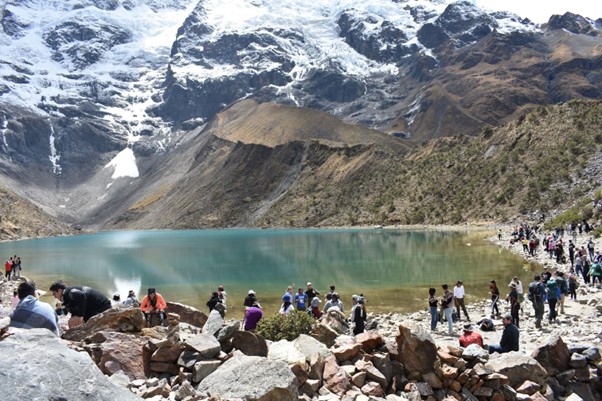
Day 2 of Unguided Salkantay Trek: Soraypampa-Chaullay
Rise early at Soraypampa to start your trek up the pass to Abra Salkantay. If you get going just after 6, you should be ahead of most tour groups. The trail up the pass is easy to follow.
It should take 2-3 hours to get to the top. This is a good spot for a snack break and for taking some beautiful photos. From Salkantay Mountain , you will descend about 1-1.5hrs to the village of Wayramachay.
On the left of the trail, glacial streams flow off the mountain. This is a good spot to refill your water bottles. I’d still recommend using a filter to play it safe though.
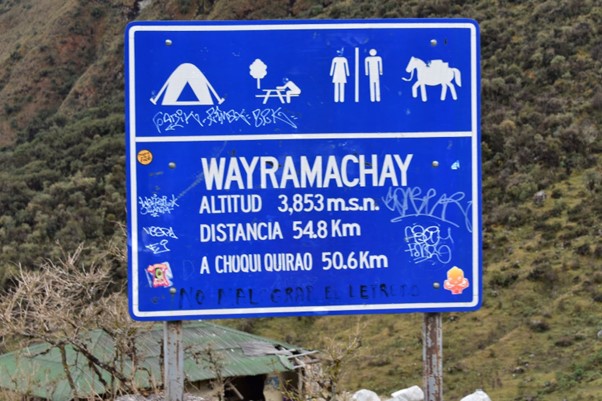
Wayramachay is the first village you pass in the catchment below Mount Salkantay.
Wayramchay is a small, rural settlement below Mount Salkantay. You should arrive here around lunchtime. There are a few small restaurants where you can stop for something to eat (expect to pay 10-15 soles).
From Wayramchay, the surrounding landscape changes to a mixed tropical forest. Temperatures increase significantly and there are biting insects (so, remember to carry bug spray!).
The path is very easy to follow. It is a fairly gentle descent on a dirt track all the way down to Chaulley. Be sure to move out the way for horses and mules coming up the path simultaneously.
Chaullay (2,860m / 9,383ft) has a good variety of backpacker accommodations. Most of these camps have restaurants and small shops selling snacks and beer.
You will have no problem finding food and accommodation for the night. Budget around 30-40soles ($8-$10) for a room for two people. You can also find electricity here to charge your phone.
Day 3 of Unguided Salkantay Trek: Chaullay-Lucmabamba / Santa Theresa
From Chaullay, you will walk a short distance along the road and through another town called Collpapampa.
If you are trekking unsupported, you may get a little confused on the trail out of Collpapampa. There are many subsidiary trails that lead off the road. Generally, these are shortcuts that lead the same way down into the valley. It’s best to follow the road or an organized tour group.
Just before the road crosses the river, you will see the trail veer off to the left bank. There is a green safety railing, making it easier to spot. In case your powers of navigation fail you, it’s a good idea to follow this single-track trail. You can walk along the road, but it will make your route a lot less interesting.
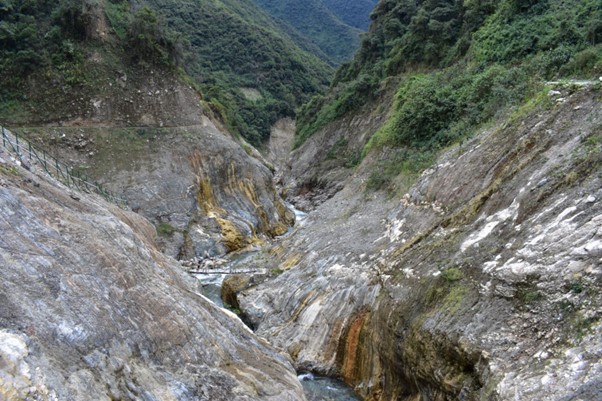
A view of the river when you descend from Collpapampa. From here, hikers are able to see the trail on the left.
When you follow this trail, the path soon reaches a steep section through the forest. When you get to the fork at the top, KEEP RIGHT. You will gradually get back to following the river course.
The trail takes you past a waterfall which is another good spot to refill your water bottles. From there, you will pass by Maracuya plantations and rest areas selling fresh juice.
As you approach La Playa, the trail splits. If you stay on the left bank of the river, which most tour operators do, you will cross a bridge. From here, the trail takes you straight into La Playa Lucmabamba (2,008m / 6,587ft above sea level).
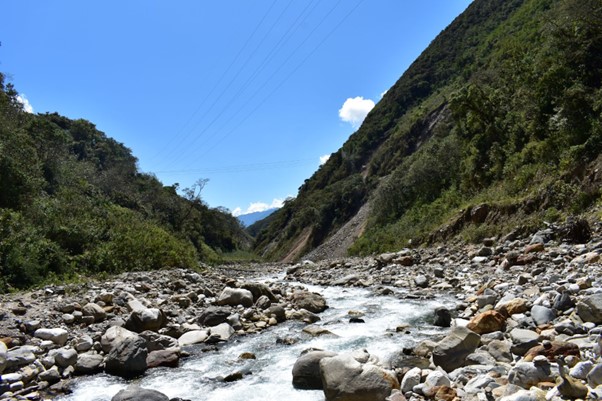
Crossing the river to the road up the right bank.
You can also cross to the right along the riverbank and across a small suspension bridge. From here, the trail goes back up to the road. Follow the road to La Playa. If you are tired, you could try to catch a ride to town with a van from here.
You can find accommodation in La Playa, but it is nicer to walk a few extra kilometers to Lucmabamba or Santa Theresa. These quieter sites have good camps and accommodations on coffee plantations.
Please Note: It is worth stopping in La Playa to do a short coffee tour. There is one particular cafe with a machine for serving cappuccinos. Look out for a double-story, wooden restaurant with ‘Coffee’ signs. It is almost the first structure on the left as you enter the town.
Day 4 of Unguided Salkantay Trek: Santa Theresa / Lucmabamba- Llactapata-Hydroelectrica-Aguas Calientes
On the fourth day, you will go up the mountainside through the coffee plantations. There are signs off the road to the trail. I recommend asking the accommodation owners or locals to point you in the right direction so you don’t get lost.
Some of this trail is on the original, stone Incan stairway. Once you are on the path, it zig-zags upwards and you can’t really go wrong. It takes around two hours at a good pace to reach the top.
When the trail flattens out in the bamboo forest, you will see some more signboards. From here, the trail splits again. To the left is a shortcut to Hydroelectrica and views of Machu Picchu. I recommend walking for about 3 minutes and spending some time at this viewpoint. The first sight of Machu Picchu in the distance is pretty good motivation.
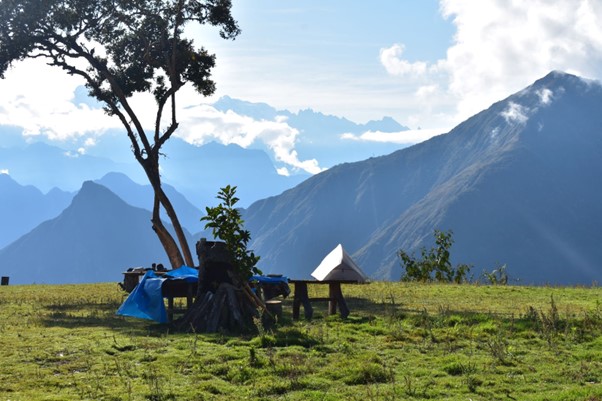
Viewpoint of Hidroelectrica and Machu Picchu. If you are trekking with a tent, you can also camp at this amazing spot.
There is also a shop selling sandwiches, juice, and coffee at this lookout. It is worth holding out until here for a late breakfast.
After spending some time enjoying the view, backtrack onto the main path and take the right fork. It is a short walk down to Llactapata ruins. After the ruins, there is around 1.5-2 hours of a steep trek downhill to the river valley.
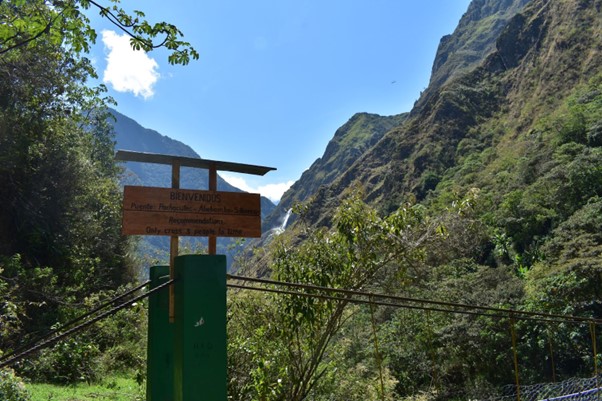
Bridge to Hidroelectrica
Cross the bridge and follow the road to Hidroelectrica. There is a checkpoint here where you will need to present your passport. You can either have lunch in Hidroelectrica or continue to Aguas Calientes.
It is possible to buy a train ticket to Aguas Calientes, which costs about $30. You can book your ticket on the Peru Rail website or take a chance and buy it at the station when you arrive.
Alternatively, the 10km / 6 mile walk to Aguas Calientes is completely flat and quite pretty. In Aguas Calientes, you will have a whole range of hotels and backpacker accommodations to choose from.
Aguas Calientes' accommodation can be booked in advance, which I highly recommend doing. After around 22km / 13,7mi of hiking, you are not going to feel like searching for a hostel.
Day 5 of Unguided Salkantay Trek: Aguas Calientes-Machu Picchu-Cusco
From Aguas Calientes (Machu Picchu town), you either need to catch a bus (which costs about $12 each way) or walk up the 1700+ stairs. I found the stairs to be a fitting way to reach the citadel after the 4-day trek.
It is most important that you book your Machu Picchu ticket well before arriving in Aguas Calientes. Tickets sell out up to two months in advance for the busy season (June - August).
Personally, I like buying the early tickets (6 AM). This allows you to explore the ruins before they become too crowded with other tourists later in the afternoon.
You can acquire the services of a registered guide outside the gate. Expect to pay 40-50 Soles per person for two or more people, or 80-100 Soles if you are doing a solo Salkantay trek. You can also do some reading in advance or take a good guidebook ( here are some great recommendations ) on your travels.
Don’t walk around uninformed. Your experience will be immeasurably heightened if you have good information to draw on as you walk through the city.
For DIY trekkers, it is possible to trek back to the Hidroelectrica Station. Here, you can get a bus that will take you all the way back to Cusco, via Santa Theresa and Ollantaytambo. This is a longer, but cheaper route than taking the train.
If you would like more information on the solo Salkantay Trek, you can read our full Salkantay Trek Guide . This complete guide includes information on elevations, the best time to hike and more.
We also have some helpful information on altitude sickness and how to deal with it in this article.
Feel free to ask questions in the comment section below and we will get back to you within 24 hours.
Alison Macallister
With a degree in Nature Conservation and experience working with wildlife including the Big 5, Alison works as a guide for a 5-star reserve. She enjoys sharing her passion for all things nature-related. She enjoys hiking, horseriding, 4x4 driving and kayaking.
Leave a Reply
Your email address will not be published. Required fields are marked
Name * * * *
Email * * * *
Hi, thanks for the ultimate guide about solo trek Salkantay. It is very useful! I have a question. Is there a tax for entry the Salkantay and it is included in that count: "It is possible to do a solo Salkantay Trek for around $175-$200 per person. This price includes food, accommodation, basic transport and Machu Picchu entrance tickets."
Greetings, Rebecca
Hi Rebecca, there is no tax that I’m aware of, but you will need to purchase tickets for Machu Picchu.
A question I have; when catching the collectivo out of Cusco to go to Mollepata, where do I find that bus station at in Cusco?
thanks- Renae
Hi Renae, I think you can take a collectivo to Curahuasi (marked like this on Google Maps) and ask to climb off at Mollepata. I think there are also big buses to Curahuasi. You may need to climb off at Limatambo and then take a collectivo to Mollepata.
Thanks so much, Mark!
Another question about the collectivo to Mollepata, approx how many soles is the going rate for that? Thanks! Renae
Hi there, thank you for the detailed explanation! A few questions: How common is it to find a place to feel in water? do you have a map where it's possible to see the trail with day distribution? How much Km it's for each day? Is there a good signal for the phone in case of emergency?
Thanks a lot!
Hi Arik, glad you found it helpful! You can full day-by-day in this article . There is a also a nice map. Basically Day 1= 12km, Day 2=22km, Day 3=18km, Day 4= 17km. Day 5 depends if you walk the 2km up to Machu Picchu or take a bus.
As far as water goes. It’s best to take a bottle with a filter. On the first day, there was no real place to fill up but the walk is very short. There are a few spots to refill on all the other days.
I honestly didn’t check my phone too often but I did notice there was signal on some of the trail as well as around most camps. It’s not completely isolated and there are a lot of other people on the trail which makes it feel safer.
Hope that answers your questions
Thanks for this great Blog.
I'm just wondering which year you did it.
And if I hike the whole trail alone and will not be able to share the accommodations with a second person, do you think I will not pay more than 200$?
Hi Sena, I did this hike in 2022. I think it is still completely possible to do it alone for under $200 so long as you are prepared to hunt around a bit more for cheap accommodation options. This will be much easier if you can ask around in a little Spanish. There are a few campsites but honestly, I’d pay a little more not to carry a tent. Take at least some of your own food and definitely a water filter as prices are heavily inflated on the trail. My best advice would be to get onto a Peru Facebook travel group (I was on Backpackers Peru) and find someone who has a similar plan to you. Enjoy It!
I'm wondering which circuit of Macchu Picchu you did? I'm reading good things about hiking Macchu Picchu mountain, but I just think I won't feel like it after doing the whole Salkantay trail.
FYI: this post was so useful, thank you!
Thanks! Juliette
Hi Juliette
Glad to hear you found this helpful! I did circuit 4 with Huchuy Picchu (a very small peak that is relatively newly opened). This is a pretty standard circuit but, like you, I figured I wouldn’t be up for another climb and I wasn’t too phased about the ‘classic’ photo spot or Inca Bridge. Honestly, I was perfectly happy with my choice. It’s only about 10 minutes up Huchuy Picchu and we had a pretty amazing view of Huayna Picchu. The circuit you choose depends what your priorities are to see on the site.
Hello, thank you for this post, the information is very helpful as my wife and I are thinking of doing this trek in a few weeks.
I have some questions though…
1 – Is it possible to get an arrieros at Challancancha?
2 – Would we need to get different arrieros along the way or would one go the whole distance? If just one, would we need to provide food/accommodation and is that included in the cost?
3 – Can you tell us which village campsites provide tents? For instance Wayramachay? As we may split day 2 and other long days up.
Great to hear!
I’m not 100% sure about the arrieros (muleteers) as I didn’t try to hire a mule. It seems most of them work with trekking companies and solo hikers tend to carry their own gear. You could approach one of the trekking companies and ask if its possible to only hire a mule/ horse (to be honest, I doubt they would be helpful).
1. I didn’t see any ‘freelance’ arrieros hanging around Challancancha.
2. I only saw mules on the trail on the first and second day. There was an option to ride a horse/ mule up the steepest pass to Salkantay mountain. I’m sure you could pay for your bags to be taken up (note that the animals don’t go all the way to the top). From Salkantay pass, it’s all downhill to the second camp/ hostel. Companies use vehicles to transport luggage from this point. With a little negotiation, you may be able to find a driver with a group and get your bag dropped at Santa Teresa or Hydrolelectrica. Just be sure you are clear on where you can meet/ pick up later (and what you are paying).
3. I saw campsites at Wayramachay but there didn’t seem to be tents available. Its an easy (if long) downhill to Chaullay where there’s a few more accommodation options. Day 4 was the toughest for me, unfortunately, it would be difficult to split unless you carry a tent and camp at the top (an ‘unofficial’ site above the Llactapata ruins).
I hope this helps!
Thanks so much for your quick response Alison!
This may make it a bit too tricky for us unfortunately but we'll see if we can find a work around or two.
Thank you so much for this informative guide! I live in the Sacred Valley and am planning a Salcantay trek in Aug/Sep this year. This post is so detailed, I feel so much more at ease about doing this trek solo. Love the tips about food and accommodation too. Thanks again!
You are most welcome Ellie, Enjoy it!
Thank you a lot from this post! I downloaded it to my phone and used it as a ”map” in the salcantay trek. I had zero problems doing the trek alone and I met a lot of others who were doing it alone aswell. The prices have went a bit up since your post but I managed to spend around 140€ in total in 5 days. I’m truly thankful that you made this post so clear and easy to follow!
Hi Toni That’s great to hear, thanks for that feedback regarding the prices. I’ll update the post when I get a chance.
Just wanted to say thank you for posting something so helpful. Really cleared my concerns when if comes to finding accommodations.
Hi Christopher, glad this helps you out
big greetings 🙋🏼♀️in January I am planning a solo sankatrai trek. how far in advance do I have to buy a ticket to enter Machu Picchu. thanks
Hi Marija, depending on the season I recommend getting your permit for Machu Picchu as early as possible. At least a few weeks before you travel.
If I understood it correctly you decided to walk the stairs the last part from Agua Calientes to Machu Picchu. Also, I understood it as you bought the 6AM ticket. When does that mean that you started the last hike up to Machu Picchu? I also have the 6AM ticket and thinking about if I should take a bus or hike the last bit.
Hi Andre, yes that’s right. After hiking for 4 days it seemed like cheating to catch the bu! I was pretty exhausted at that time plus you need to start early (just after 5 am) to get up in time. You walk out of town, past the bus stop and a permit check point and then start to climb the 1700 (or so) stairs. There are usually others doing te same thing so it shouldn’t be hard to follow the crowd or ask directions beforehand. It was dark for most of the way but pretty tough. Still, felt rewarding to reach the site on foot. Hope that helps!
Thank you for this informative post, Alison! I have a question about Llactapappa. In your post it seems that only "unofficial camping" is available, but there seems to be a lodge there. At least that is what their website indicates. ( https://llactapatalodge.com/llactapata-lodge.html ) Am I mistaken? My family will be walking this unguided in December and we were considering staying in Lucmabamba (or Santa Teresa) one night, and then having a short day to Llactapappa for the next night.
We are planning to end the trek in Hidroelectrica because we will have already spent two full days at Machu Picchu prior to this trek. Would we be missing much by skipping the walk to Aguas Calientes?
Hi Erik, glad you found this post useful!
Yes, that lodge is just below the ruin site. We made a brief rest stop there and it does have a great view of the valley.
If you have already visited Machu Picchu, I wouldn’t worry about skipping the trek to Aguas Calientes. It is all along the railway with a lot of other hikers doing the same thing. Not really a highlight of the route.
Hope that helps!
Hi, is it possible to hike the trail in February?
Hi Annalena, yes, it is possible to hike the Salkantay in February. Only the Inca trail closes in February. I wouldn’t recommend hiking in this month though as it gets pretty wet and visibility isn’t great. There is also landslide risk during the wet season so I recommend taking a guide.
Hi Alison! If you wouldn't mind, I just have one question:
Where did you store your hiking gear while you were in Machu Picchu? I'm specifically asking because I'm taking expensive camera equipment (including a gimbal – which is basically a fancy selfie stick and those are not allowed) and I don't want to leave it in the bag check bc I don't want my things getting stolen. Do you know how safe the luggage storage is? Is it lockers where I get a key or a passcode and only I can get in? Are there cameras? If the luggage storage at Machu Picchu is not fully secure, is there a more secure place to leave my things?
Hi Paula. I left my main bag at the accommodation where I was staying it in Aguas Calientes. Most of those accommodations have a lock up room / safe which I felt secure leaving things in. Unfortunately I’m not sure about the storage at Machu Picchu itself as I only took a small backpack up and could bring it in. Generally I think it would be fine there but yeah, if you are worried best to leave it locked-up at your accommodation in town. Hope that’s a little helpful:)
Hello Alison! I want to say you thanks a lot for your detail description of Salkantay trek.We have never been in South America but this part of earth time to time reminds us about itself Hopefully we will make it next year! wish you all the best in your traveling!
Hi Olga. Fantastic to hear! It’s a beautiful part of the world, I hope you get to experience it!
Thank you for your post. Very informative. I have a question about the accommodation. I don’t want to carry a tent but will I still need to carry a sleeping bag?
Hi Christian, yes, I’d strongly recommend bringing a sleeping bag. Some of the accommodations may have bedding but you will have more options if you are prepared to stay in places that only offer a mattress. Hope that helps!
Thank your article, it was very, very helpful. Me and a spanish speaking friend will be walking Salkantay trail mid May this year. I do not plan to carry a tent, and will hopefully be able to find a place to sleep each night, (or perhaps book on booking.com that day or a day before? One question I do have, is if I'm doing it without a tent, and planning on staying in places along the way, should I still bring a quilt or sleeping bag? I do not see this addressed anywhere. And any idea how cold the evenings get mid May on the trail? Thank you very much Michelle
Hi Michelle, great to hear that you are planning on doing this trek! I think it’s a great idea to try book the nights you can before you go. Yes, I’d recommend taking a sleeping bag with. It’s better to be prepared, especially for more basic accommodations.
Get a quote from our recommended local trek operator in Peru
Best local guides. great value hikes..
- Just Me
- Me + 1
- Me + 2
- Me + 3
- Me + 4
- Me + 5
- More than 6
Hiking the Salkantay Trek to Machu Picchu Without a Guide
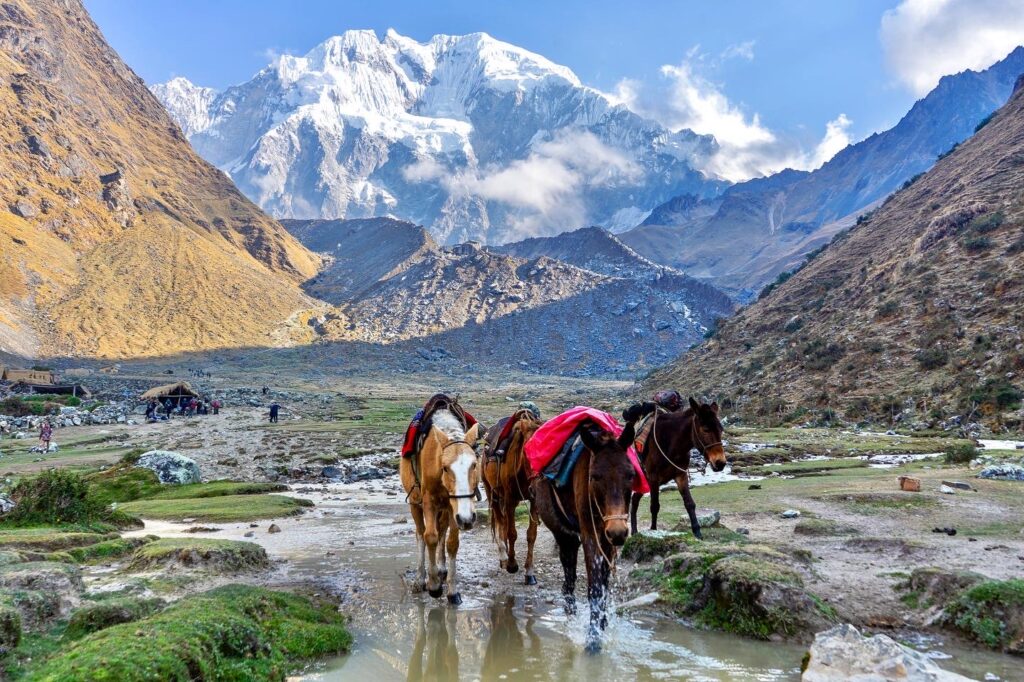
Hiking the Salkantay Trek to Machu Picchu was at the top of my list when planning my trip to Peru. And as a backpacking guide myself, I knew I was capable of planning the logistics to hike the Salkantay Trek without a guide.
I wanted to save some money, trek at my own pace, and avoid the crowds that come from hiking with guided groups in Peru.
Alas, following a few hours of research and after talking with a few other travelers at my hostel in Cusco, Peru, I had a pretty good idea for my itinerary. Planning the Salkantay Trek without a guide is pretty easy and here’s an idea of how you can do so too!
What is the Salkantay Trek?
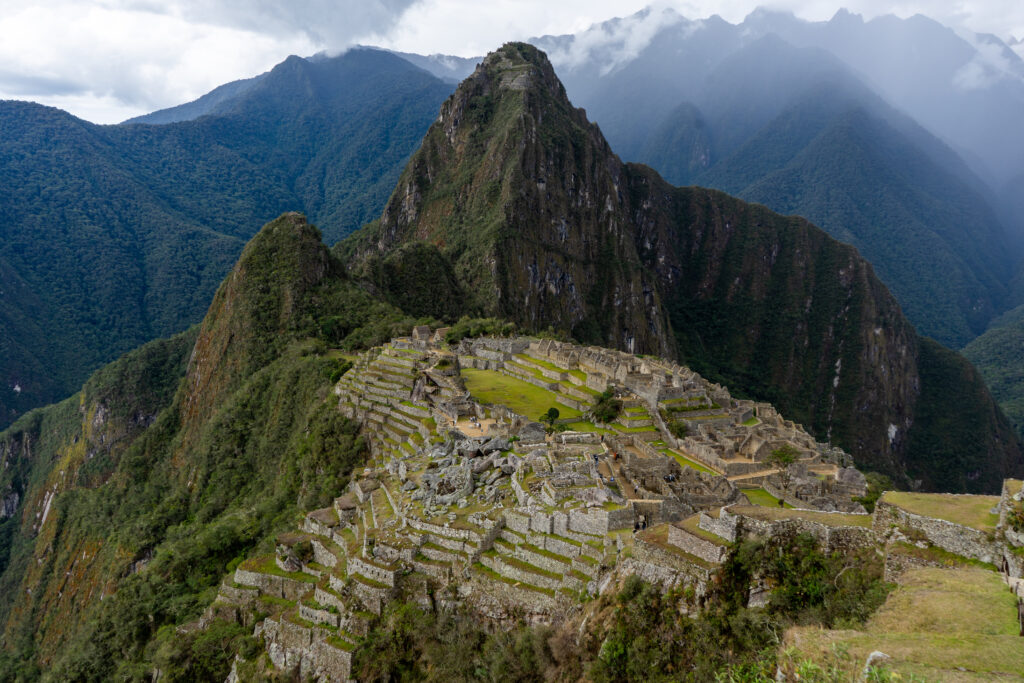
The Salkantay Trek is about a 45-mile (75 km) trek from the town of Soraypampa, up over Abra Salkantay Pass, down into the jungle, and all the way to the ancient Incan archaeological site, Machu Picchu.
Along the way you hike over the 15,092 foot (4600m) Abra Salkantay Pass, then quickly descend down into the jungle for the next few days of trekking.
Can I Hike the Salkantay Trek Without a Guide?
Yes! The Salkantay Trek to Machu Picchu is one of the most popular, and scenic trekking options in Peru, if not South America, and doesn’t require a guide like the nearby Inca Trail.
With some extra planning and research, it’s pretty easy to plan the Salkantay Trek without a guide. And this guide provides you with all the details so you can successfully plan your solo Salkantay Trek!
Details of the Salkantay Trek to Machu Picchu
When to hike the salkantay trek.
It’s possible to hike the Salkantay Trek year-round, but the best weather is during the dry season from April to November.
The prime weather is from May to September with the rain picking up in the shoulder months of April and November. It is far more crowded hiking during the dry season so you should book lodges ahead of time.
I completed the Salkantay Trek in early December during the rainy season. I loved that the trails were far less crowded and I could book lodges upon arrival. While it did rain each afternoon, if you’re at camp early enough, by 2 or 3 pm, you will likely miss the rain on the trail.
Salkantay Trek Itinerary
I spent 3 days hiking the actual Salkantay Trek but I was technically away from Cusco for 5 days. I spent the first day getting to the trailhead followed by a day hike to Laguna Humantay.
The fifth day of the Salkantay Trek was spent transporting back to Cusco. It was an 11-hour journey that departed from a town near Machu Picchu. Here is a breakdown of the logistics.
Day 1: Cusco to Soraypampa with a day hike to Laguna Humantay

Day 1 was our transport day from the city of Cusco to the town of Soraypampa, the starting point for hiking the Salkantay Trek.
We stayed at the Humantay Sky Lodge. It cost us 55 soles for dinner, breakfast, and a bed in a 10-bedroom dorm.
This was the best price we found in town and it was located right at the split for the Laguna Humantay Trek and the Salkantay Trek. This saved us an extra 20 minutes of walking the next morning.
The Humantay Sky Lodge also has private lodging available for only a few US dollars more.
I’d recommend contacting the Humantay Sky Lodge on WhatsApp (+51 913 298 630) if you want to reserve in advance. The prices are cheaper in person than online, so don’t pay until you get there.
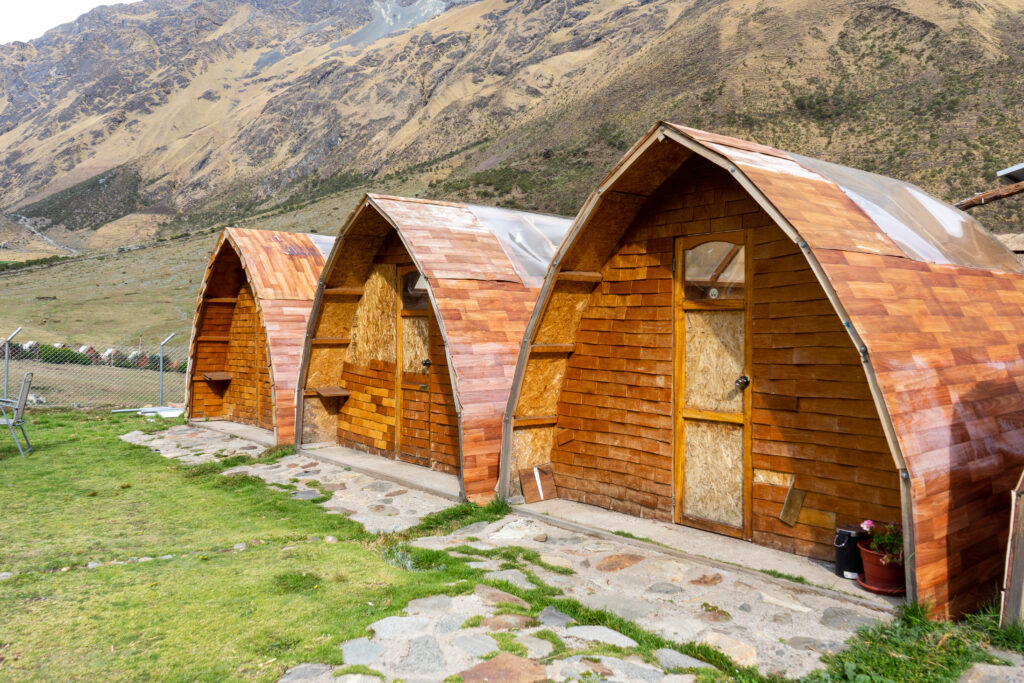
Transportation
The easiest way to reach Soraypampa, the start of the Salkantay Trek, is by taking a commercial bus tour to Laguna Humantay.
Buses run every day from Cusco and cost between 50 – 70 soles. They are the easiest and most efficient way to reach the start of the Salkantay Trek. Almost any agency in Cusco can arrange this.
An alternative option is taking a colectivo from Cusco to Mollepata for 15 – 20 soles and then taking a local bus to Soraypampa. We never found the local bus and ended up paying for a taxi which cost just as much as catching a ride with a local tour operator.
Day Hike to Laguna Humantay

Located right next to the start of the Salkantay Trek is the must-visit Laguna Humantay. It’s a short but steep hike up to a beautiful turquoise-blue alpine lake. It’s a great hike to acclimate for the Salkantay Trek and it is a great way to spend your day when you arrive early in Soraypampa.
Day 2: Soraypampa over Abra Salkantay Pass to Chaullay (12.5 mi, 20 km)
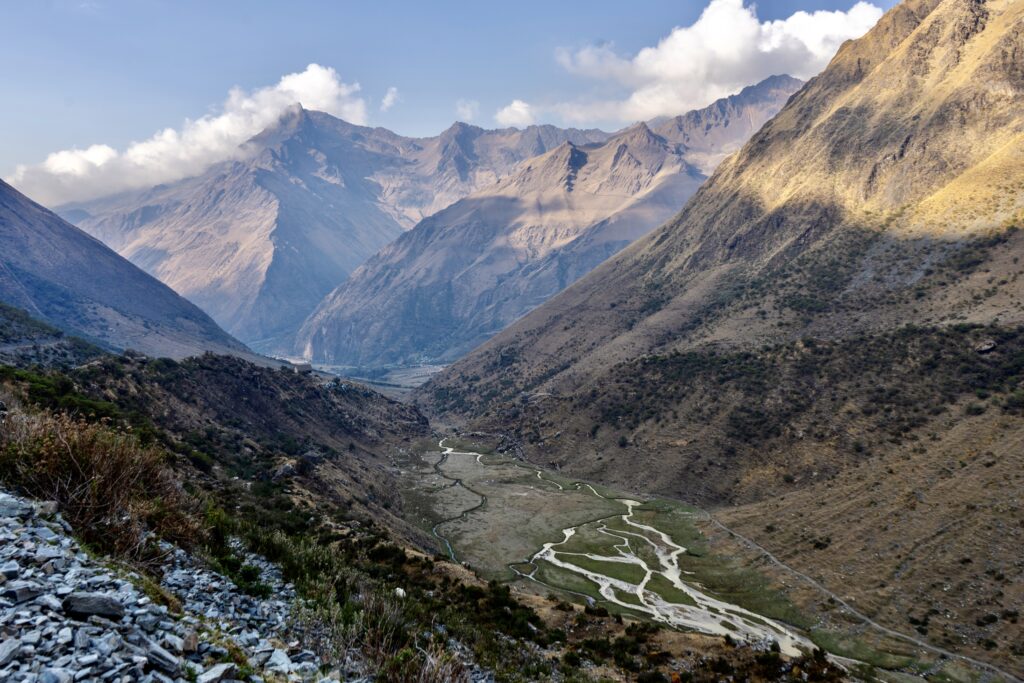
We started early on our first morning of hiking the Salkantay Trek as it was important to make it over the 15,092 foot (4600 m) Abra Salkantay Pass as early as possible. With a greater chance of rain and clouds moving in as the day went on, it’s often best to start early when hiking at high elevations.
We had breakfast at 5:30 at Humantay Sky Lodge then set off by 6:30. On average it takes between 2 – 3 hours to reach Abra Salkantay Pass if you’re in good shape. At the top of Abra Salkantay Pass, it was cold and windy so we didn’t stay for long but the views were worth the climb.
Then we had a long descent of around 6000 feet down to the town of Chaullay. Chaullay is the perfect town to stay in along the trek for your first night.
Many accommodations in Chaullay range from 60 – 80 soles a night and include a bed, dinner, breakfast, wifi, and a hot shower. Because we were trekking during the low season we had no trouble finding a place for the 10 of us hikers trekking without a guide.
When we showed up we were greeted with smiling faces and comfortable beds.
Day 3: Chaullay to Llactapata (13.5 mi, 22 km)
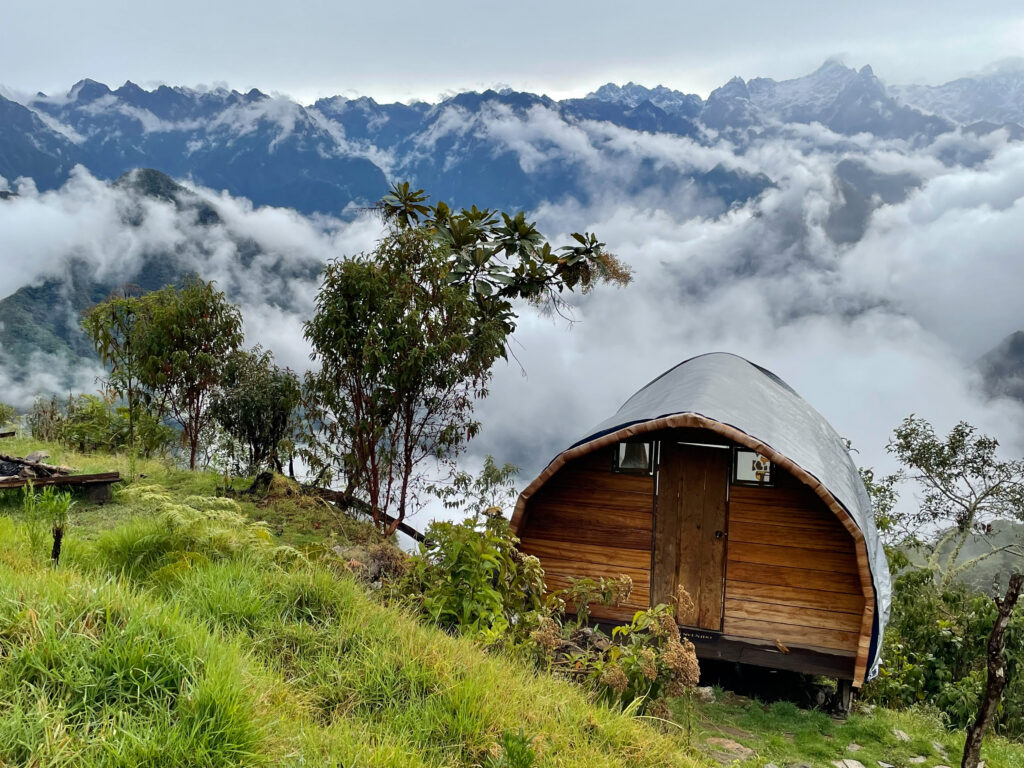
We all thought day 3 of hiking the Salkantay Trek would be pretty easy since it started with a long downhill followed by a short, yet very steep uphill. We were wrong. This day was pretty tough even though you’re no longer at altitude.
If you plan to hike the full Salkantay Trek, as listed on AllTrails , then start your day early. There are significant elevation gains and losses throughout the day. The trail parallels the road and tour groups sometimes take colectivos part of the way, cutting off some of the best parts!
But don’t worry, the evening in Llactapata was highly rewarding. We stayed at Machu Picchu Ecolodge which is undoubtedly one of the most beautiful places I’ve ever paid to sleep.
A bed, dinner, and breakfast cost 120 soles for a solo traveler and 160 for pairs. The accommodation was an ecolodge located on the edge of a cliff atop a mountain, looking down on Machu Picchu. It was stunning. And definitely, worth the extra money.
Day 4: Llactapata to Machu Picchu to Mandor (12 mi, 19 km)
On day 3 we decided to make the push all the way to Machu Picchu. Most people hike up to Machu Picchu on their fourth day however, we heard it’s less crowded in the afternoon. It also meant we could get back to Cusco earlier the following day.
Once again, this is a tough day. You have to hike all the way down the mountain from Llactapata. Then you spend a couple of hours walking along the famous train tracks to Machu Picchu.
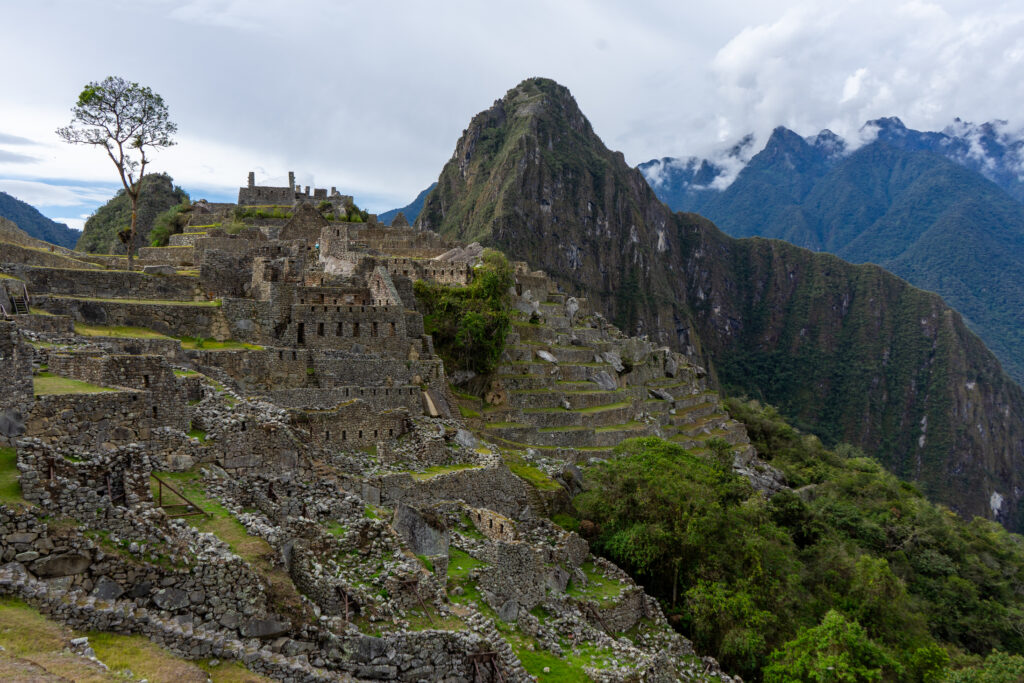
Finally, you’ll reach the steep blocky steps that climb up to Machu Picchu which you’ll have to descend later. It’s another tough day. If you’re not an avid hiker, I’d recommend getting early tickets to Machu Picchu on your fourth day.
That night we stayed in the town of Mandor, at Mandor Machu Picchu . It’s one of the only accommodations near Machu Picchu, outside of Aguas Calientes. Beds in a 4-person dorm were 40 soles a night and dinner was 20 soles. There are also private rooms and an area to camp.
Day 5: Mandor to Cusco
Staying in Mandor our last night put us closer to Hydroelectrica where we took the colectivos in the morning.
Many people stay in Aguas Calientes (where you should definitely stay if you’re taking the train back from Machu Picchu), however, if you’re taking the cheap way back to Cusco, staying in Mandor cuts off a little bit of walking time.
We arrived early at Hydroelectrica because we were told the collectivo would leave at 7:30 am. There was some leeway to that time but it was the start of a long day.
We would switch buses multiple times and did not reach Cusco until 11 hours later but it only cost us 50 soles to get back compared to the train rides which are around $80 US one way.
The locals were helpful in connecting us from one colectivo to the next.
Alternative Options
The itinerary I listed is intense compared to guided tours and other Salkantay Trek itineraries.
If you’re looking to make the Salkantay Trek a little easier, staying in Lucmabamba on night 2 is a great option. That will also give you time to visit the beautiful hot springs in Santa Teresa!
Lucmabamba is also known for its coffee-tasting experiences in the jungle! It’s a great stop along the Salkantay Trek. Don’t miss grabbing a cup of Inka Andean Starbucks Coffee if you stay in town or while hiking through!
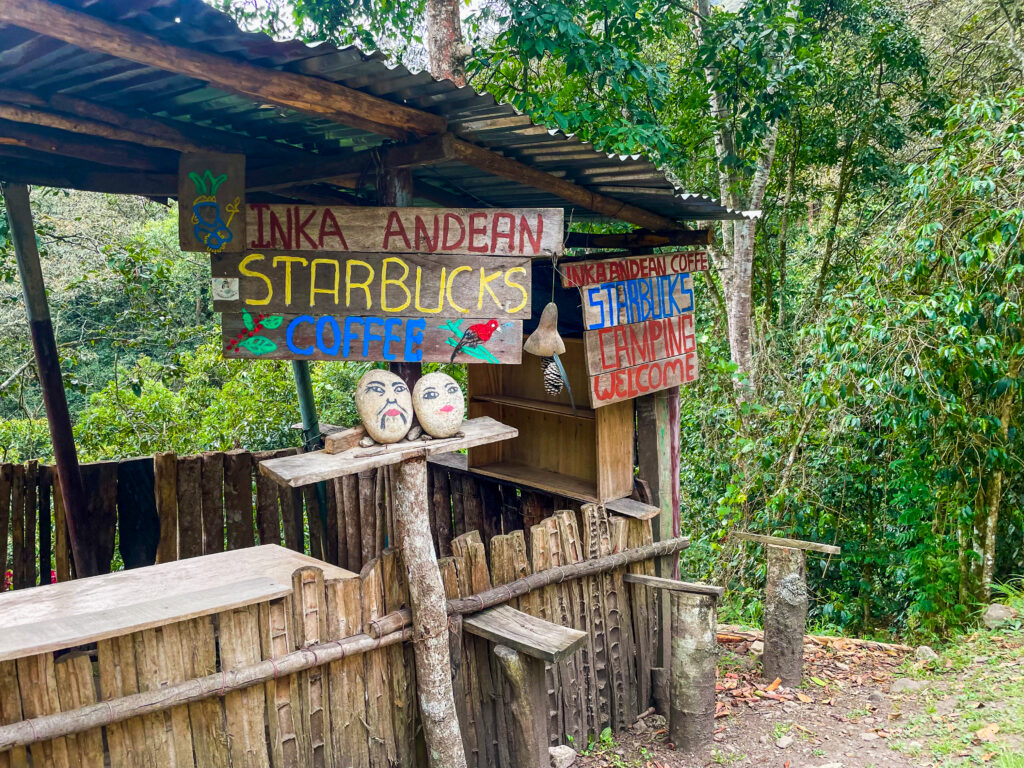
If you spend the night in Lucmabamba I’d recommend hiking Machu Picchu on the morning of day 5 of the Salkantay Trek. This will spread out your schedule and doesn’t change much other than getting back to Cusco late at night on the last day.
Salkantay Trek Planning
I contacted a few hostels/refugios before I started hiking the Salkantay Trek. I hiked the Salkantay Trek in December during the rainy and low season of Peru. Because of this, it was very easy to find accommodations.
If you plan to hike the Salkantay Trek during the peak months from April to October, I’d recommend reaching out to accommodations ahead of time, especially if you have a large group. Or start hiking early so you’re the first ones to reach the towns to claim a bed.
Cost of the Salkantay Trek Unguided (December 2022)
Machu Picchu ticket: 152 soles
Salkantay Trek permit: 20 soles
Transport from Cusco to Soraypampa: 70 soles
Transport from Hydroelectric to Cusco via colectivos: 50 soles
Accommodation 4 nights including dinners & breakfasts: 295 soles
Snacks and lunches: ~100 soles (I bought most snacks at a local market)
Total: 687 soles; ~$180 US
Overall, hiking the Salkantay Trek solo is cheaper than a guided tour. If you choose to camp, that will save a little money too. Also, the Machu Picchu Eco Lodge was a bit of a splurge and you can easily save money that night.
Most tour companies based out of Cusco charge $250 – $500 for guided Salkantay Treks to Machu Picchu.

Other things to know
Navigation: I used AllTrails to follow the official Salkantay Trek to Machu Picchu Route.
Tickets: Buy your Machu Picchu tickets online at the official government website for you to start your trek to guarantee your preferred time slot.
Altitude: This trek starts up high and then descends into the jungle. The first 2 days are the hardest in dealing with altitude sickness. Take your time hiking and spend a few days acclimating in Cusco before starting the Salkantay Trek.
Bugs: As you descend into the jungle bugs get REALLY bad. It’s not just mosquitoes, sandflies are also horrible. Bring bug spray or loose-fitting pants and clothing to avoid bites.
Gear Rentals: You can rent all of the gear you need for the trek in Cusco. I’d recommend checking out Speedy Gonzalo in Cusco for any gear rentals.
Snacks & Lunch: There are places along the trail to buy lunch and snacks. Lunch often costs around 15 soles. I also stocked up on snacks at the local San Pedro Market in Cusco.
Planning: The Salkantay Trek without a guide is just as easy to plan as any backpacking trip. If you need tips for planning your first backpacking trip , check it out here!

Salkantay Trek Packing List
This is a comprehensive Salkantay Trek packing list. Layers are essential for the Salkantay Trek to Machu Picchu. With varying elevations and climate zones, you never know what the day will bring and weather reports don’t work too well in the mountains. From rainy cold days up high at Abra Salkantay Pass to hot days in the jungle here are a few Salkantay Trek packing list essentials.
- Rain jacket
- Quick drying pants
- Sleep clothes
- Clean socks for sleeping
- Baseball hat
- Warm winter hat
- Shoes suitable for hiking
- Flip flops/shoes to relax at lodges in
- First aid kit with essentials (bandaids, Neosporin, Ibuprofen, Tylenol, Benadryl)
- Passport photocopy or photo on phone
- Screenshot of Machu Picchu ticket
- 1000 soles per person (at least; ATMs are hard to come by)
- Trekking poles (optional)
- Tent, sleeping bag, & sleeping pad if you plan to camp
- Rain cover for backpack
- Water filter
- Water bottle
Hiking the Salkantay Trek to Machu Picchu solo takes a bit of planning but is doable for anyone willing to put the time into it. You’ll enjoy one of the most famous treks and sites that Peru has to offer and you’re sure to meet many incredible people along the way!

You May Also Like
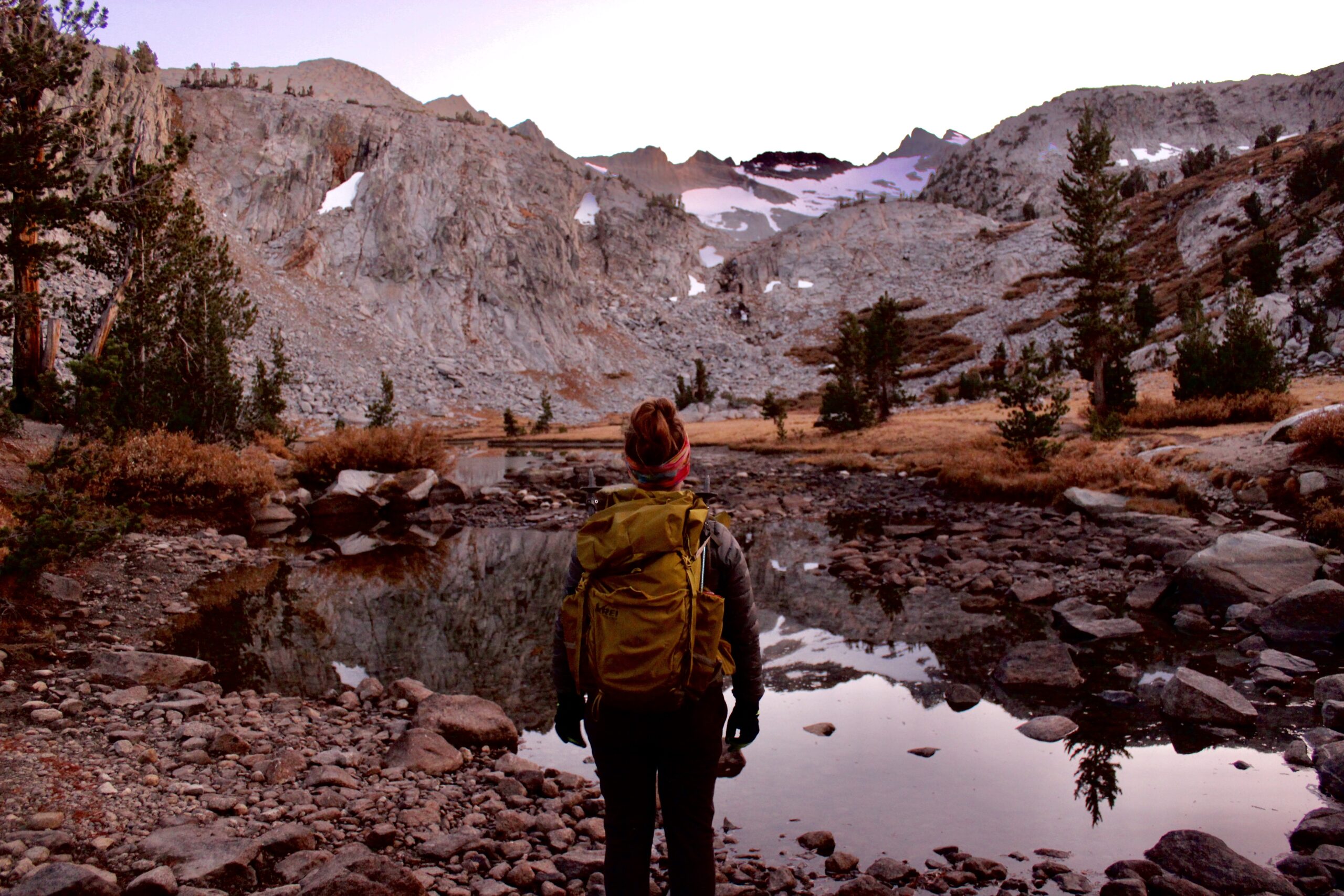
Backpacking for Beginners; Planning Your First Backpacking Trip

Trekking Cerro Castillo Circuit
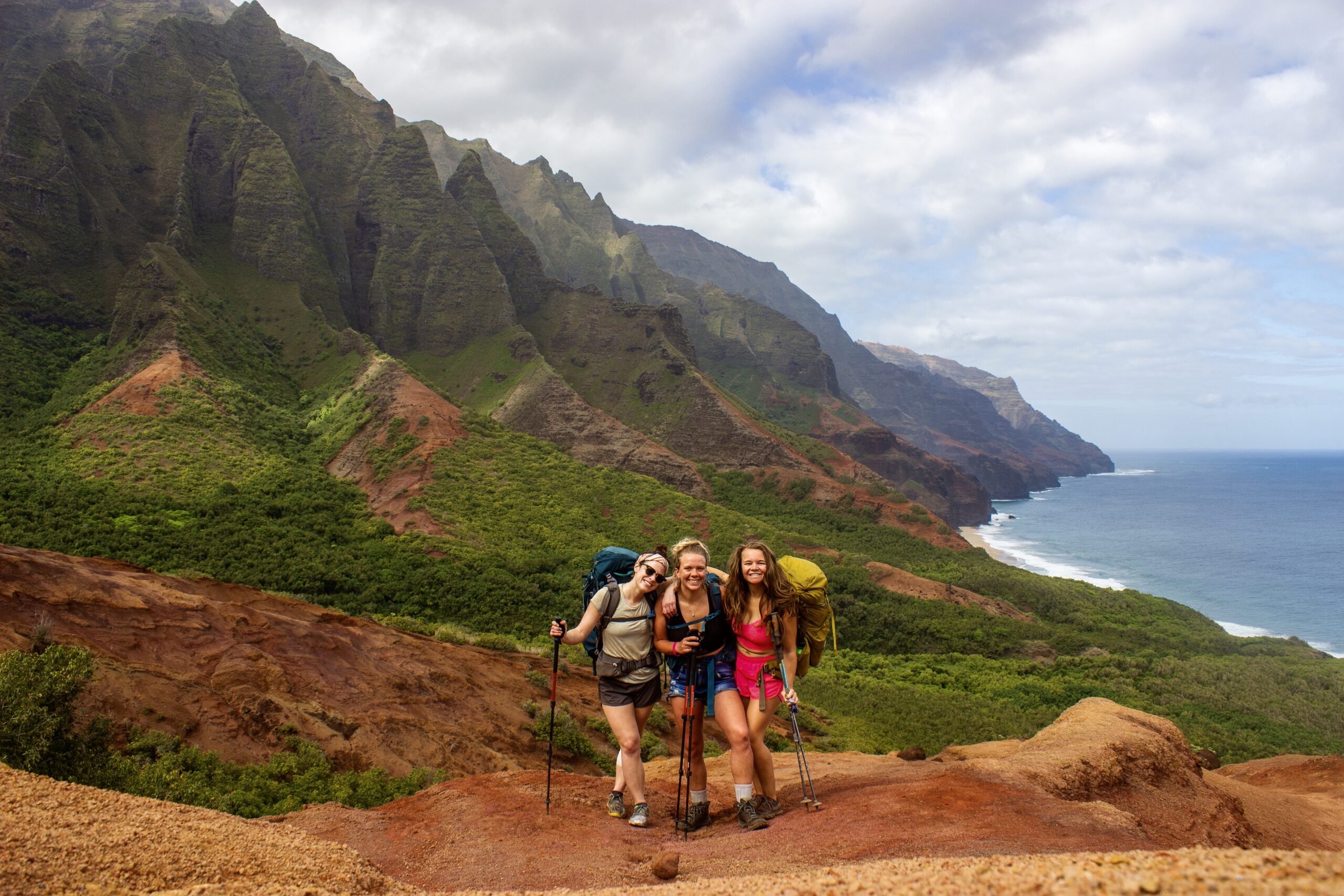
Backpacking Kauai: Napali Coast to Kalalau Beach

Hiking the Salkantay Trek: Everything You Need to Know
On the top of my list for the longest time (and on the top of everyone’s list I am sure) has been hiking my way to Machu Picchu via the Salkantay Trek, the lost Incan city. As soon as travel started to open back up in 2021, we found ourselves some affordable flights to Peru and decided to look into the hiking trek along the Salkantay, and wanted to share with you everything we learned from our research!
What This Guide Covers: The Basic Outline Know Before You Go Breakdown of Daily Hiking What To Know About Machu Picchu Packing List of What To Bring
SEE MORE // THE BEST TRAVEL CREDIT CARDS TO MAXIMIZE YOUR POINTS

The Basics About the Salkantay Trek
The Salkantay Trek has long been known as a less-busy alternative to the famous Inca Trail, the original trail created by the Incan people to Machu Picchu. With the limited number of permits available for the Incan Trail, and with how hard it is to snag one of those spots, this is an incredible alternative. It’s a beautiful 4 to 5 day pass through the Salkantay Mountains in the Andes Range, about 40 to 60 miles depending on which trek you choose to take!
The Key Pieces to Know:
- Time Needed: Two options are available, a 4D 3N short trek (what we did) or a 5D 4N long trek
- Distance Covered: The shorter 4D trek is 37 miles total vs the 5D trek is 44 miles total
- Difficulty: Absolutely difficult, even our 25 year old in shape selves DEEPLY struggled
- Altitude: Reaches up to 4.6k meters or 15,000 feet! It’s a brutal altitude
- Prices: We opted for a $290 trek with AmericanInca , but prices can go up to $600
- What’s Included: Most tour company have all inclusive treks! Which means your sleeping arrangements, meals, and all transportation is included. Does not include alcoholic drinks or tips!
For the purposes of this guide, we’re going to break out our four-day trek with American Inca Trail ! I highly highly recommend them as a company, and cannot say enough incredible things. They absolutely blew us away with having the best food, great accommodations, and an incredible guide who has lived his whole life in the region and never left our side.

Know Before You Go // Prepping for the Trek
Pick Up is in Cusco and you will need to arrive AT LEAST TWO DAYS before your trek. Not required, but you’re 100% going to appreciate the time to adjust to the altitude. Plus the city is beautiful, and we shared our favorite spots on our One Week in Peru guide to help you out!
Getting to Cusco when they tell you to get to the airport 2 hours early, listen. We almost missed our flight from Lima to Cusco because we tend to be arrive-late people. Do not make that mistake, as there aren’t THAT many flights!
Avoid eating fruits & veggies Before your trek, you should ensure you’re careful about what you’re eating. The middle of a mountain is the last place you want to have stomach issues. Trust me.
Don’t drink the water and don’t even brush your teeth with it! Stock up on water bottles and only use those.
You Get One Duffel Bag to carry your trek clothes with you. Pack wisely, and don’t bring what you don’t need. We have a full packing list at the bottom of this blog post!
Keep Your Backpack Light because the weight on your back is going to be one of the hardest parts. Heavy items in your duffel, and lightest must-haves go in your pack but that is IT.
HYDRATE because that’s the best way to handle a four day trek in that much altitude!!!!

Day One: Hiking The Salkantay Pass
Quick TLDR: You’re hiking about 8 hours and 14 miles total up a mountain and then back down. Wear layers as the top of the pass is ice cold, but you’ll be overheating. Pack about 2-3 liters of water and shoes that can handle ice and snow on the ground. Also, pack snacks!!!!
Before I type this up, please know that this is the hardest day and every following day will be easier. But this day just about killed me. You’re going to finish this trek feeling 1) on top of the world which you basically are at 15k feet and 2) like your entire body is going to give up on you. As long as you’re mentally prepared for this and aware YOU CAN DO IT then that’s part one.
Pick Up in Cusco
Your day begins with a bright and early 3AM-4AM wake-up call in Cusco! Your guide will pick you up on a bus and drive you 2-3 hours to the starting point. Relax, you’re going to be in for a WILD RIDE.

If You’re Doing the 5 Day Trek…
Your day begins before our 4-day trek people! You’re driven to Mollepata and will start off with breakfast before heading to your trailhead. You’ve got a full morning of hiking on varying terrain for 3-4 hours, followed by lunch, and then another couple hours for 8 miles total.
At the end of the day, you have an optional trek up to the below Lake Humantay, and let me tell you DO THIS HIKE IT’S BEAUTIFUL. I will also note it just about killed me because I get insane altitude sickness
Once you hit this point, everything about the 4 and 5-day hikes is the same. The only difference is the 4-day hikes drive you through this 8-mile portion!

Hiking Laguna Humantay
At the end of Day 1 for the 5-Day hikers and the start of Day 1 for the 4-Day hikers is the option to get to Lake Humantay.
It’s about a 5k trek each way, but the view from the top is simply one of the most amazing views you will ever see in your life.
The 4-Day Trek Day One (and 5-Day’s Day 2)
Your day will begin with the above hike to Laguna Humantay, and then you’ll start the main portion of the trek. Your morning will begin with a 2-3 hour trek straight up the mountain pass. This is going to be one of the hardest parts of the entire trip. We were exceptionally unlucky and it ended up snowing heavily during our walk up the mountain, but that’s apparently pretty rare! Your trek begins with light gravel hills and eventually turns into switchbacks up the main mountain.
They will offer you the option to ride a horse at the base, up to the lunch spot. If you had trouble with the altitude of the Laguna Humantay hike, take the horse because it only gets SIGNIFICANTLY HARDER. I was on the verge of passing out from altitude during the Laguna hike, and had to take a horse to the lunch spot in order to save my health!

Just an hour from the peak, you’ll stop for lunch and get a moment to warm up and relax! Appreciate that, because you still have another one-hour hike up to the Salkantay Pass. This is going to be the most brutal portion as you’re at the highest altitude of the entire trip, and it’s a pretty straight shot!
Once you’re at the peak, YAY YOU DID IT! You’ve survived the hardest portion of this entire trek! It’s all downhill from here!
You’ll now have about 3 hours of downhill hiking from the top of the Salkantay Pass to the base of the mountain where you’ll be setting up camp for the night. You’ll get to enjoy a delicious meal (again, cannot say how DELICIOUS the food made by our American Inca Trail cooks was) and then a campfire and drinks before heading to bed! You’ll be passed out early from how exhausting the trek was.
Pro Tip: Fill up a plastic water bottle with some boiling hot water and stick that in your sleeping bag to keep warm. It’s around 30 degree during the night and that water bottle is going to save you!

Day Two: Hiking Down the Jungle Pass
Quick TLDR: You’re hiking about 4 hours and 6-8 miles total downhill through the jungle. It’s humid but water, wear leggings and a rain jacket to protect from mosquitos. Pack about 1-2 liters of water and use hiking poles to go downhill.
Time for another hiking day! This day is entirely downhill, so while your knees are going to hate you I promise it’s better than that first day. You kick off the day with breakfast and then climb down the rest of the jungle trek called “Ceja de Selva” where you’ll see some incredible variety of tropical plants compared to your mountain trek. It’s about 6-7 miles long and then you get to stop for lunch in the jungle.

The Hot Springs of Santa Teresa After your morning jungle hike, you can either opt to hike more of the trip OR you’ll take a drive about 2 hours to Santa Teresa for the night and spend some time enjoying the Santa Teresa hot springs.
We absolutely loved the Hot Springs! This is not entirely your choice and your guide has some say over which you do. But if you can, we totally would go for the hot springs again!
After lunch, you have two options: hiking more OR taking a car to the Hot Springs. We totally think the hot springs are the way to go! After that, you’ll enjoy a delicious dinner at your next campsite and more time by the fire. We loved that this campsite actually allowed us to meet hikers from other groups too!

Day Three: Hiking the Train Tracks to Aguas Calientes
Quick TLDR: You’re hiking about 2-3 hours and 6-8 miles total on flat ground. It’s warm and humid but mosquitos are aggressive so wear a rain jacket against them. It’s an easy day, so relax!
The easiest hiking day of the whole trip! Your day kicks off with an option to go on the Ziplines over the Andean mountains. This costs about $25 per person, and I will say while it was fun it really was a mid-tear zipline compared to some I have been on in Hawaii and in Mexico. So if you’re meh about it, then instead you can visit a coffee bean field or just relax at the campsite!
After the ziplines, you’ll take a car for about 30 minutes to Hydroelectric where you’ll stop for lunch before you start your 8-mile hike along the train tracks to get to Aguas Calientes. This is a very easy hiking day as the terrain is flat the entire way through.
Once you arrive in Aguas Calientes, you’ll have time to relax at your hotel/hostel before you get dinner with your hiking group! We visited a couple of bars and our favorite was Supertramp on their rooftop bar! The best cocktails, prices, and games there.

Day Four: Machu Picchu!
Quick TLDR: You can take the bus for minimal hiking or take the stairs. Shorts are fine, you’ll sweat a ton on the stairs.
GOOD MORNING! Get ready for a 4AM wake up call as you begin your trip to Machu Picchu. You have two options to get to the top of Machu Picchu.
Option One: Taking the Stairs from the base of Aguas Calientas. We thought this would be so much hardest than it was! It takes about 1 hour of climbing up the stairs to the entrance of Machu Picchu and is free. It truly was worth it, and was an easy climb compared to that first day of the trek!
Option Two: Taking the Bus from the base of Aguas Calientas which is $12 per person, each way. We opted to hike and bus down, and have no regrets about that move (someone in our group had a hurt knee, so climbing down stairs was a no).
Once at Machu Picchu, you’ll be given a tour by either your trek guide (our American Inca trek guide was certified so he could be the one to show us around) or by a Machu Picchu guide if your trek guide is not certified. Walking through the Incan ruin takes about 2 hours, and is just truly stunning.

From there, you have the option to hike to the top of Huaynapicchu Mountain (Hard) or Machu Picchu Mountain (Very Hard) which are both another hour of straight stairs and significantly more difficult than the main stair climb. The tall peak behind Machu Picchu village in this photo is Huaynapicchu!
Plus, they’re not for the faint of heart as they’re right over a cliff! You do need to pay extra for these (worth it though) and they are currently closed until Fall 2021 due to COVID.

Getting Back to Cusco
It’s important to ensure that your trek includes your train ticket back to Cusco (ours did) and if not you will need to purchase your train ticket home. I would absolutely recommend doing this in advance and cost is about $90 one way, but the line to purchase was QUITE long.
Our train ride took about 1.5 hours and dropped us off in Ollantaytambo, and then a car picked us up and drove us all the way back to our hotel in Cusco!

What to Pack on Your Salkantay Trek // Machu Picchu Trek
All are items I myself packed AND used during the trip! Also this does include affiliate links, but these are all products I own.
What You’ll Wear on the Salkantay Trek
- Warm Hat // You really only need during the first day if you expect colder temperatures! Either a hat or a headband for your ears is good
- Gloves // Nothing fancy needed, just cheap gloves from Target will do the trick. Anything to keep your fingers warm on Day 1 and at night!
- Sun Hat or Sunglasses // Days 2-5 are going to be ones where you want to protect your scalp from sunburns with just a regular ‘ole cap
- Rain Jacket // You’re in the mountains and in the forest so you absolutely can expect rain! Get a GOOD raincoat, waterproof not just water-resistant or you’ll end up extremely wet and never able to dry off
- Warm Jacket // You DO NOT need a ski level jacket, but you DO need a warm jacket for the cold mornings and colder nights. I would say sweatshirt level thickness is gonna do the trick!
- Layers of Shirts // I packed 2 tank tops and one long sleeve! I basically rotated these throughout the four days. They smelled like death by the end, but I wanted to save my space for other items! Layer it was!
- Underwear // Is this obvious? Yes. But HEAR ME when I say pack one per day. You won’t get to shower, and changing into clean underwear is going to be the closest thing you can get to clean!
- Thick Water Resistant Leggings // If you’re a gal reading this, I did my entire trek in leggings. I packed two pairs and wore those throughout the trip. If you don’t want to purchase a new pair of hiking pants, then leggings truly are fine. My ONE NOTE is to make sure they’re thick so if they snag on something or you slip and fall, they won’t rip! These Amazon ones are my FAVORITE pair I own and I wore them on the trek!
- OR Light Hiking Pants // These REI hiking pants are an investment but they’re heaven since you can feel less constricted but also protect your legs from the sun and mosquito bites.
- OR Shorts (Optional) // I’m the only person in our group who opted for shorts on the last day! I just knew I was going to swear insane amounts hiking the 2k stairs to Machu Picchu and it was a hot day, and I had no regrets. But honestly, shorts are not super needed and you WILL get bit up.omens
- Hiking Socks // PACK COMPRESSION SOCKS. Oh my god your feet and ankles are going to swell from the hiking, and these are heaven. They also protect you from those blisters. Trust me. Do it.
- Hiking Boots // If you’re thinking of doing this trek in regular sneakers, just mentally prep for pain. You’re going through a lot of terrain and a lot of rocks so you REALLY should bring hiking boots for you. Get something WATERPROOF, something BREATHABLE. These boots are honestly great and timeless and everything you need!
- Sandles // Just one pair of flip flops is great for when you’re at camp! You’re so sick of the hiking boots and those feet need to breathe
- Swim Suit // If you know that the Hot Springs aren’t an option on your hike then it’s no big deal, but of course bring one if you want to do the springs!
Hiking Gear to Pack for the Salkantay Trek
- Thermal Sleeping Bag (Optional) // you can rent one for about $25, or bring your own! I opted to rent one, but this is the link to the one I do own
- Thin Backpack // Just something lightweight to keep your water and snacks with you on the hike! You’ll have a duffel to hold your spare clothes and goods, but this is something light and easy for when your bag is on the mule.
- Biodegradable Toilet Paper // I got this little pack from Amazon and used ALL of it. Almost no establishments in Peru have toilet paper, so it’s using your own or suck it up. Personally, I find toilet paper to be a non-negotiable so I brought my own.
- Reusable Water Bottle OR Hydration Pack (Optional) // I packed both with me! I had my hydration pack in my backpack for the hiking, and then also kept the useable bottle to fill up and potable water tablets to turn my yuck water into drinkable water. HOWEVER, you have plenty of opportunities to buy water bottles there so no stress with needing this!
- Pee Cup (For Women) // Listen. I do not squat. I cannot squat. I brought a pee cup and I have no regrets.
- Small Towel // You don’t need this unless you plan to hit the springs, but I have a cheap foldable towel I love and always take on trips! It takes almost no space at all, and it’s just so nice to have on hand.
- Cash // In general, you’ll find few places take credit cards in Peru so I would ALWAYS have more cash than you think you need. We brought 400 soles each on the hike and used almost all of it.
- Snacks // Think of little hiking snacks for your trip and pack those! Granola bars, KIND bars, beef jerky, even a cookie if you know it’s going to bring you joy. You get your three meals a day and the snacks are so nice during the hikes!
Medical / Bathroom Gear to Pack for the Salkantay Trek
- Sunscreen // Literally if you ignore everything else on this list, do not ignore this. Nobody wants skin cancer.
- Bug Spray // Again, seriously pack this. The mosquitos are no joke in Peru and you will get bitten.
- Advil // We literally brought an entire bottle for four people and we used every single pill. Between the altitude headaches, the sore body parts, and the exhaustion it was truly needed.
- Hand Warmers // It’s not needed but with the snow we had during day one I used the four that I packed in my bag!
- Hairbrush // I’m the only girl in the group that brought a hairbrush and everyone borrowed it daily. It was so nice to feel somewhat clean and detangled!

You may also like

How to Travel Like the Travel Blogger // A Guide to Credit Card Rewards

A Guide to South Africa \\ One Weekend in Cape Town & Garden Route

Must Have Carry On Essentials for Travelers
Leave a comment.
Your email address will not be published. Required fields are marked *
Best Austin First Date Ideas \\ Fun First Date Ideas in Austin
Paris guide from a local || what to do when you're in paris.

15 Tips to Know Before Trekking the Salkantay Trail
Embarking on a trek that takes you the alternative route to Machu Picchu will be one of the biggest adventures of your life. With thrill comes preparation and there are a few things to know before trekking the Salkantay Trail, especially if you are like me and plan to do it independently.
Are you interested in hiking the Salkantay Trek on your own? If so, check out this post on exactly how to hike the Salkantay Trek without a guide, tent or reservation . Before we get into the juicy Salkantay Trek tips, let’s go over the specifics of the trek.
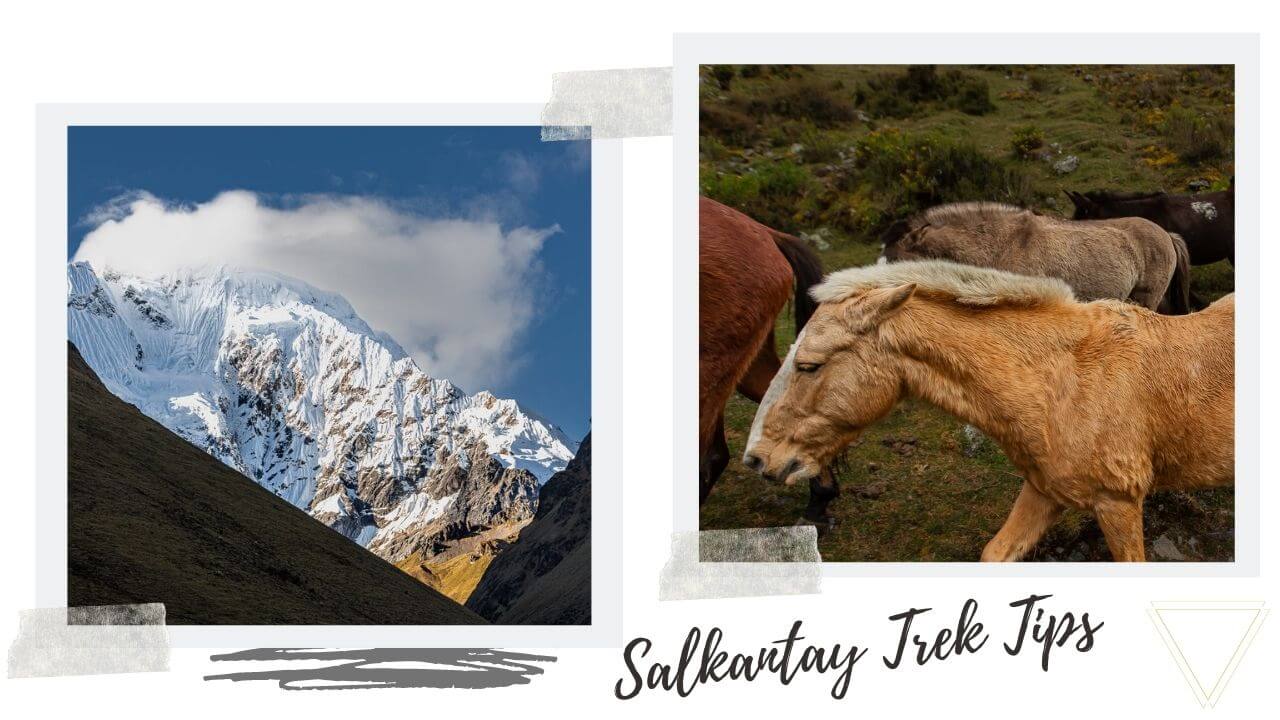
For full transparency, I have sprinkled some affiliate links in this post which gives me a small commission at no extra cost to you if you decided to make a purchase. As always, I would never recommend a product or service that I didn't truely believe in. If you find this post useful, you can also treat Jess to a cup coffee by clicking the icon on the bottom of the page. This will allow me to continue to create more content for you to enjoy ☕️.
About the Salkantay Trail
- Difficulty: Strenuous
- Duration: 4-5 Days
- Distance: 46 Miles
- Peak Elevation: 15,090 feet at Salkantay Pass
They say it’s about the journey, not the destination but on the Salkantay Trail, it’s about both. The Salkantay Trek, also referred to as the alternative route to Machu Picchu, is one of the best hikes in South America.
Unlike the classic Inca Trail, you can hike the Salkantay Trail without a guide. The Salkantay trail takes you through rugged mountain terrain peaking at 15,090 feet and connects Cusco to the Inca citadel of Machu Picchu.
On this hike you will see some of the most beautiful landscapes in Peru. Think snow capped mountains, free roaming horses, alpine lakes, cascading waterfalls and lush subtropical rainforest. Salkantay trekking is a combination of culture and natural beauty that has be well preserved by the Peruvian people.
The Salkantay Trail is truly an extraordinary adventure intertwined with authentic experiences and natural beauty. But before you embark on this journey here are 15 Salkantay Trek tips to know before you go.
15 Things to Know Before Trekking the Salkantay Trail

The Best Time to Hike the Salkantay Trail
The best time to trek the Salkantay Trail is during the dry season from March through October. This means warmer weather at night and blue bird skies during the day.
Traveling here during dry season also means busy season, especially June to August. But that’s a small price to pay as you won’t want to trek during rainy season.
My advice is to embark on this journey during the shoulder season of March – May or September – October. There will be less crowds making it easier to walk up and find a place to stay if you plan on doing the Salkantay Trek independently by staying at guesthouses.
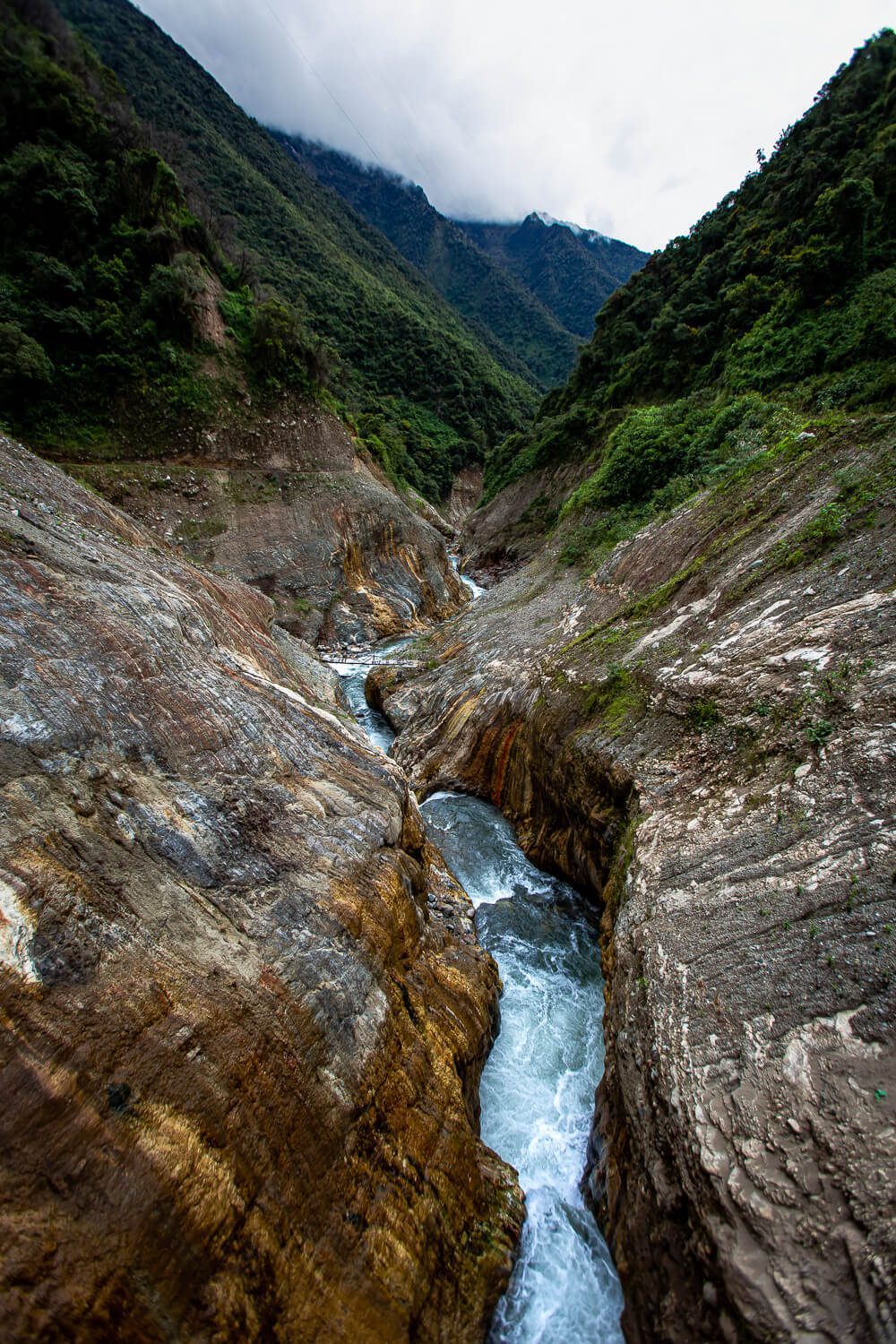
How Many Days to Hike the Salkantay Trail?
The Salkantay Trek can be done in 4 or 5 days. I recommend the Salkantay trek 5 days route as it breaks up the fourth and fifth days and the accommodations on each of those nights are worthy of a stay. We did the Salkantay 5 day trek and were happy that the fourth day was a shorter distance to hike.
Salkantay Trek 4 days | Soraypampa – Chawallay – Lucmabamba or Santa Teresa – Aguas Calientes
Salkantay Trek 5 days | Soraypampa – Chawallay – Lucmabamba – Llactapata – Aguas Calientes

Guided Tour or Go at it Independently
Okay, now you know when to go and how long you want to go, now let’s figure out how to go. 95% of people trek Salkantay on a guided tour . A guided tour is great if you are short on time, don’t want to worry about logistics, would prefer to have your bags carried for you and want to feel more secure with a guaranteed place to stay and meals to eat.
If you’re like me, you’d thrive on the self guided tour if you are up for an adventure, don’t mind being your own donkey and are on a tight budget as you’ll save a good chunk of change doing the trek on your own.
If you are leaning towards trekking independently, this next topic is for you.
🎥 Want to see exactly what it’s like? Check out these Salkantay Trek travel vlog series on Trekking the Salkantay Trail.
- Part 1 Salkantay Trek to Lake Humantay
- Day 2 Summiting Salkantay Pass
- Day 3 The Day that Broke us
- Day 4 Staying on a Coffee Farm
- Day 5 Hiking Huayna Picchu
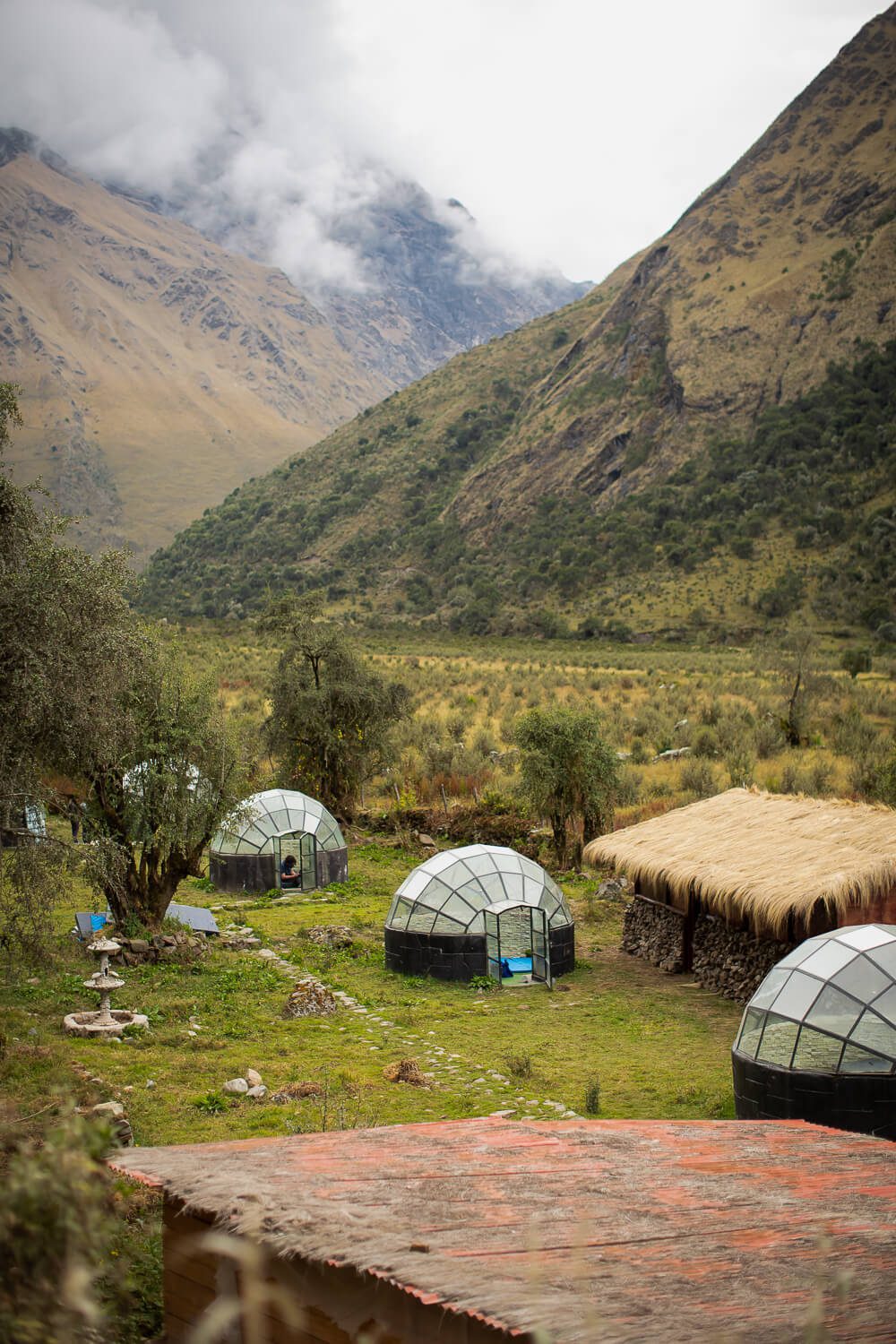
Plan Ahead or Wing It?
The Salkantay Trail goes through several villages so trekking independently allows you to create your own itinerary, decide how many days to do the trek and choose which towns to stay in (or campsites if you choose to camp along the trail).
You can wing it? Meaning you hike until you feel tired and go knocking on doors when you arrive to find lodging for the night. Or you can pre-plan it as much as possible and have a few places booked in advance.
Spoiler alert! Some villages such as Soraypampa on your first night have very little resources online so I would book ahead!
I recommend a bit of pre-planning. Our hostel was heaven sent on our second night which we wouldn’t have been able to secure the day of. You can check out the vlog here to see what I mean.
If you want to pre-plan these are links to places to stay along the trail for each day.
Day 1 | Soraypampa
Most options are in person. We stayed at Backpacker Humantay which was 80 soles per person for a personal pod which included dinner and breakfast.
Day 2 | Chawallay
Salkantay Hostel – There’s only a couple private rooms available and after a brutally exhausting day of trekking, you’ll be crying tears of joy knowing you secured this room…I know I did. It c omes complete with a hot shower, outlets to charge your devices and Wifi which is probably the only time you’ll get it on this trip.
Day 3 | Lucmabamba
Lia & Freddie’s Avocado, Banana and Coffee Plantation is a dream. This place was so wonderful. The property is big and beautiful and Freddie and Lia are the sweetest people. For 15 Soles you can even take a tour of the plantation, roast your own beans and get to drink it. They had plenty of space so I’m sure walking up and asking for a room here would work out too. I’ll link their place on google maps here .
Day 4 | Llactapata
The Llactapata Lodge is a stunning property that looks at the backside to Machu Picchu. It’s the only lodge in the area so 100% book ahead of time. I recommend staying here and making the Salkantay Trek 5 days instead of 4. Lots of tour groups go to Santa Teresa on day 4 of the Salkantay Trek which is close to some hot springs. You can look up places to stay in Santa Teresa here if you want to go that route.
Day 5 | Aguas Calientes
There’s tons of places to stay in Aguas Calientes . We stayed at Gringo Bills and loved it.

Altitude Sickness
The highest point on the Salkantay Trek is the Salkantay Pass which peaks at 15,090 feet. Plus day 1 base camp is in the town of Soraypampa which sits at 12,700 feet. Throw in the side trip to Lake Humantay at 13,900 feet, let’s just say you won’t not notice the elevation.
Before you embark on the Salkantay Trail you must first acclimatize. This means that on the first day that you arrive in Cusco should be nothing more than acclimatization. You should be drinking lots of water and resting. Even walking up and down Cusco’s streets will leave you panting, especially when you have luggage in tow.
I recommend having your first nights accommodation sorted out. This way when you arrive into town you can head straight to your lodging and give your body the rest that it needs. If you are short on time, give it 2-3 days minimum before starting out on the Salkantay Trail.
Here are a few tips to prevent altitude sickness.
- Coca leaves are a traditional way to relieve altitude sickness by chewing it or making tea with it. Coca leaves can be bought at any local supermarket and are available in most restaurants.
- Sorojchpills are pills you can buy at the local pharmacy that help with altitude sickness.
- Muna – is an herb that can be found in the mountains. You can pick it, rub it in your hands and inhale it. Or put it in tea and drink it. It’s also a digestive.
- Allow 24-36 hours of acclimatization before setting off on a hike.
- Ascend gradually.
- Drink plenty of water.
- Avoid booze and cigarettes.
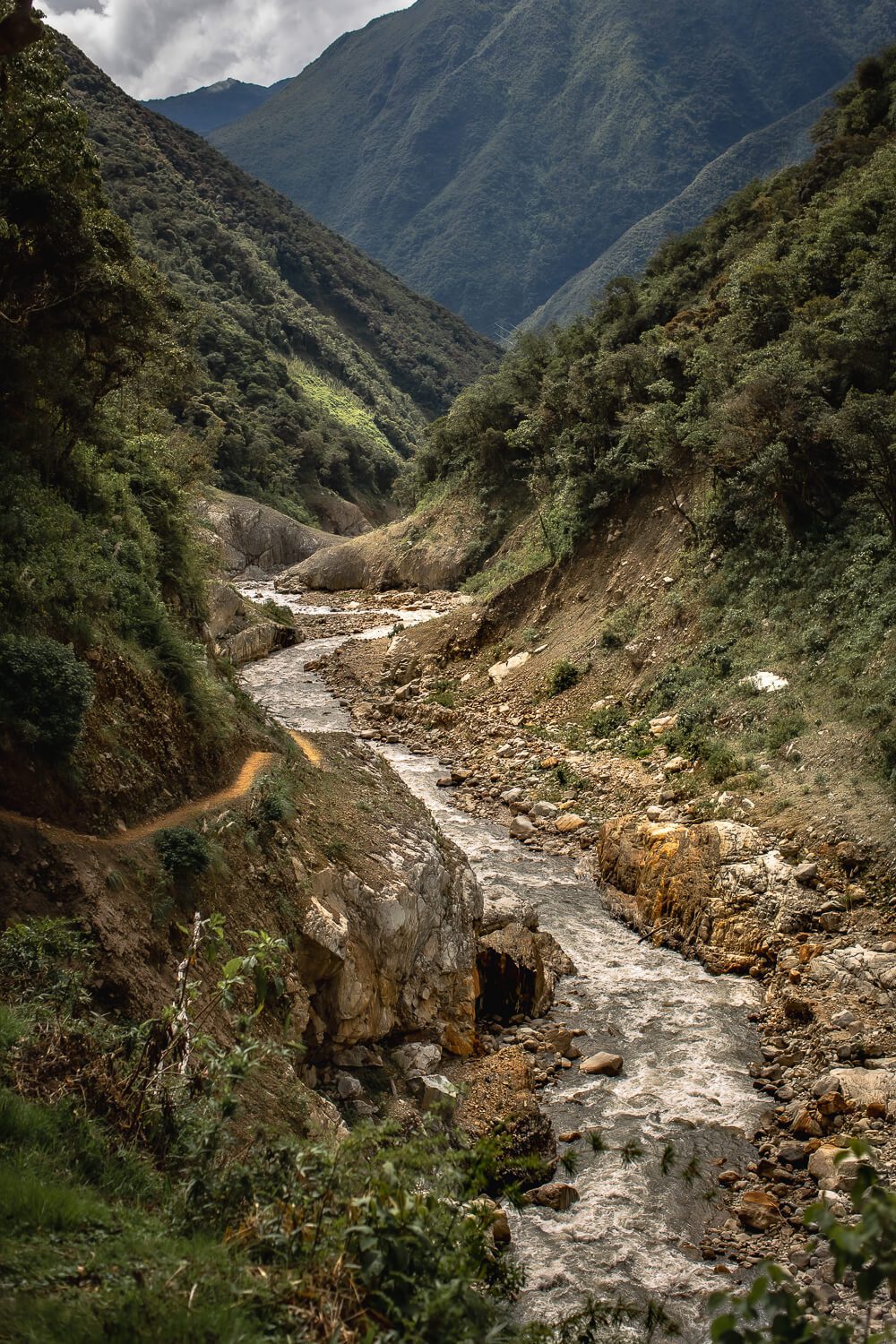
Maps.Me is the Ultimate App
Maps.Me is an amazing app that allows you to download maps offline that is essential for you on this trek or any hike in Peru for that matter. It shows every trail, shows were all the collectivos pick up & drop off stations are, displays hotels, campsites and anything you might need to know along the route. Its amazing how detailed it is and its world wide!
You can save your locations along the way, plan your route and even share it with friends when you are done. Download this app before you start the Salkantay Trail as service and wifi is scarce. This app is truly essential for home and travel. And the best part is, its FREE!
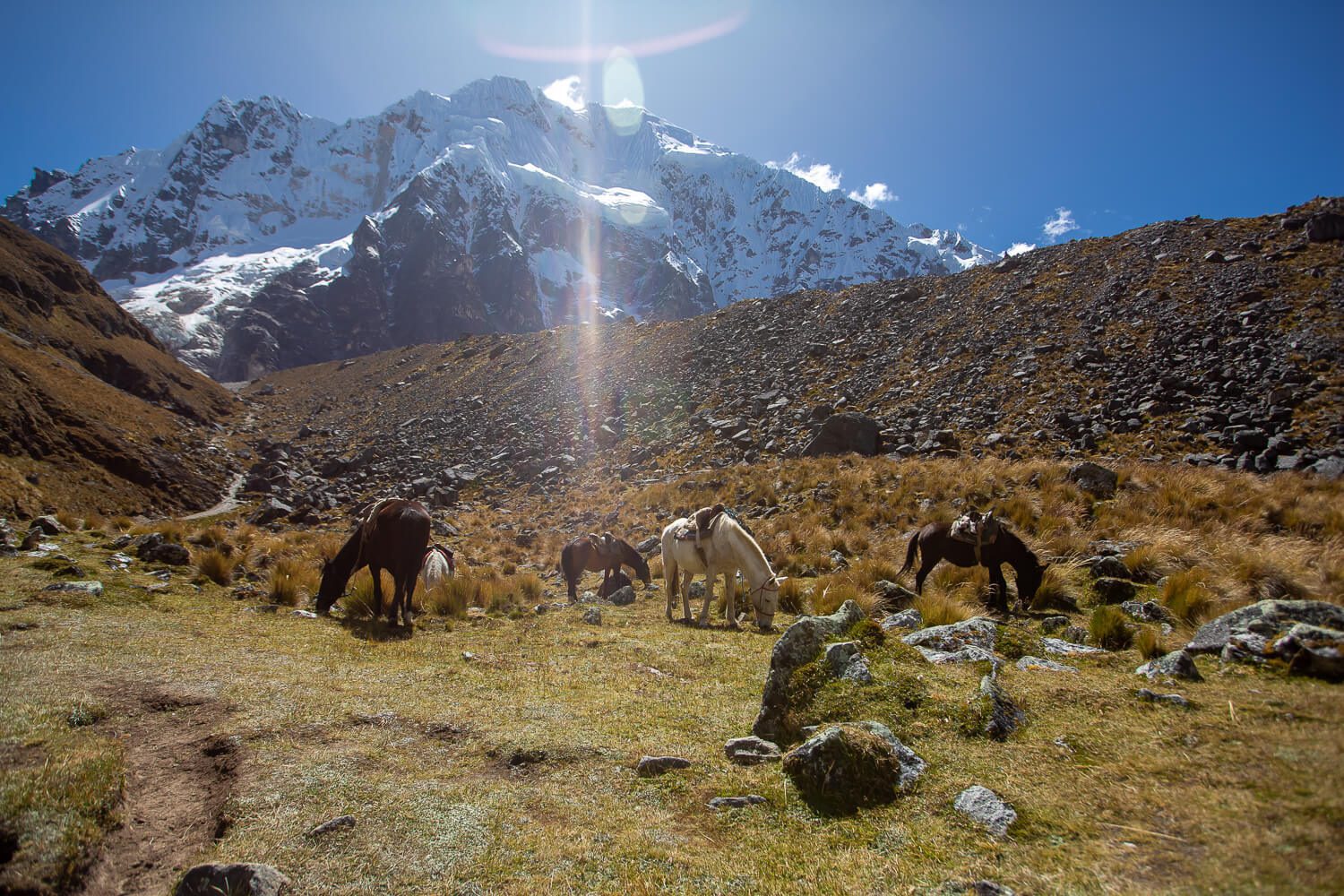

Say Goodbye to WiFi
Say goodbye to WiFi and hello to 1997. So maybe you won’t be able to post stories in real time but this isn’t worse thing. We had wifi on our second night at the Salkantay Hostel and obviously in Aguas Calientes but that is all.

Parts will be Grueling
When I was researching how to hike the Salkantay Trek without guide or a tent, I don’t think I grasped how physically, mentally and emotionally demanding this trek was gonna be.
I don’t know, maybe my excitement trumped my common sense but I’m here to tell you, parts of the Salkantay Trek were hard and downright hellicous . At points all I could think of was “is there a rescue horse?”
I’m an avid hiker but hiking at elevation is not easy and my sea level living ass struggled. If you think the elevation and peaking at Salkantay Pass is the hardest, just wait for the descent down a rocky, trail for what feels like an eternity.
This is where hiking poles come in, I don’t think I would of finished the hike without them. Which brings me to my next Salkantay Trek tip.
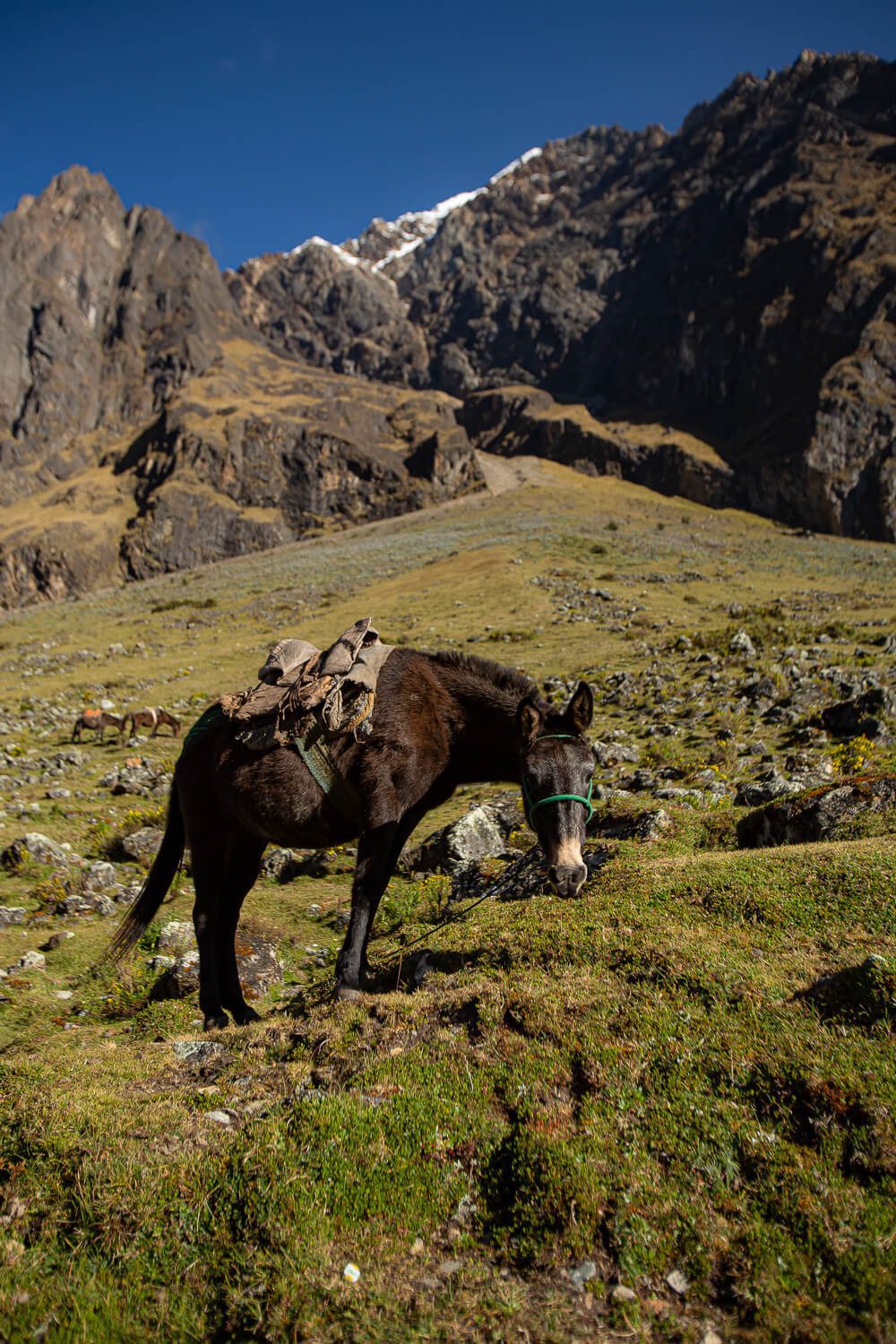
Pack Smart, Pack Light
If there is one thing to know before trekking the salkantay trail, it’s this, pack smart and pack light. I unfortunately learned this the hard way. Especially because when you trek the trail independently, you are your own donkey.
This is such an important and crucial step in preparing for the Salkantay Trek that I dedicated an entire post to it . Check out The Ultimate Salkantay Trek Packing List for exactly what to bring, what not to bring and why.
Here are a few key items you shouldn’t hike without.
- Hiking Poles
- Life Straw Water Bottle
- Bandana/Hankerchief
- Proper Hiking Boots
- Waterproof Hiking Pants
- Passport – you’ll need it to get into Machu Picchu

It’s So Worth It
Parts will be tough, packs will be heavy, there will be times of uncertainty and exhaustion but it’s so worth it! You will pass through and witness some of Perus most beautiful landscapes.
As they say, the views are worth the climb and that couldn’t be more appropriate for this hike. So tighten up your laces, charge your go pro and set out on an adventure that you’ll never forget.
Sign Up & Get a FREE Mini Hiking Maui E-Book! 📗
Subscribe to get the latest content from the blog and your FREE hiking Maui E-Book.
Cash is King
Understandably, there are no ATM machines along the Salkantay Trail until you reach Aguas Calientes, so make sure you bring ample cash to pay for your accommodations, food and victory beers along the way. At least 1200 Soles to be safe per person should do the trick.

Buy Tickets to Machu Picchu in Advance
Tickets to Machu Picchu sell out quickly so securing these in advance is a must, especially if you are traveling here during peak season. I’m talking like 2,3 sometimes 6 months in advance. They only let 2,500 people visit Machu Picchu each day and 500 of those permits go towards trekkers of the Inca Trail (300 of which go to porters and guides).
If you plan on hiking up Huayna Picchu, these tickets need to be booked farther in advance then entry tickets to Machu Picchu. I highly suggest you get tickets to Huayna Picchu Mountain as the views are incredible and it’s another epic hike in Peru.
You also need your physical passport to enter Machu Picchu and to purchase bus tickets to get to the top of the mountain , so make sure this is on your person when you visit the Inca citadel.
Travel Tip: Book the earliest entry ticket to Huayna Picchu at 7 am to beat the crowds to the top.

Arrange Transportation Back to Cusco in Advance too
Transportation back to Cusco should be booked in advance as well. Trains out of Aguas Calientes sell out much quicker than trains coming in. The last thing you want is to be stuck in town after a long, sweaty, exhausting trek wearing the same clothes you just hiked the Salkantay Trail in. But if you do, these are 10 fun things to do in Aguas Calientes .
Cusco Travel Guides: The Best Things to do in Cusco 17 Useful Tips to Know Before Traveling to Cusco 12 Must Try Restaurants in Cusco Where to Stay in Cusco
There are some biting mosquitos at all stops along the Salkantay Trail, especially once you hit Lucmabamba. Wear long light clothing and use plenty of strong insect repellent with strong % of deet. These buggers left big bites, that were extremely itchy and lasted weeks!

Just because it’s cold in the high elevation of the mountains, doesn’t mean that you won’t get sunburnt. Since you’ll be so high in elevation, the sun will hit harder and you’ll burn quicker. Lather on the sunscreen before you trek and throughout the day, your skin will thank you.
Don’t forget a hat and sunglasses too. I love the supergoop sunscreen for my face, its my go to – especially since when I’m at home on Maui . Check out this article for the best reef safe sunscreen products for your face .
Bonus Salkantay Trek tip. Bring your own toilet paper. This goes for all of Peru.
Peru Travel Guides
📍Plan your Trip: The Ultimate Guide to Peru 17 Useful Tips to Know Before Traveling to Cusco 14 Remarkable Things to do in Peru 15 Incredible Places to Visit in Peru 20 Essentials Tips for Traveling Peru 🗺 How long to travel Peru? 2 Week Peru Itinerary ☔️ Best Time to Visit: Shoulder months of dry season – March-May or October-September. 💰 Average Daily Budget: $40 - 50 a day for basic accommodations and sit down meals. ⛺️ Peru accommodation Guides Where to Stay in Cusco Where to Stay in Lima 10 Epic Lake Titicaca Hotels 🪂 Highlights Machu Picchu Best Hikes in Peru Trekking Salkantay Independently Sacred Valley Exploring Cusco Hiking Colca Canyon Homestay on Lake Titicaca Lima's Food Scene Trekking Cordillera Blanca Arequipa Huacachina Desert Oasis 🧳 What to Pack : Salkantay Trek Packing List 🎥 Watch our Peru Series on YouTube 📧 Get on my Email list to see what I’m up to and all the best travel content!
Lastly, if there’s anything I missed that you think would be beneficial to future hikers, let me know in the comments below. I try to keep my guides as up-to-date as possible, so share your experiences and any useful information that could help out your fellow travelers.
If you are planning your trip to Peru, I spent 2 months traveling around this beautiful country so check out my Peru travel page for travel tips and guides.
If you have any questions about the Salkantay Trail, hit me up in the comments below ↓ Happy Trails!
Peru travel inspiration ↓.
Everything to Know About the Colca Canyon Trek
Hiking Humantay Lake without a Tour
Huacachina Travel Guide | A Real Life Desert Oasis
17 Awesome Things to do in Miraflores
Enjoy this Post?!?! Pin in for Later ↓

Hi jess, just watched your salkantay experience and it’s making me nervous! Is there any way to arrange for your gear to be transported between guest houses and still do it independently or can you only do this as part of a tour?
Aloha Becky! I’m sure there might be a way to arrange this for the Salkantay Trail but I don’t know for certain. I’d assume you could but you’d have to probably go through a tour operator.
Also don’t be nervous. I packed terribly (like my pack was way too heavy), I did not train for this trek what so ever and had lots of heavy camera gear with us. Also I live in Hawaii when I’m not on the road and only hike at sea level haha. The beauty, adventure and difficulty make it so worth it.
If you are doing it independently, I’d def reserve those places I mentioned in my post prior to hiking though! Best of luck!
Sounds like quite the adventure. You mentioned you saw horses along the hike. Were there any other unique wildlife in the area that you wouldn’t find in the United States? I’m curious about what high-elevation critters there are (If any)!
I was praying to see a rescue donkey, that’s how tough the Salkantay Trail was but also saw Peruvian Condors!
Submit a Comment Cancel reply
Your email address will not be published. Required fields are marked *
Save my name, email, and website in this browser for the next time I comment.
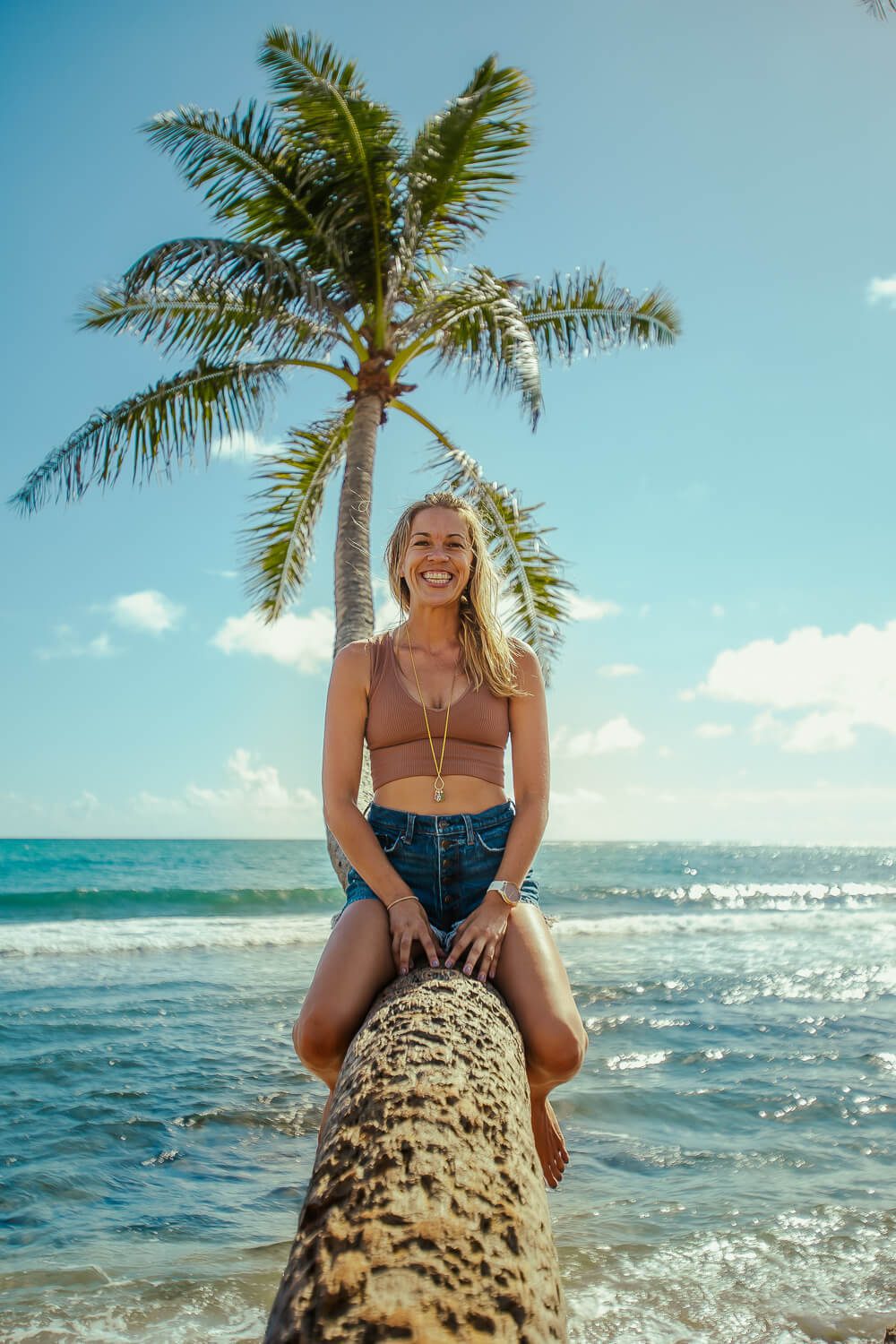
Follow me on social media

Hi, we’re Jess (& Joe). We hope you’re enjoying our free travel guides and tips. If so please consider buying us a coffee ☕️. We appreciate your support!

🎥 Do you follow us on You Tube? Subscribe to follow along on our adventures!
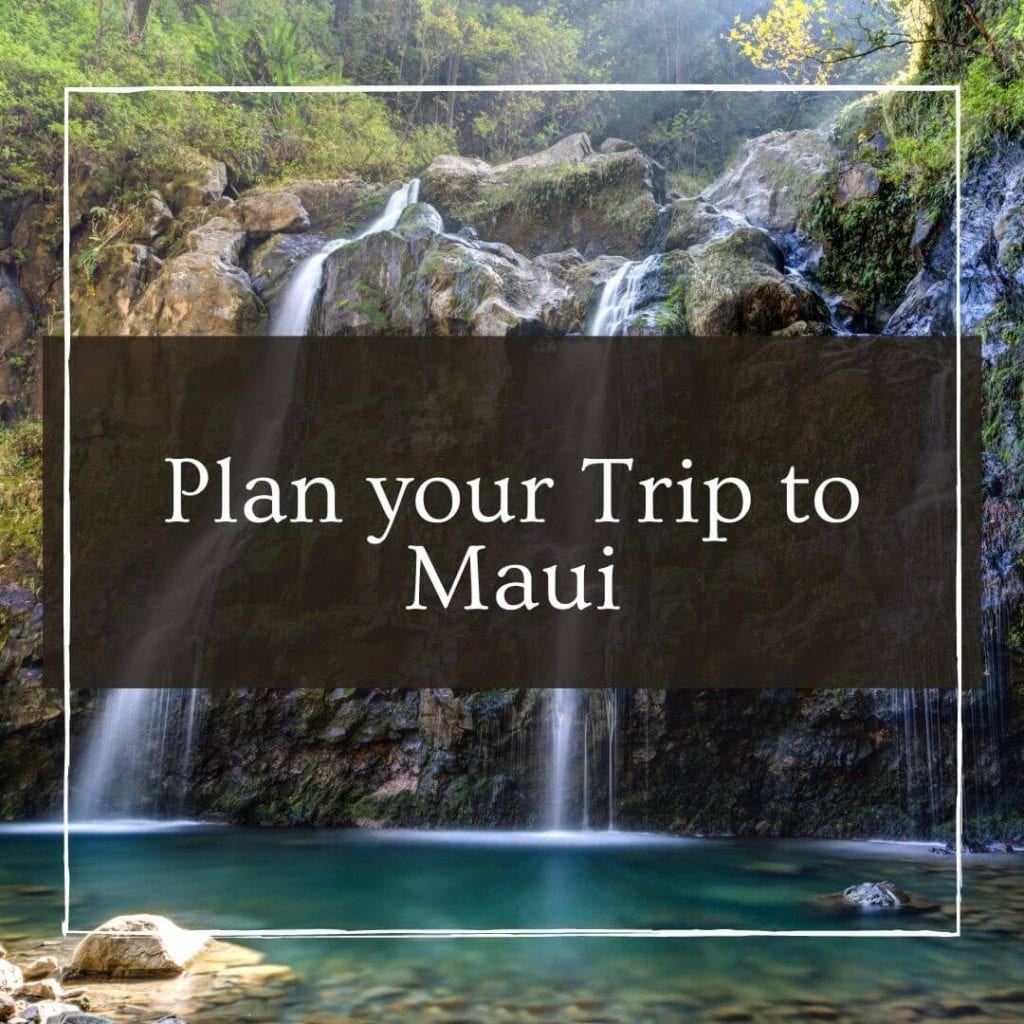
Popular Posts
The Hiking Life
Salkantay Trek: Independent Hiker’s Guide
Posted on October 4, 2017 December 19, 2020 Author Cam 177 Comments
When most people think of hiking to Machu Picchu, the first name that comes to mind is the Inca Trail. And justifiably so. For decades that classic trek was the sole focal point for anyone looking to arrive at the fabled ‘lost city’ on foot. However, as Machu Picchu’s fame increased, so did the quantity of people wanting to experience the Inca Trail. In the early 2000’s authorities installed a much needed quota on hiking numbers, a decision which led to the emergence of the Salkantay Trek on the world’s backpacking radar.
I hiked the Salkantay Trek in August, 2017. The information contained below is mostly geared towards hikers who choose to do the walk independently rather than with a guided group ( Note : Since 2001 it is prohibited to hike the Inca Trail without a guide).
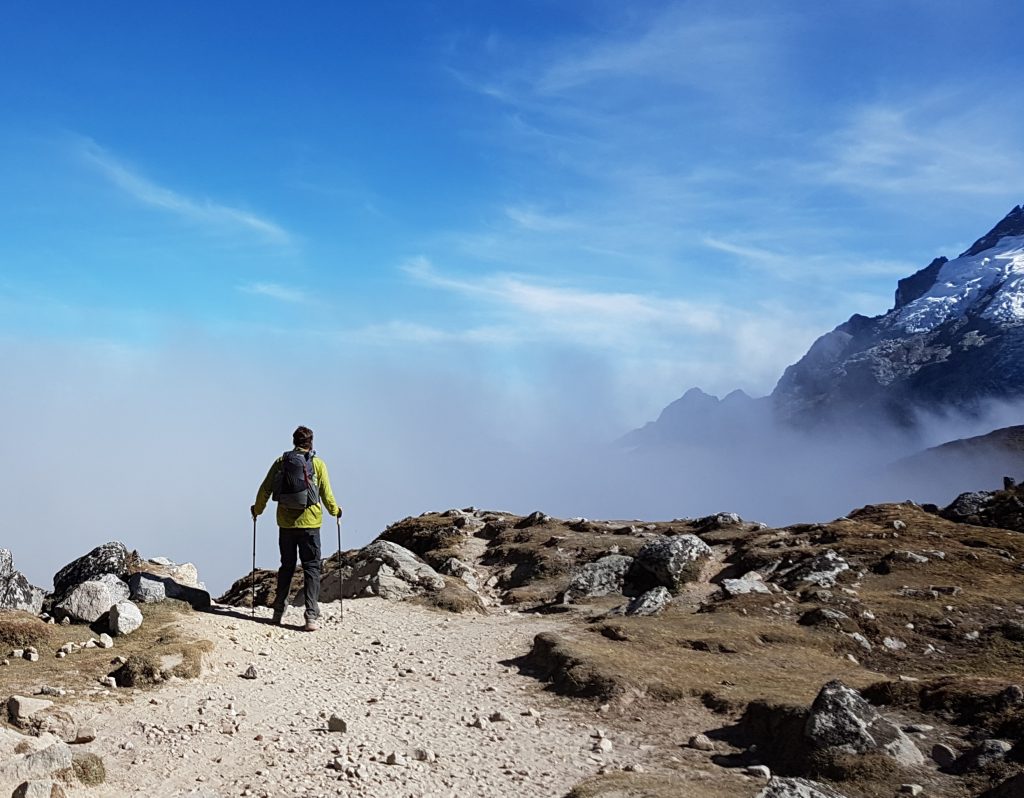
Ryan “Dirtmonger” Sylva descending from Salkantay Pass (4630m/15,190ft).
Distance : 57.2 miles ( 92 km)
Avg. Time : 5 days.
- That is the standard amount of time taken by guided groups . If you are fit, acclimatised and carrying a light pack, there are no real issues in doing the hike in three or four days if you feel like it.
Start : Mollepata
- As of 2017, virtually all organized groups start at Soraypampa, which cuts off some 12 miles/20 km from the overall distance mentioned above. We decided to begin our hike at the traditional trailhead of Mollepata, and hike from there to Soraypampa. From Mollepata you can either follow the dirt road or take a well marked trail (the signed junction is just a few minutes out of town) all the way to Soraypampa.
Finish : The summit of Machu Picchu mountain.
- The traditional end of the Salkantay Trek is the Machu Picchu archeological site. We decided to extend it a little by making the summit of Machu Picchu Peak (3061m / 10,042ft) our finishing point.
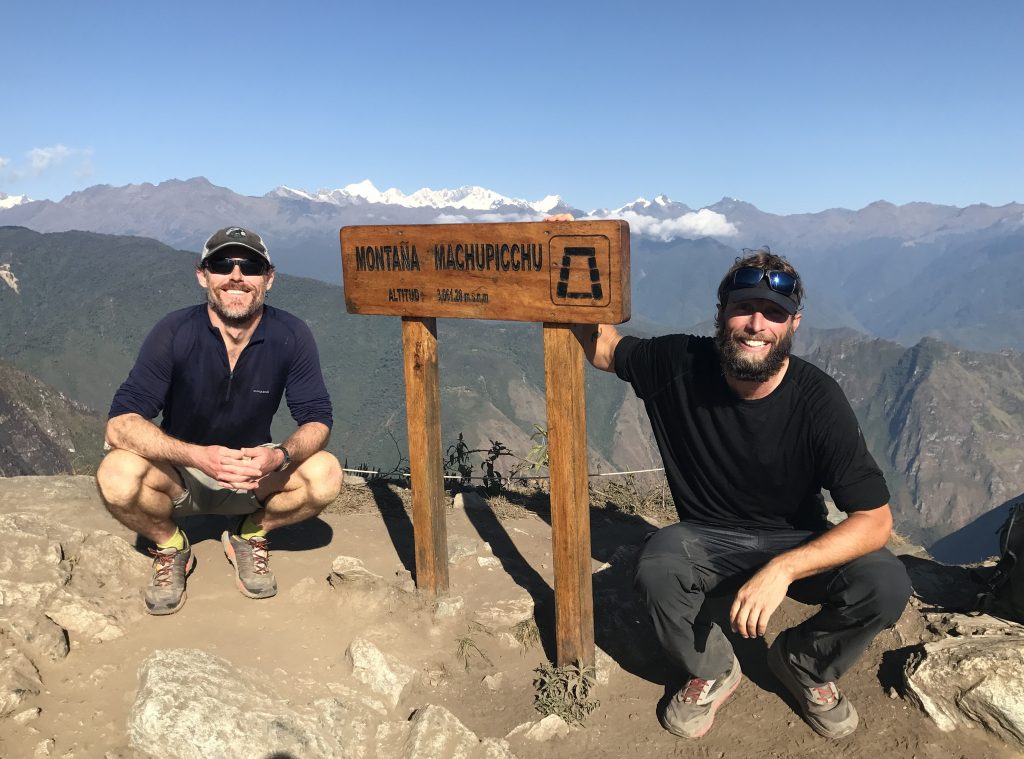
Yours truly and Ryan “Dirtmonger” Sylva on top of Machu Picchu Peak – finishing point of our Salkantay Trek.
Highest Point : Salkantay Pass 4630 m (15,190 ft)
Lowest Point : Hydroelectric Plant 1800 m (5906 ft)
Difficulty : Easy to moderate.
Transport :
- Mollepata – Three hours by regular buses from Cusco. Cost 15 Peruvian Soles (about US$5). As of 2017, you can catch daily minibuses from near the junction of Arcopata and Avenida Apurimac. They usually leave around 7 to 8 am.
- Machu Picchu – Returning to Cusco from the finish of the hike is either expensive or time consuming. The priciest, easiest and most comfortable way is to take the train from Aguas Calientes to Cusco (4 hrs). Alternatively you can catch the train to Ollantaytambo, then take a Collectivo minibus or taxi from there to Cusco (between 3 hrs and 4 hrs total). Finally, the cheapest and most time consuming way to return to Cusco from Machu Picchu is as follows: 1. Walk the 11 km back to the Hydroelectric dam along the railroad tracks; 2. From there take a minibus or collective taxi to the village of Santa Teresa; 3. Catch another bus back to Cusco. This three step journey can take the best part of an entire day depending on connections, and you may well find yourself overnighting in Santa Teresa; not such a bad thing as it does sport some soothing hot springs ( Note : If you plan on taking the train, you should book well in advance ).
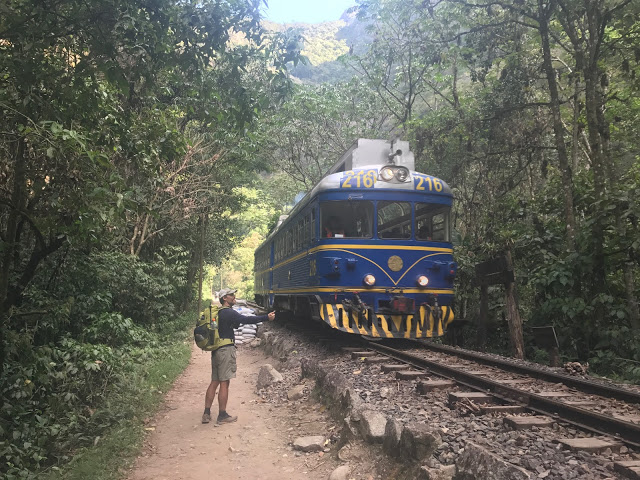
The world’s most futile hitching attempt on the way to Aguas Calientes (photo from Ryan Sylva).
Season : Possible all year, though the dry season between May and October is ideal. During this period nights can be chilly (0°C is common), but days are generally clear.
Guidebook / Maps / Online Information :
- Guidebook : Alexander Stewart’s The Inca Trail (2013) contains trekking notes and basic maps for the Salkantay Trek (as well as other hikes in the area).
- GPS : For GPS details see Salkantay Trek on the GaiaGPS website.
- Blogs by Independent Salkantay Hikers : Sayonarapushek.com, Kevinstravelblog.com, rediscoveringpassions.wordpress.com and last but not least, my hiking partner Ryan “Dirtmonger” Sylva’s personal account of our Salkantay Trek experience.
Permits & Fees : No permits are needed to hike the Salkantay Trek. However, you will need to purchase an entrance ticket to the Machu Picchu archeological site and Huayna Picchu or Machu Picchu peaks. Independent hikers can organise these in advance through the official Peruvian Ministry of Culture website . Alternatively, if you are going with an organised group, the tour company may do it for you. It’s worth noting that as of 2017, you can also pick up entry tickets to Machu Picchu (but not the peaks) once you arrive in Aguas Calientes.
For a thorough overview of the ins and outs of purchasing Machu Picchu tickets, see Thrifty Nomads .
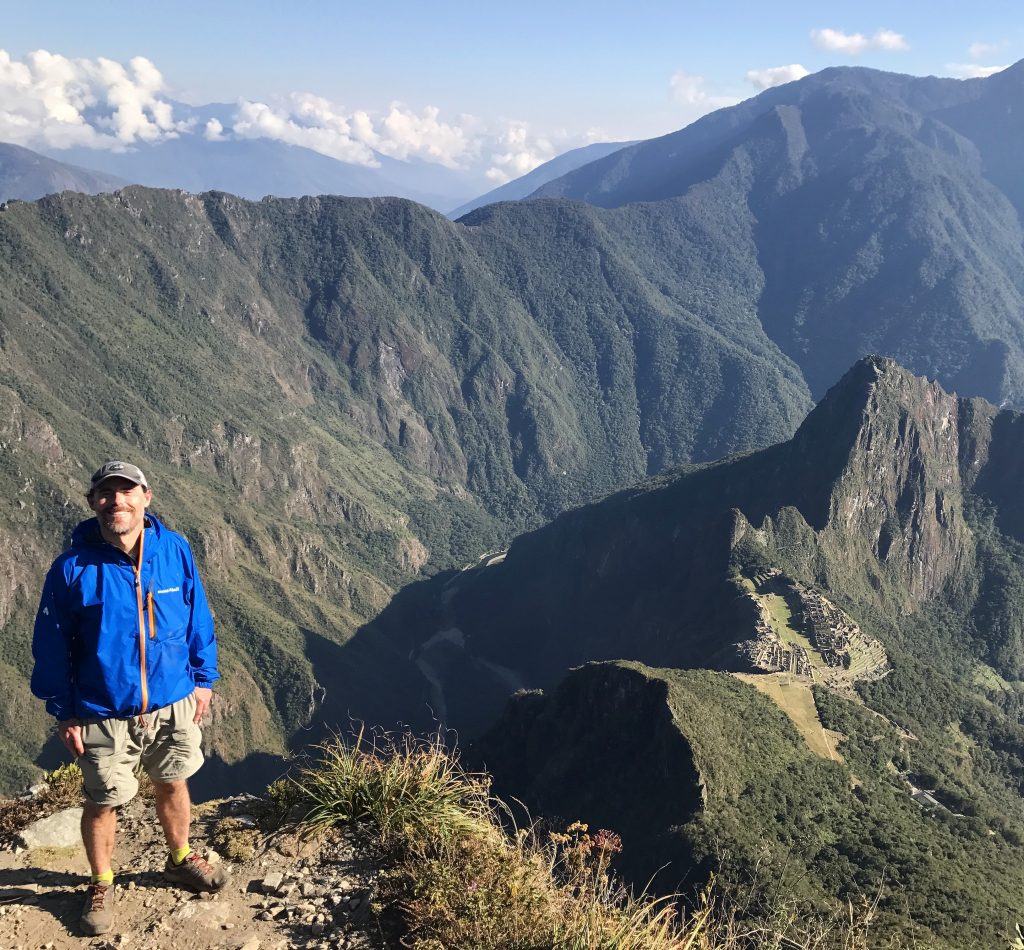
The view from Machu Picchu Peak overlooking the citadel and Huayna Picchu (Photo courtesy of Ryan Sylva)
Food : You have a few options: 1. B ring all your supplies from Cusco; 2. Purchase provisions and organise meals along the way at Soraypampa, Colpapampa and La Playa, or; 3. Do a combination of both. We went with the final option, and enjoyed a few wonderful home cooked meals during our journey. For those interested in taking the same approach, I’d recommend starting the trek with no more than two days food.
Water : Plenty of water available throughout the trek (we never carried more than 1.5 lt at a time), however, due the prevalence of livestock and human settlement it is recommended that all water should be treated.
Guided Vs Independent : More than 95% of hikers tackle the Salkantay Trek as part of a guided group. However, if you have the necessary gear (it’s also possible to rent equipment in Cusco) and a reasonable amount of backpacking experience, there are no issues with doing the hike independently. The trail is easy to follow throughout its course and as mentioned above, you can purchase food along the way (i.e. which translates to a lighter load).
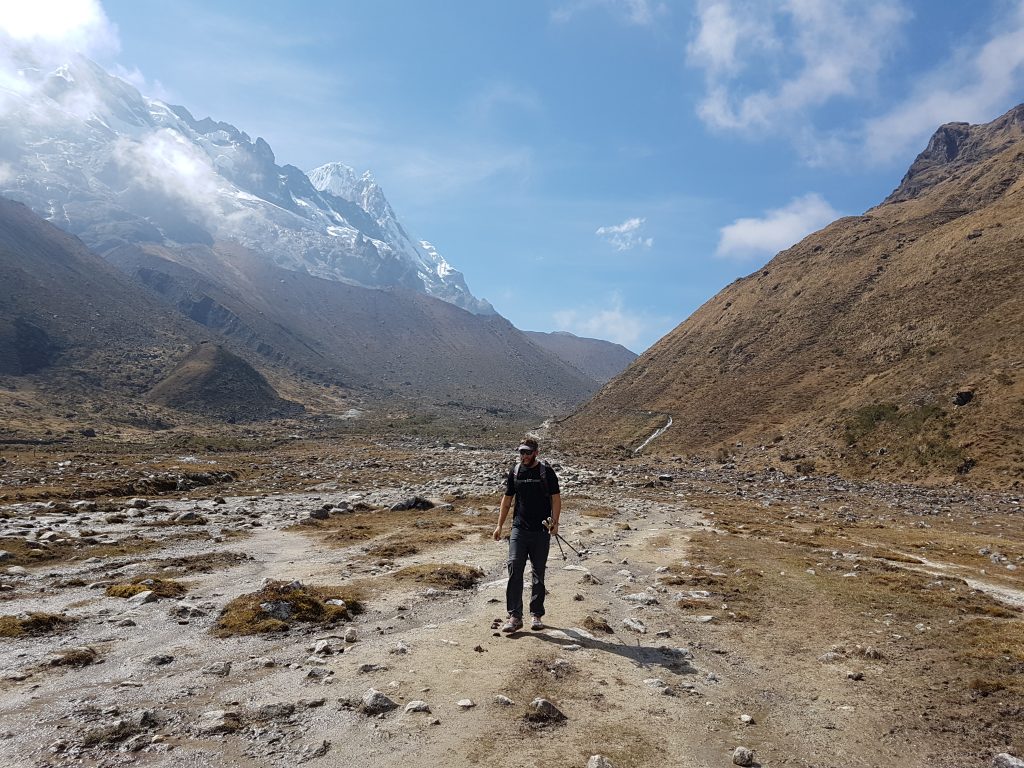
DM descending the Quebrada Humantay.
How does the Salkantay differ from the Inca Trail? The primary differences are as follows: it’s longer, slightly more challenging, less crowded, boasts a greater variation of ecozones, but doesn’t have the multiple archeological sites that you can visit on the Inca Trail. It’s also cheaper, irrespective of whether you go with an organized group or independently; significantly so if you choose the later option. In short, they are different treks that both happen to end at the same spectacular destination.
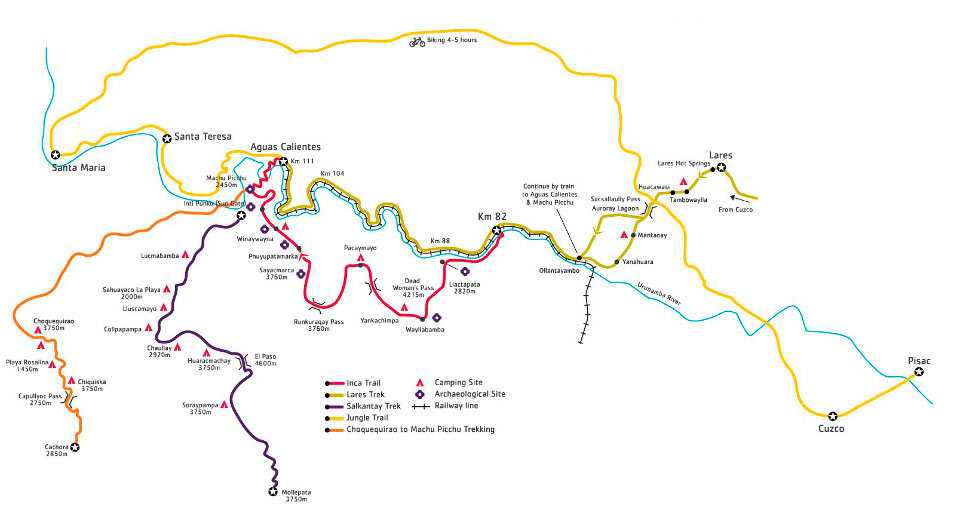
Overview map of different trails to Machu Picchu ( Terraquechuaperu.com )
Trekking Notes :
- Overall Character : The Salkantay is perhaps most notable for its ecological diversity. It traverses picturesque valleys, alpine meadows, goes up and over a dramatic mountain pass and meanders its way through a lush subtropical rainforest.
- The Pass : The high point both geographically as well as scenically is the 4630 m (15,190ft) Abra Salkantay . Upon reaching this spectacular pass, hikers are afforded jaw-dropping vistas of Mount Salkantay (6271 m), a peak that has long been considered sacred by the inhabitants of the Peruvian Andes.
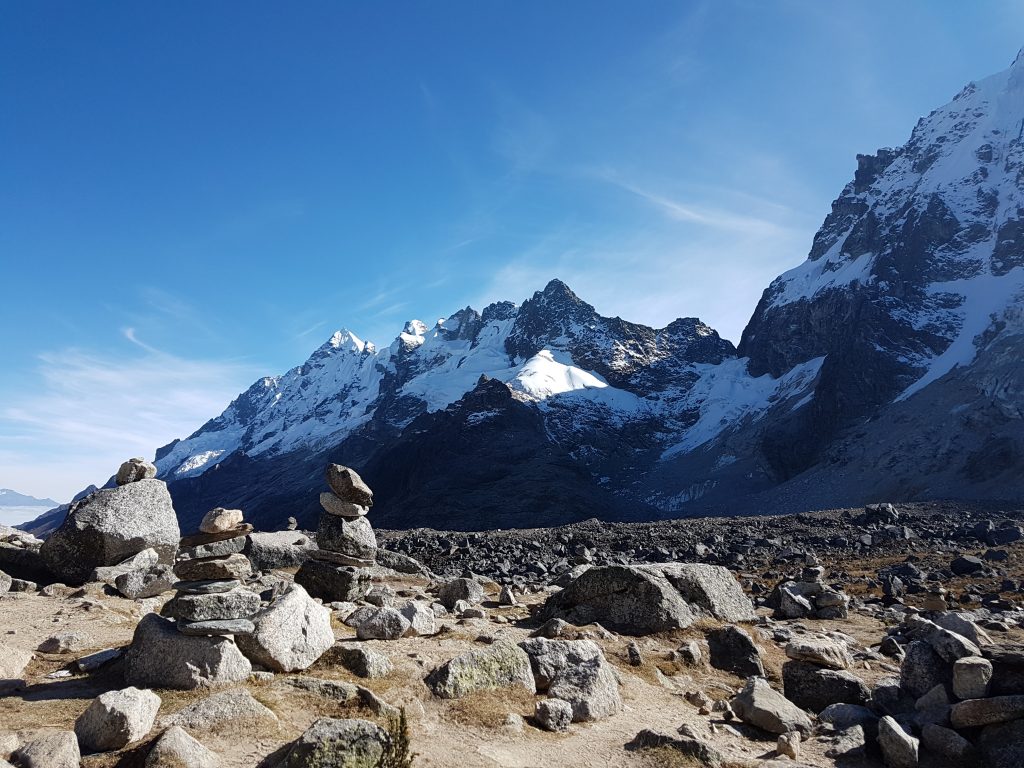
Views from Salkantay Pass.
- Transformation : From the pass, the trail descends more than 2000 meters (6562 ft) into cloud forest. The change in flora, as well as temperature is dramatic. Along the way there are various accommodation/camping options where it is possible to break up the descent (i.e. Huayracmachay, Collpapampa and Challway).
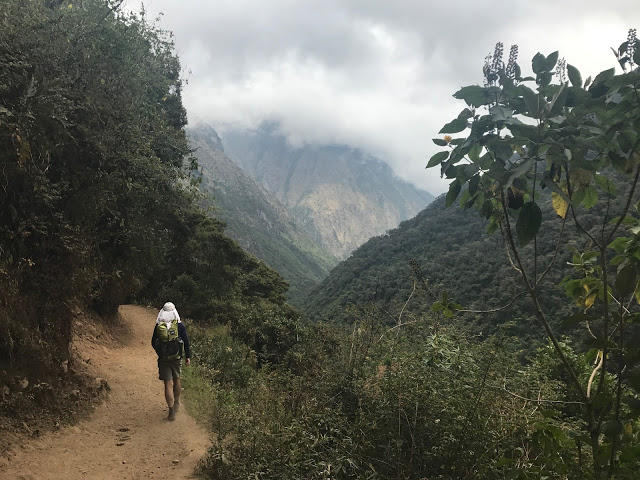
- Ascend to Llactapata : Not long after leaving the friendly village of La Playa, the pathway ascends again via banana and coffee plantations (be sure to stop for a cup or two) to the recently rediscovered ruins of Llactapata. There is a campsite close to the archeological site with impressive views towards Machu Picchu.
- Along the Tracks : From Llactapata the trail goes steeply downhill to the hydroelectric plant. Soon after you pass the railway station where provisions can be purchased. From this point it is a flat and easy 11 km to the town of Aguas Calientes following the railway tracks.
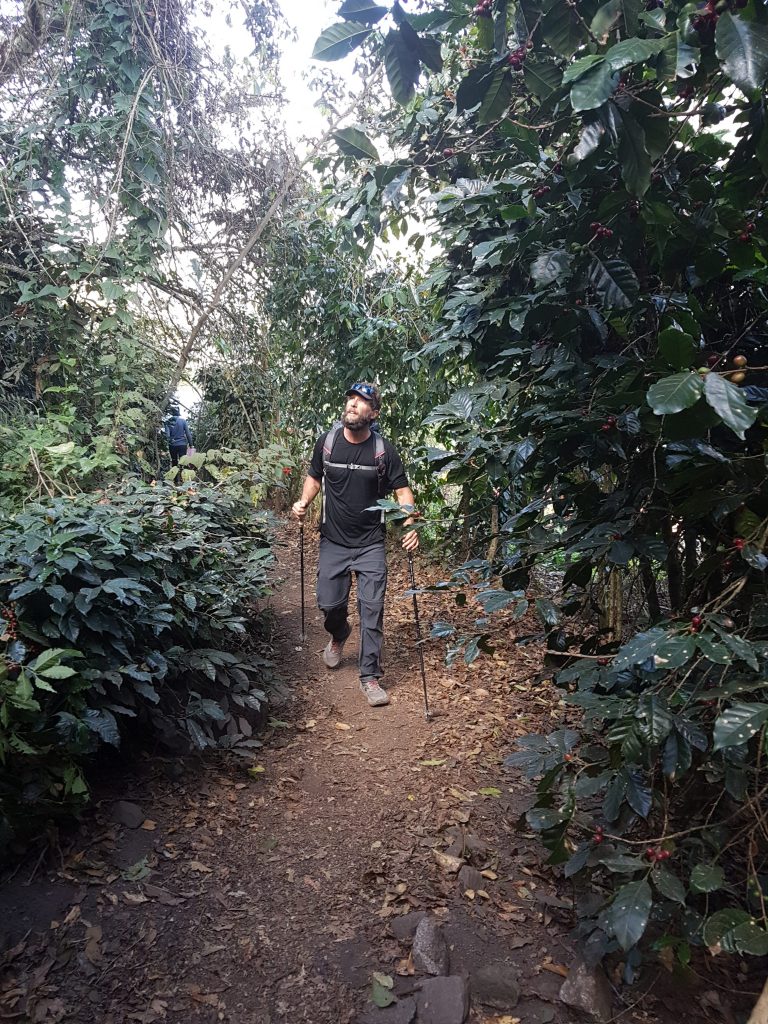
DM walking through a coffee plantation on the way to Llactapata.
- Day 1 : Mollepata to Soraypampa : 20 Km (12.4 miles);
- Day 2 : Soraypampa to Collpapampa : 22 Km (13.7 miles);
- Day 3 : Collpapampa to La Playa : 16 Km (9.9 miles) (** Update – March 13, 2018: According to report, trail between Collpapampa and La Playa is closed due to landslides. No information as to when it will be cleared; in the meantime take road instead. See comments below – Calvin Benson – for details).
- Day 4 : La Playa to Aguas Calientes : 25 Km (15.5 miles) – via Llactapata;
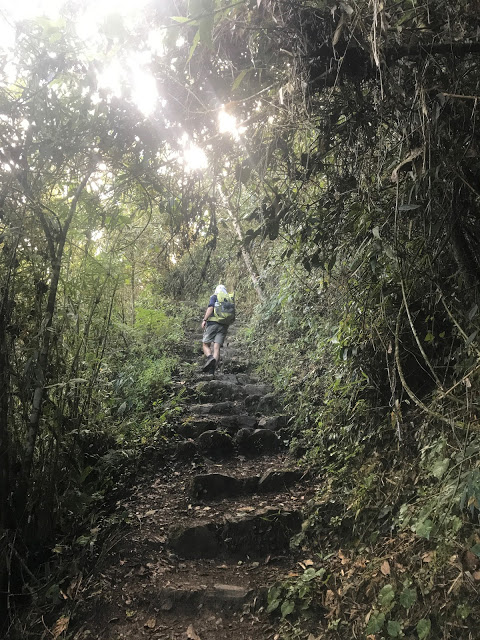
Ascending the steps to Machu Picchu Peak (photo courtesy of Ryan Sylva).
Final Thoughts :
- Go Independent : By any criteria, the Salkantay is not a difficult trek. If you have the gear, are reasonably fit, well acclimatized and know how to follow a trail, I’d highly recommend going independently. It’s a lot cheaper, a bigger sense of accomplishment, more opportunities to interact with locals, and you gift yourself the element of freedom; the freedom to choose where you camp, what you eat, whom you hike with (if anyone), when you take a break, how fast or slow you walk, etc.
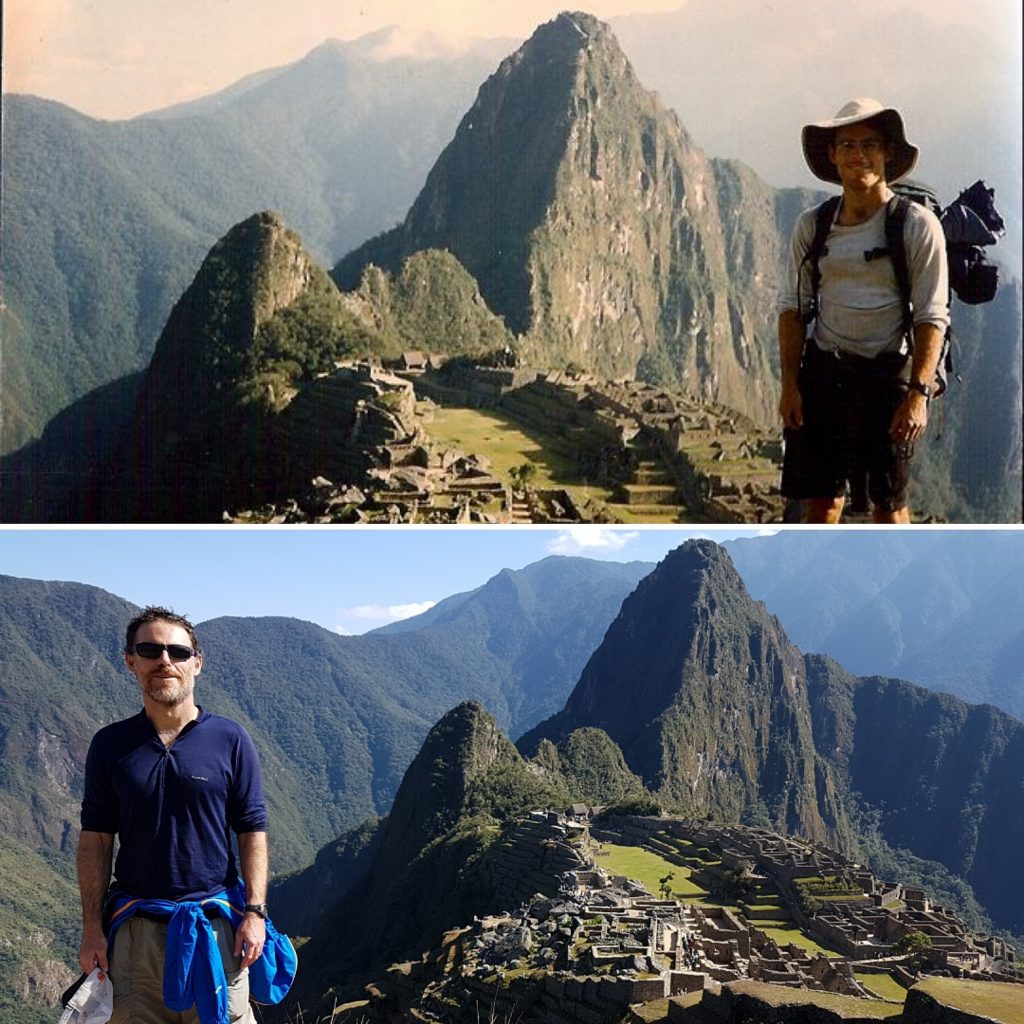
Yours truly at the end of the Inca Trail in 1996, and 21 years later at the end of the Salkantay Trek.
177 Replies to “Salkantay Trek: Independent Hiker’s Guide”
My husband and I hiked the Salkantay Trek in February of this year. In many years of backpacking, we had never opted to go on a guided hike, but the complexity of transportation logistics and the lack of readily available topo maps led us to book a guided trek last-minute. On our hike we saw a few intrepid, independent hikers — my hats off to you and to them!
Though I was skeptical about going with a guide, I ultimately enjoyed it tremendously. We had local guides who opened the door for us to interact with other locals beyond what I believe I would have been able to do, even as a Spanish speaker; the food provided was unbelievably good; we got to sleep in a glass igloo the first night; and traveling for five days with others in our group had the benefit of letting us become more connected with fellow hikers than the more casual connections I’m used to making on the trail.
That said, there are plenty of trekking companies ready to take travelers’ money — and not all are reputable. We did our research and were ultimately happy with Salkantay Trekking Company ( http://www.salkantaytrekking.com ). We were able to reduce the trek price because we had already bought train tickets and permits for Machu Picchu, which brought the cost for 5 days including all food, transportation and lodging about $180.
Travelogue, including GPS track, at http://dearantler.com/askantler/hooves-on-the-ground-peru .
Thanks for the detailed message. It’s always good to have folks that have enjoyed different experiences chime in. I remember seeing those glass igloos you mentioned!
hi guys, i just read your blog after this comment…. how did you manage to get this amazing prize??? i wrote to Salkantay Trekking, and they didn’t allow me to do the same, and offered me a pack of $420, very far from your prize…. can you help me with this? thanks in advance!
Hello Cam! Thank you for this insightful post. I do hope I’ll get a chance to hike in Peruwian mountains once I’m done with Europe ?
Great post,
Did the Inca trail twenty years ago with a guided group. Although I’ve enjoyed the guided tour it was the beginning of many years of independent hikes all over the world. Great to see this alternative track, maybe I will go back one day.
Greets from Belgium, Bart
Must have been a great feeling getting back to Machu Picchu after all those years, particularly getting there under your own steam.
Thanks for sharing an independent approach to Machu Picchu and opening the door for me. I have put this on the list and look forward to some hiking in Peru.
Thanks for all the helpful information, thinking of making this trek without a guide next September. What about campsites along the trail? Do these need to be booked in advance? Thanks again.
Plenty of camping options along the way. No need to book in advance if you are hiking independently. All the best on your trip!
Hey Cam, thanks for the info. I read that the ticketing guidelines at Machu Picchu may have changed last July and you now have to enter with a guide, among other limitations. Was that your experience in August? Any issues there? Thanks again.
It wasn’t obligatory to have a guide at Machu Picchu last August. That said, you do need to organise your permits for the peaks and site beforehand. Be sure to bring a paper copy of your reservation/s to the site if you are going independently.
I’m just wondering how this trek stacks up against the Inca trail in your opinion? Did you find one more enjoyable then the other? Did one have better views then the other? Was one more challenging? Thanks in advance!
Regards, Vaughn
Hey Vaughan,
They are different treks that both end up at the same spectacular destination. I can’t say that one is better than the other. I did the Inca Trail back in 1996. At that time it could still be done independently; these days it is obligatory to go with a guide/group and is quite expensive. The Salkantay can still be done without an agency if you so choose.
In regards to other differences, Inca Trail has some great archeological sites along the way, whereas the standout feature of the Salkantay (at least from my perspective) is the ecological diversity encountered during its course. Perhaps the Salkantay is slightly more challenging from a physical standpoint. The views are amazing on both hikes.
Thank you for such a quick reply! Your article has convinced me to hike the Salkantay trail sometime in the near future. I hope to follow a similar itnerary to you starting at Molletapa and finishing at one of the peaks. I’m unsure whether I would rather finish at the Machu Picchu peak or hike up to the busier Huayna Picchu peak. What made you guys choose the Machu Picchu peak over the Huayna Picchu?
No worries. I had been up Huayna Picchu in 1996, so I thought it would be good to check out the view from the other peak this last time around.
Thank you for the great advice. I’m doing this trek independently with my son (26) in August. Can you tell me whether there are lodges/teahouses on the route as we do not want to carry food or camping equipment. Thank you.
There are some lodges along the way, which depending on availability, you might be able to book in advance. I suspect they are mostly filled up with trekking agency groups.
In regards to food, as I mentioned in the article, you can purchase meals and/or pick up supplies at Soraypampa, Colpapampa and La Playa.
Hi! Thank you for the great information. I will be doing the trek in March. You noted permits are not required, but I read in Alexander Stewart’s book that a permit needs to be purchased for the section from Soray Pampa to Lucmabamba. Did you have to by a permit for this checkpoint or bypass it? Thanks!!
To the best of my knowledge you do not need a permit to hike any part of the Salkantay Trek, with the exception of the finish at Machu Picchu. Best of luck on your hike!
Hi Emily. Are you camping or planning to stay in lodges en route? I’ve been trying to work out accom other than carrying my own and would be grateful for post trip advice/tips.
Hi Andrew, I will be camping the whole time with three other people. I’ve read there can be lodging options along the route. I found a company that you can book through Airbnb that organizes accommodations for you along the trek. It seemed to have good lodging options and to be reliable, but more money than we wanted to spend.
Hey Emily, I am planning to do this trek within the next week and would also like to walk the same route as you mentioned, did you ever find out if extra permits are needed? Any help would be greatly appreciated thanks in advance!
This report and comment section is great, since I am also planning my trip (together with two others) in April! We actually plan on doing the hike ourselves and we were just not sure about water and food supply. But seems that there is plenty of chances to by things along the way, right?
I heard from someone who is currently there, that it is not allowed to go without a guide anymore??She apparently talked to different companies and they told her so. Has anyone information on this? I can’t seem to find anything about this in the web.
Best wishes, Barbara
Hi Barbara,
I’d take that information about not being able to do the Salkantay independently with a large grain of salt. As of the end of last year, it was definitely possible.
I know you’ve said that Salkantay Trek requires no permits. The book you suggest though, “The Inca Trail Cusco & Machu Picchu”, states that you need a INC permit in order to pass through Soraypampa. I was curious on your take on this, and if you guys went through without needing one?
Thanks! And your site is amazing! Derrick
Hey Derrick,
Thanks for the kind words.
We did the Salkantay with basic GPS info we found on Gaia. I haven’t personally seen the guidebook, and I list it because it seems to be the most recent text on hiking in the region. That said, from the information we obtained in Cusco prior to departure, there didn’t seem to be any permit requirements for Soraypampa. Indeed, we overnighted there and no one we spoke to asked us for anything, nor did we see any permit checking booth upon arrival or departure.
Thanks! – I also read that and was wondering if permit is required ? Kathy
Hi there! Thank you for the information. My partner and I will be hiking Salkantay without a guide during the last week of April. For the areas that we overnight in (Soraypampa or Salkantaypampa, Colpapampa, La Playa), do you have to book your campsite in advance? Or can you just show up and pitch a tent? Is there a cost?
Hi Elizabeth,
To the best of my knowledge, independent hikers don’t have to book campsites in advance. Yes, there will be a cost at the places you mention. All the best on your hike!
Hi again! When you say there will be a cost in the places mentioned above, what do you mean? I assumed all dispersed camping on the trail was free. Do you mean if you pay to sleep in a hotel of some kind in those locations?
If you camp at the main sites or in the villages such as La Playa, there will generally be a small fee.
Hey there, me my boyfriend and my mom are planning to do this trek independently in August 2018. The thing that my mom is most worried about is the weather. Did you bring a heavy duty sleeping bag and if not, we’re you cold during the night? She only has a 0 degree Celcius sleeping bag so we’re wondering if she will be fine. Thanks a lot!!
Chances are for a couple of the higher altitude campsites on either side of the pass, your mom may need a slightly warmer bag. Something around -5 to -10°C should do the trick.
All the best on your hike!
My daughter and I plan to do this trek in August as well. I am in excellent shape but have not done a lot of backpacking. My daughter however has and thinks I should have no problem. Once I get there, are there tours we can purchase if I don’t feel I can do the trail over 5 days without a guide?
Hi! Can you provide more info on where you camped/lodged each night? Is camping in augas calientes easy and safe? Did you stay at any unique hotels/hostels on the trail or did you just disperse camp each night?
We are trying to coordinate our camping and lodging for our trek!
Thank you so much!
I generally list an “average time” on these guides, rather than the time I actually took, as I tend to hike a bit quicker than most folks. In regards to our Salkantay itinerary: Day 1 – My friend and I started from Mollepata after lunch, and camped that night at Soraypampa in a designated camping area. We arranged to eat dinner that night with the family who ran the campsite; Day 2 – We hiked from Soraypampa to La Playa where we stayed with some locals; Day 3 – We reached Aguas Calientes at lunch time, and stayed the night at a hotel in town. Hope this helps. Best of luck with your hike.
Thanks, Cam! Did you just find a place the same day you arrived in aguas calientes or did you have it booked ahead of time?
Also, on day 1 and day 2 did you just find those designated spots as you went along or did you already know where you needed to get to those nights?
Trying to gauge how much planning I need to do ahead of time for camping.
No worries. We didn’t book anything in advance and had no problems finding places. There are so few independent hikers, I don’t think it’s much of an issue. On day 2, we actually slept on a big open terrace over a shop. The family who ran the place were very nice, and they offered us a place to sleep, in addition to a dinner/breakfast combo.
Wonderful! How did you find them?
Also, do you know anything about those places that are giant glass domes or the “hotels” that are on the suspended on the cliff sides? Are those along the Salkantay?
You’re awesome. Thank you so much for your help!
It was late in the day when we arrived in the village of La Playa, and we just asked the folks in the shop about accommodation. I saw the glass domes you mention at Soraypampa, but I don’t know much about them. All the best on your trip!
These glass domes are on AirBnb! They look pretty neat, but not the cheapest!
Thanks, Derrick! What do I search for to find them on Airbnb? Any chance you have the link?
Yup, Skylodge Adventure Suites!
https://www.airbnb.com/rooms/2177913?location=Skylodge%20Adventure%20Suites%2C%20Cusco%2C%20Peru
Hi Cam, I’m organizing this trek for september. You say “Day 2 – We hiked from Soraypampa to La Playa” – Really? Is it doable? Soraypampa (3.880 m) to Salkantay Pass (4.630 m) should be around 3h30m-4h00m, uphill for 7 km. Salkantay Pass (4.630 m) to La Playa 82.060 m) should be around 6h-7h, downhill for 30 km.
Those times are general estimates. For hikers that are very fit, acclimatised and experienced, it is obviously possible to cover more ground if you choose to do so. That doesn’t mean I am recommending such a schedule to others; I only mentioned it because Kayley asked specifically where I camped. As I said in the post, the average time to do the trek is five days, and everyone should walk at their own pace.
All the best for your September hike!
I still didn’t thank you for your post and comments!
I normally can hike that long in the Alps, but never tried over 3.300 meters. My only doubt is about the acclimatisation. Before the Salkantay trek, I’m doing 3 days in Arequipa and the Colca Valley (trekking 1.5 days), 2 days in Puno and the Titicaca Lake, 2 days in Cusco. Do you think it’s enough to get acclimatised, according to your experience? I’m 36, in excellent health conditions and quite fit, I normally train 3-4 times a week (both cardio and strength) and can run for 10-20 km (10 km 45 mins).
There is often a big discrepancy between the way different people react to hiking at high altitude, so it is difficult for me to give you the definitive answer you are looking for. That said, it sounds like you will be well acclimatised by the time you start the Salkantay. Here is an article I wrote on the subject some years ago which may be of help: https://www.thehikinglife.com/2015/08/tips-for-high-altitude-hiking-2/
The only way to find out what is the right pace for you is your own experiences. The one thing I would suggest is to err on the side of caution at first, and don’t try to do too much too soon. Listen to your body, and don’t be too wedded to a preset schedule.
Thanks for the great information. I plan to hike the Salkantay independently in May. I would like to climb both Machu Picchu and Huayna Picchu (over two days). Does it make sense to find lodging in Aguas Calientes or are there campsites closer to these two climbs?
You will need to obtain permits for both peaks. Huayna Picchu usually needs to be booked well in advance. The climbs are actually just steep hikes, and both can be done in less than an hour. Aguas Calientes is very close to Machu Picchu; you can walk there from town via a dirt road and a steep staircase.
Hi Cam, at the end of the Salkantay, do you have both options of ascending Huayna Picchu or Machu Picchu?
Are the best views at the top of those peaks?
Is this entire hike worth doing if I cannot obtain permits in time for either peak?
Both peaks require permits. Huayna Picchu is the more popular of the two, so you would usually need to book that one further in advance. If you can’t get permits, I still think the hike is worth doing. The diversity of natural scenery is amazing, and it should still be possible to visit Machu Picchu at the end.
Hi again, Cam.
Just a couple more questions.
How did you get from MP to Cusco? Train or bus? Where did you book your tickets? Also, did you make it to the Rainbow mountains? If so, how did you go about getting there? It sounds like you did it on the cheap, which I love and would like to follow suit.
In answer to your questions: 1-3. A combination of train and bus. Train to Ollantaytambo, then collectivo minibus from there back to Cusco. We booked the train tickets online; 4. We hiked the Ausangate circuit close by to Rainbow mountain, but didn’t visit Rainbow mountain itself ( https://www.thehikinglife.com/2017/10/ausangate-circuit-independent-hikers-guide/ ).
Cam, Thanks for the excellent post. Plan to independent hike the trail in May. Question for you. I noticed on the Peru Rail site there are luggage restrictions on the Cusco – Aguas Calenties line; it says that you can take nothing more than a backpack. If that is true, then how to you get your all your gear back to Cusco. Any thoughts or pointers would be appreciated. Thank You, Chuck
Thanks for the kind words. My friend and I took the train from Aguas Calientes to Ollantaytambo, and then after grabbing an ice cream in town (there’s a really good place just up the street from the station), caught a collectivo taxi the rest of the way back to Cusco. Not too sure about the luggage restrictions; we just had our backpacks from the hike and there seemed to be no issues in regards to size. I should note that we did leave some of our extra gear for upcoming hikes at our hotel in Cusco during the Salkantay. Most of the hotels/hostels there offer luggage storage facilities. Hope this helps.
Best of luck on your hike!
hey Cam, amazing post, lot of useful info! well, i’m thinking about doing this trail first week of may, free & solo and no previous bookings… do you think is crazy? afordable? two more questions: 1. i woudn’t like to take with me a tent to camp, so, is there enough “hostels” on the way to sleep in? 2. you say there is lot of places to take water, but maybe is not really safe to drink it directly without any treatment… what do you reccomend to take? thanks in advance, and congrats again for a great post!
In answer to your questions: 1. The villages have places where you can sleep inside, but I don’t think some of the campsites do (not 100% sure about this point). I would recommend taking a tent if you are hiking independently; 2. Yes, you should take along some sort of water treatment, whether it be filter or chemical. Best of luck on your trip.
I would recommend the Sawyer Mini for filtering water. It always works for me. I’ve been using it for years.
Thank you very much for your tips, Cam & Kaley!! I have one more question: I’m looking for maps, looks like there is not detailed ones… (do you know where to get in internet an accurate one?) My question is: where do the two tracks, Inca and Salkantay, join? I mean: if you choose the Salkantay, you go finally to Aguas Calientes and then you “climb” up to Machu Picchu, but if you come from Inca trail you cross IntiPunku (Sun Gate). The final section of Salkantay arrives to Sun Gate too, where you “join” Inca trail? thanks again!
I used the Gaia map I reference in the article. Both trails finish at Machu Picchu, however, the Salkantay Trek doesn’t go to the Sun Gate. Best of luck on your hike!
The information you have provided is so helpful. Thank you! Do you mind telling me how you got to Mollepata?
Sorry, I see you already provided this information. Thanks! I’ll probably be taking a bus from Lima so will look into bus options from there to Mollepata.
Cam, Do recall how long it took you to hike from Mollepata to Soraypampa? Thanks, CJ
Around four or five hours.
I’d like to mention that as of March 13th 2018, the trail to the left of the river after Chaulley/Collpapampa is not passable and one must take the road if they wish to get to La Playa.
I found out the hard way by hiking about 2 hours in and finding a massive, impassable landslide that had destroyed the path. I backtracked and took the road to La Playa (right side of the river) to find that there were even more landslides further up the trail that destroyed the path (left of the river). I spoke with some locals and they said that during December of 2017, landslides destroyed the path. The bridge to La Playa had also been destroyed.
Just thought I’d mention it. To be clear, to hike the Salkantray Trek, you must take the road that is right of the river once you pass Chaulley and Collpapampa. You may want to update your post to inform future readers, as I used your post as a guide.
Thanks for taking the time to send that through. I updated the post.
YES! Thank you so MUCH! Great for you to pass this on -MUCH Appreciated!! Kathy
Thank you for the update Calvin and Cam! very useful.
Calvin, Thank you for the update on the trail. We are going to hike the Santa Teresa in May. Do you have any maps or description of the road to from Collpapampa to La Playa? Any info would be appreciated. Thanks, Chuck
Calvin, Thanks for the update on the trail. Do you have additional details on the road from Ccolpapampa to La Playa. Any info would be appreciated. Thank You, Chuck
The road is actually very straightforward and easy to follow. As you leave Collpapampa, you are technically on the road already. It is wide and flat and follows the right side of the river. The original trail, which I mentioned has been washed away, was actually a little tricky to find. So you should easily be able to follow the road. It will take you all the way to La Playa and further on.
How was the stretch from La Playa to Aguas Calientes? Was Collpapampa > LP the only section of the trail that had landslides?
Hi Calvin (or anyone who has the info!),
Do you know approximately how many kilometers or how long it took from Collpampa to La Playa using the road? I am planning to do the trek solo and trying to plan my route, but all the tour companies are telling me I should take a bus and the road isn’t pleasant so I can’t figure out how far it is. Thanks!
UPDATE: here Danilovic, live from Salkantay trek, alone-free&wild! this trail Chaullay to La Playa is just REOPENED, i just crossed it. They told me, they opened it only 10 days ago. Still is easy to see those landslides: I must say that, in some places, they made only few footprints to walk across the landslides, so it is a bit dangerous… but is possible to cross. In few days i will write my personal experience in this amazing trek! ?
Hey Danilovic – my husband and I hiked half of the Salkantay trek after joining from Choquequirao independently (I’m currently writing a blog post about our experience :)) and I think we must have hiked around about the same time (from my calculations we were hiking between Chaullay-La Playa on 30 April 2018).. from where I was across the river the hiking trail looked pretty landslidey! I wonder whether anyone has more up-to-date information/photographs of that part, for everyone’s benefit?
What a great feed thank you!! If only i had this kind of info before my hike to Collpapampa, I was lost for over two hours! I regress it was still a pleasurable time and i wouldn’t be hiking if it were not a challenge. I must use this information for future hikes with family and friends.As part of our trip to the U.S we were thinking of exploring new trails, any ideas?
Thanks for the helpful feed!
Jack Djondric-Powell
Hola! Great write-up on your trek. Thank you for sharing. I am set on doing the salkant ay trek solo, but haven’t been able to find any info on hammock camping. From your pictures, there appears to be plenty of trees to hang minus the extreme elevation of the pass (Which I would not be camping on). Any thoughts on hammock camping on this trail?
Thanks, Kevin
Using a hammock would be fine during the latter stages of the hike, but it could be a bit tricky between Soraypampa and Colpapampa.
If you could do that stretch in a day, you might be able to make it work.
p.s. Thinking back, I’m not too sure there would be anywhere to hang at Soraypampa either. Perhaps you could strike a deal with one of the locals that offers accommodation there.
Hi again Cam,
Okay I’m going to be really high maintenance. If my group is going to start it’s trek on a Tuesday morning and arrive in Aguas Calientes by Friday evening (before dark), where should we plan to get to/camp each night? We all have tickets to enter MP on Saturday.
Thank you so much! You’ve been amazing!
Due to the large quantity of messages I receive from folks essentially wanting me to help plan their hiking vacations, I began a trip consulting service a couple of years ago ( https://www.thehikinglife.com/trip-consulting/ ). Detailed enquiries such as yours take a fair amount of time to put together, and I’d like to think my knowledge and experience are valuable. If you’re interested, by all means drop me a line at [email protected] .
Thanks for all the info, super helpful. When you say “carrying a light pack” how light are we taking? What would you recommend to take and/or leave behind to lighten the load. I’m gearing up to do the Salkantay in the next couple weeks and would like to make sure I can do it on 3/4 days.
For the Salkantay Trek, where you don’t need to carry more than a day or two’s food, somewhere in the neighbourhood of 4 to 7 kg total weight.
Are there lakes to view along the Salktantay? If we started at Soraypampa rather than Mollepata would we miss anything spectacular?
Humantay lake is beautiful. There are some nice valley views on the path between Mollepata and Soraypampa, but that section isn’t as impressive as the following stages.
Thanks for all the great info! Just completed our salkantay trek without a guide. Well, this post was our guide. I think the thing most people should be aware of is that this hike is totally accessible. If you show up for the combi for Mollepata with a backpack, the driver knows where you’re going. The towns along the way know what you’re doing. Everyone is making changes to accommodate the tourist industry. There is really no need to worry. Also, they are charging 7-10 sols for campsites and, I guess what would be an entrance fee. We paid as soon as we arrived in Mollepata. And, have no fear, if you’re overwhelmed there are plenty of combis along the road from collpapampa to santa teresa where you can bail out. Thanks again for the info!
Hi. Thanks. Really useful. My Son and I are doing it in August. We really don’t want to take tents but we also want to go independently. Is there anyway that we could stay at hostels or tea houses along the route for the three or four nights?
Thanks for the amazing post! I’m going with a few friends in a week and this article has been one of the main sources of info we’ve used to plan the hike (we are doing it independently). One question though…I’ve read several articles that state the train back to Cusco has a very small luggage allowance. Do trekkers usually take their bags on? If not, what is the best way to get back to Cusco? Also, I would love suggestions on where to store our packs the day of exploring Machu Picchu.
Oh, and last question: for those who’ve done the trail independently, how heavy were your packs? I’m worried about it being too much on the day we hike over the pass. That being said, I’m also from Colorado and have done quite a few 14,000ft peaks with heavy packs, so I probably can handle slightly more than the average person.
Thanks again!
We took out packs on the train and had no issues. That said both our packs were quite small. I can’t speak for other trekkers.
On the day we headed up to Machu Picchu, we stored our bags at the hotel we stayed at in Aguas Calientes. We then picked them up again in the early afternoon before catching the train.
Here’s a gear list for a trek I did in Bolivia soon after the Salkantay. My gear was quite similar for both hikes (the weight was slightly less for the Salkantay): https://www.thehikinglife.com/2017/11/gear-list-cordillera-real-traverse/
All the best on your hike.
UPDATE: Path to the left between Collcapampa and Playa is again through. I did it few days ago 😉
We are in Cusco. Question for you, day 1 did you go through Marqocasa? The guy at speedy Gonzalez said that you hike through Cruzpata? Thanks
No, Cruzpata no. Look in and use app “maps.me”, there is right map of the trek, according to which I went ?
Does anyone have a solid recommendation on vaccines? I’ve read conflicting recommendations. Some sites say if your hiking to Machu via the Inca, you don’t need Yellow Fever, etc., but then others say you need them. I know this trek spends some time in the jungle, so assuming its better to get them all?
Hi there I wonder if someone could help me? I am planning on doing Salkantay to Machu Picchu early August. I am very keen to go solo. Although the igloo accommodation looks exquisite, I am excited to “rough” and take the challenge of accomplishing this without a guide. I am not an experienced hiker and would like to know how easy the trails are to follow. Are they well marked? Can you see the paths? Would it be handy to travel with a Garmin (GPS tracker)? Also, does anyone know where the best place to rent equipment is? Many thanks Linds
My boyfriend and I just did Salkantay solo at the end of April. Here’s some stuff that I learned: – gear rental: I rented a sleeping bag and backpack and bought rain pants from a place that I think was just called Salkantay Trekking (it had Salkantay in the name) on Calle Suecia in Cusco. The street’s kind of behind and to the NW of the Plaza Mayor. Their gear was great and way less expensive than any other place; you pay a ~100 soles deposit and the rest of the stuff was like 10 soles a day, may have even been cheaper. – Once you get on the trails, they’re very easy to follow. It’s pretty much one main route from the trailhead around Mollepata to Aguas Calientes. For detailed trail writeups, get the recommended book mentioned in this post by Alexander Stewart. – A note on that book: I discovered that those hiking time estimates are either optimistic or for people who get out and do trail hiking A LOT. I’m an average in-shape person — I exercise regularly but hadn’t done a ton of multi-day hiking before (like, one trip), and I particularly have trouble with my knees on descents which slows me down. But even the ascents (which I don’t have trouble with) were WAY faster estimates than we did. I recommend hitching a ride from Mollepata to like halfway to Soray Pampa… that will get you a good day. We camped at Salkantay Pampa and it was lovely, 10 soles. Day two is the roughest with a lot of descent. Note that on day 4, the hiking time from La Playa to Llactapata is around 3.5 hours, not 2 like the townspeople will tell you.
I don’t think a GPS is necessary on the hike — what with all of the other groups going out and the straightforward nature of the trail, it’s pretty much impossible to get lost.
Hi Elizabeth Thank you for your in depth reply, much appreciated. Going on your experience and advice, I think I shall attempt this solo! ? I can Always change my mind I guess. Great, I will get the book and get planning! So exciting. Thank you! Linds
Hi. Your reply has been the most helpful to me as a novice independent traveller. Please could I ask more! The fitness side is ok for my son and I but not the logistics. We desperately want to do this trek independently but have only done treks where tea rooms/hostels were available en route previously. We have never camped, have no tent, never cooked our own food etc. Question is, if there are no hostels/tea rooms just how difficult would it be for us to carry a tent/food and do it ourselves. Our only alternative seems to be going on a guided four day trip which will be around $250-300 each and probs not as much fun. Thanks.
Glad some of my experience can be helpful. So, my first question is why do you want to do this trek solo? If the reasons are financial, and you currently have no gear, you will probably (most likely) spend more money getting all of your gear together than you would spend by going with a group. If you guys like trekking and you plan to do more of this in the future, it pays to buy your own gear, and to invest in good quality tents/sleeping bags/cookware — it’s possible to get this stuff on discount (REI garage sales and eBay all the way!) but even still I would be very impressed if you got *everything* for the cost of both of you going with a group.
If you’re planning on renting all gear: based on our experience, I would be hesitant to again count on getting *everything* from local Cusco shops. Going Salkantay solo is comparatively uncommon and most of the gear shops do not cater to DIY hikers. So you can definitely get some good gear but it takes time. (Also one of you should be able to speak Spanish.) It took us the better part of a full day in Cusco just to get a good deal for my backpack and sleeping bag and then to arrange transportation to Mollepata, so if you don’t want to drive yourselves crazy I would arrange several days in Cusco to get your rental gear together. The shop that we eventually settled on was the only one that even had a backpack that was relatively large enough — most of them rent bags that are more like day packs. My boyfriend owns an enormous Osprey (I think it’s 100L?) pack and took around 65% of our gear in that — if we’d had to rent both of our packs, we wouldn’t have had enough space.
On the experience side: if you guys want to do this solo I would definitely recommend doing another multi-day trek before you head down to Salkantay so that you have an idea of what it’s like to cook your own food, set up, break down, etc. My bf was an outdoor educator for 10 years and I speak Spanish so we made a good team — we would have survived if we lacked both of those things, but I think the trip would have been way more stressful. A way to counteract that would be to plan more time on the hike.
There are definitely places to stop and camp along the way. Night one: Soraypampa is basically a little village that exists for hikers. You can camp there/possibly arrange food. Night two: Collepampa is the same setup. Night three: same with La Playa. Or you could hop on one of the busses with the tour groups and spend the night at Santa Theresa if you want to skip Llactapata on Day 4. If you’re going DIY though I would definitely bring your own food and tent/tarp as a backup.
Another note on the trip: if we were to do this again, I would add another day at the end. (So trek for 5 days and do Macchu Pichu on the 6th.) I would keep Days 1-3 as recommended in the guide book. On day 3 (we did this), we kept pace with the trekking groups and hopped on a bus to go to the hot springs at Santa Theresa. Then we arranged a ride back in the evening to La Playa.
Day 4 was actually pretty brutal for me because my arches had collapsed by midday, and the final trek from Hidroelectrica to Aguas Calientes — which is literally the easiest part of the trek (and super pretty) was absolute agony for me. Like, I was weeping from pain for the last 6 miles! (Should have taken the train.) What I would have done if we’d known:
End of Day 3, get dropped off at the trailhead to Llactapata coming back from the hotsprings. This town is called Lucmabamba and it’s actually a collection of tiny coffee farms/hostels all the way up the mountain towards Llactapata. All of them look incredibly inviting and it doesn’t look like a lot of trekking outfits spend the night there so I think you’d be good arranging lodging the day or evening of.
Day 4: hike to Llactapata, get there midday, and spend the rest of the day/night at another lodge that is kind of on the other side of the trail past Llactapata. (I forget the name.) There are clearings, beautiful wooden houses where it looked like you could stay, and seemed like you could buy food there too. Spend the rest of the day lazing.
Day 5: Continue on down the mountain and make your way to Aguas Calientes.
I think you can do this DIY, and the benefit of it is not a lot of guided tours take the above itinerary. Most do not go to Llactapata. You will run into/be walking alongside a *lot* of people until you get to this part of the trek. However, I would recommend buying some major gear before you head down (at least one pack, tent, clothes, cookware at least) and getting in another multi-day trek first.
I hope this helps!
Thank you v v much for the time and effort you have put into your response. All the info will be really useful. I think that you have convinced me to go with a group but to try and keep it small and as authentic as possible.
Thank you again.
Your post is very helpful for me in a similar situation (actually worse since I don’t have any companion).
After Elizabeth’s response above I more unsure on what to do… My situation: No companion, no experience with overnight trekking; just guided 2-3 day tours in Thailand, Philippines with village homestays. I do not own a tent or sleeping bag and don’t intend to buy one (just too much gear for the rest of travel). Thus entirely solo trek might not be advisable.
Considerations against guided tours: Cost, less interaction with local, too much talking.
My guide book indicates that hiring a donkey plus driver is 80-100S/d. Would that be an alternative to a guided tour and would he be able to help me? Would I be able to sleep in hostels, homestays, … all along the way?
Thanks in advance!
Regards, Marcus
I don’t know anything about hiring a donkey and driver so can’t comment on that approach to Salkantay. I do want to say this about Salkantay: it is GORGEOUS! It was one of the most amazing things I’ve done in my life. It’s totally worth it. However, no one is going to be avoiding crowds on this route. You’re going to be running into them or keeping pace with them for most of the days of your trek. I also don’t know if there’s necessarily more or less interaction with “locals” based on whether you go with a group or DIY. Guides are also locals and can tell you a lot about the area and introduce you to people if you don’t speak Spanish. The level of your interaction with other people mostly depends on you and how many conversations you want to strike up. The homestay/donkey experience definitely sounds cool but more than likely you’re going to be keeping pace with dozens of other trekkers for most of the route regardless of your travel method. (The only place other trekkers really seemed to thin out was through Lucmabamba/Llactapata.)
Thanks a lot Elizabeth!
Actually I was not sure if I go to Southern Peru at all due to all the crowds. Sometimes the second best sights are actually more worth it because they are far less crowded. Your description does sound good!
Happy travels!
Anyone who’s gone recently, how has the weather/temps been??
Hi Cam, is it relatively easy to find food at every campsite or you can get something just at Soraypampa, Collpapampa and La Playa? I mean simple dishes such as boiled/scrambled eggs, some meat, bread, milk, beans, quinoa, veggies and fruits.
Thanks, Alessandro
Hi Alessandro,
We got meals at all the places you mentioned – Soraypampa (dinner day 1), Collpapampa (lunch Day 2) and La Playa (dinner day 2/breakfast day 3).
My wife and I would like to do this trek in July/August preferably independently. Can you recommend somewhere to hire tent and or sleeping bag? We did Annapurna in April but sent our sleeping bags and other gear home after ? Much prefer to do these things independently to both save money and generally go at our own pace. Allan
I’m going to do the Salkantay track independently in July. But I did not want to take a tent. Are there simple and cheap places to stay on the way (local houses, for example)?
I have two more questions:
1- I will go to Peru on September and, besides one pair of trekking sandals, I will take with me one single pair of shoes. What do you suggest between Goretex low trekking shoes and Goretex mid trekking boots? I will visit both cities and towns (Lima, Paracas, Nasca, Arequipa, Puno and Titicaca, Cusco and Sacred Valley) and will do a couple of treks (Colca Valley and Salkantay). Is it OK to do the Salkantay in low trekking shoes?
2- I will do the Salkantay trek solo, without any organized tour. Will it be possible to recharge devices during the trek (phone, camera, etc.)?
In answer to your questions: 1. Yes, low trekking shoes are fine; 2. It depends on where you stay. You definitely can in La Playa and Collpapampa.
This is really useful information! Thanks so much for posting your advice/experiences!
I have a question about the map, or the lack of maps. Am I overestimating the wilderness aspect? The Gaia-map you linked to, is it really sufficient for the trek? Not worried about the trek, used to being outside.
It is a very well trodden path. The Gaia map should suffice. The basic map in the Stewart guidebook or even the old Lonely Planet “Trekking in the Central Andes” could also help.
I did the Salkantay Trek in August 2017 as well. I was part of guided group, and we started at Soraypampa, but I didn’t feel like I missed out not doing it independently.
I do think in a few years time I would like to do the trek again, but next time will do it independently.
Cam, I’ll be taking Salkantay unguided with 65L pack. Can you confirm from your most recent experience the likelihood park officials deny bag entry? And the presence of lockers/storage nearby entrance if bag denied? As for trekking poles, do you recall their making an exception if ascending MP Mountain? Thank you
I’m sorry but I can’t help on this one. We stayed in Aguas Calientes before heading up to MP at dawn the following morning. We left our packs at the hotel. Neither my friend or myself were using trekking poles.
Hi. Just completed it in August. You can leave your pack with the guys in the bottom hut before you ascend to MP main entrance. The hut is like a check point at the very bottom right hand side bridge. To the right of the hit is a cafe, they will also take your pack and hold it until you descend if you discretely ask them. Both charge an unofficial 5 Soles (£1.25). I also climbed MP Mountain (don’t underestimate it, 1.5 hours up, 1 hour down) but did not see any poles at all. Kind Regards.
Andrew, thank you for your detailed and timely answer. Most helpful!
You can bring poles up as far as the bag check (I had to check my own photos to be sure…yep I had em) but not past that point. I think the authorities will make an exception for the physically challenged or elderly…so if you could convince them you’re an infirm long distance trekker you might get in with a pole. ? Good luck!
Thanks, Brian!
Thank you for all your information. My goal is to hike this trail in May by myself. I was wondering how many other hikers or groups did you see during your 4 day hike?
We saw a bunch of groups at Sorayapampa, and then a handful after that. In regards to independent hikers, I’d say they represented roughly five percent of the total folks we saw hiking the Salkantay trek.
All the best on your trip!
Thank you Cam for this website! I did this hike unguided in August of 2018 with my two boys and their girlfriends, and I read and reread this site before we left. Hardest, yet most rewarding thing I’ve ever done in my life. I’m 64 years old with an artificial hip. I’d say 95% of the trekkers were guided. It gave me a lot of satisfaction to be carrying a fully loaded pack while constantly seeing much younger people with their day packs. ? Campsites are fairly obvious. Take the altitude medicine. Chew the coca leaves! The app, maps.me allowed us to have an offline map that REALLY helped. I wish I had brought little souvenirs to hand out to the amazing people that helped us along the way!
I’ve been following this thread for a few months as I plan to hike this trail alone next September. Thanks for the tips about the app and other comments. I can hardly wait!
Good for you Kimberly! I really wish my Spanish was better when I did the trek. Expect rain, usually late in the day and at night! Jerky and Snickers were soooo good on the trail, and I’m not much of a candy bar guy. You can buy Gatorade along the way too, which are delicious in the middle of a long day’s hike. If you bring cash from the US to exchange in Peru, make sure the bills are pristine, no folds or tears, they won’t take them. Have fun!
Those are great tips, thanks! This trek will be the first thing I do when I get to South America, so I will bring lots of Snickers from home. ? My Spanish isn’t great, but generally enough to get by. I’m very excited!
Hi! I’m in Lima right now and headed to Cusco in the next few days. I am going to do the 4 day trek but am trying to figure out whether to do it independently or with a guide. How safe is the trail? I have a lot of backpacking experience but speak minimal Spanish and am a young female traveling alone. Additionally, I do not have a lot of experience with elevations quite that high. Otherwise I have all the gear and wouldn’t hesitate to do this alone in the states. Any thoughts?
Wow! Congrats to you Caroline. The Salkantay trail is safe enough to travel alone… We didn’t see any solo backpackers when we did it. 95% of the trekkers are guided and there are quite a few of them. One option would be to stay relatively close to a group, they can travel fairly fast since the trekkers only carry daypacks (horses and guides carry for them) vs your full backpack. Most of the places we slept at night, there were also the guided groups. Elevation. Definitely take a few days in Cusco to acclimate. If you can, I would suggest you get altitude medicine in one of the many pharmacies in Lima or Cusco. Also, definitely get a supply of coca leaves and chew them while trekking! Language barrier shouldn’t be too bad as long as you can ask for directions and ask how much. The locals on the trail were soooo nice, you’ll see! ? Let me know how it goes for you please!
Sorry for the delayed reply. I ended up deciding to do the trek with a group and I was nervous (mostly of the elevation and how to figure out transportation) and found a good deal. However, you’re totally right that the trail is totally doable independently, even as a solo hiker. There are plenty of people and resources along the way. I found this to be very different than the backpacking I was used to in the PNW. Overall, I had a great time with the group I chose and met some really cool people. However, I would definitely do it solo if I were to do it again.
Caroline, congrats on completing this trek. It’s definitely different then our PNW! If you have details of your trek written somewhere on social media, I’d love to read!
Hey, great blog! So I’d just like to double check, I only need the 2 permits to be able to finish this trek? (Machu piccu mountain and huayna piccu)? Are these permits 100% necessary to complete the full salkantay hike? Thank you Cheers
Hi Jacob. We didn’t do Huayna Picchu (but in hindsite, I wish I had), so I’m not sure about a permit for that area, although I imagine you do. Machu Picchu you definitely need a permit, and be prepared to stand in line once you get there, to get in. The end of our Salkantay trek was at Aguas Calientes. From there we took a bus up to Machu Picchu. We’d already hiked around 60 miles to get there so we were quite happy to take the bus. It’s a steep ass hike from the town to Machu Picchu!
Awesome man thanks for the reply! I’m going to crush this trek in a couple weeks, as you mentioned it’s basically just a free for all with no permits needed along the way? Only some camp fees in the villages to camp? Also, when it comes to water, is there fresh water in these villages do you know? Thanks again Cheers
Yes, you will be charged a small fee to camp in the villages/designated areas. No issues with obtaining water.
Hi, where could I read about your experience? I’m also going in the rainy season and I’m a little bit afraid
Hi, I think I’ve red this blog 5 times already – great info! I’m planning on doing this next year first and then do the Ausangate and had just a handful of question. Didn’t know you can’t go into MP with your pack but read you left your gear in Agua Calientes. Did you have to reserve in advanced (how far in advanced) for a place to stay there? Also, last day you reach MP, did you go back to Cusco that same day? Was wondering time wise if you can hike up there from Agua Calientes, hike Machu Pichu peak, do the ruins and head back to Cusco. Thanks!! Cheers
Hi Claudio,
In answer to your questions: 1. We didn’t reserve a place in Aguas Calientes but were able to find a room without much difficulty upon arrival; 2. Yes, after visiting Machu Picchu from early morning until lunch time, we headed back to Cusco on the train that same afternoon. Chances are you will need to book the train in advance.
Best of luck on your journey!
Awesome!!! Thanks alot, super helpful honestly. I think I’ll do salkantay then stay the lastnight after hike in aguas then do Machu in the morning.
I’m trying to hike this solo but time is a little tight. Is it possible to get a ride from Mollepata to Soraypampa without being part of an organized group?
Thanks! Aaron
There is no public transport that I know of. You could try hitching or see if someone in the village will take you for a fee.
Hey! Where can I read about your trek?
I didn’t write a trip report per se, just the backpacking guide.
Is the hike still beautiful in the rain season? And as for going solo, it is an easy trail to follow all the way through? No need for a guide?
I haven’t been during the rainy season. Generally at that time of year it rains in the afternoon, so you probably want to make early starts if possible.
Yes, the route is easy to follow and no you don’t need a guide.
Hi all we are planning to do the salkantay trek on our own no guide.. do we need to take sleeping bag? Thanks
Thank you for all of the great info! I am planning a trip for this July and had a question. You state that there is a nice campsite at Llactapata and that got me thinking. Do you remember how far it is from La Playa to Llactapata? I am thinking of pushing on from Collpapampa straight to Llactapata to stay at that campsite you are describing. Do you think I should do this? Thank you Cody
No worries. In regards to your question, it can take anywhere between two and four hours from La Playa to Llactapata. Whether you should do it or not is up to you. As I mention in the article, most folks take five days to do the whole trek, but there are no issues doing it in three if you are fit and acclimatized.
All the best,
I’m trying to hike this solo but time is a little tight. Is it possible to get a ride from Mollepata to Soraypampa without being part of an organized group?
Hi Cam, thank you so much for your detailed guide! I plan to hike the Salkantay this April independently (with 1 friend).
Reading on internet about Salkantay vs Lares trek it looks like the Lares trek is more recommended if you want to meet locals, villages and the Andes culture in general. Unfortunately the Lares trek is also shorter and it ends quiete far from Machu Picchu.
Do you have any comment on this aspect? Will we have opportunities to interact with locals, or even to visit villages along the Salkantay? or it will be more of a naturalistic/only-hiking experience?
Thank you! Diego
Yes, the Salkantay passes through the villages of Colpapampa and La Playa. I haven’t hiked the Lares Trek so I can’t comment about that one.
Hi, i planned to do the salkantay in 5days but with a different schedule. The third day I would go straight to Llactapata and sleep there in a lodge. Do you think is to long to so this from Colcapampa/Chaullay? is the way up from La Playa steep? The fourth day would be easier from Llactapata to Aguas Calientes. Thanks!
No, it’s not too long from Colcapampa. Yes, the climb from La Playa is steep at times.
Best of luck!
Hi There! Great write-up here. My wife and I will be doing a self-guided Salkantay Trek in July, and we are trying to figure out if we can arrange a taxi/bus between Chullay and Lucmabamba in order to skip that section. Do you (or anyone who just went) remember if you saw busses/shuttles/colectivos in this area (Chullay)?
Thanks! Eric
Hi, Eric. I did Salkantay self-guided in September 2018 and don’t recall any vehicles waiting around, but there were roads and you might be able to arrange something by asking a local or shop owner to make a call for one. If it’s about time, and you and your wife are reasonably fit, the entiretrek is definitely doable in 4 days. This leg you’re seeking to skip is a nice transition from the more arduous incline/decline of the pass.
Hey there Matt, Thanks for the info! The reason we are seeking to skip this is because we plan to stay up at Llactapata the next day, so we’d be looking at a 14 mile day 3 if we don’t catch any kind of ride, oof! Eric
Hi Eric I know there are collectivos in the morning at around 7:30 going to Santa Teresa and passing by Lucmabamba. I slept at Salkantay Hostel in Chaullay and the manager (Manuel I think) told me about them.
Hi Giuseppe, Thanks for the info! We plan to spend the night in Chullay so I’ll be sure to stop by the Salkantay Hostel and ask about it the day before!
For those that have taken the train back to Cusco, which train did you use? I’m backpacking with one other person and we liked the price for Inca Rail but they have size restrictions on what to bring on the train
We used Peru Rail and it was great. Like Inca, there are size restrictions. Because we had full size packs, we emailed the Peru Rail inbox and asked for a waiver, which they granted. With that printed and supplied, they took care of everything without incident. Very accommodating! Can’t speak to Inca, but you might try the same if you want assurance ahead of time.
My husband and I took PeruRail which also had luggage size and weight restrictions. We pre-informed them by email of the size and weights of our backpacks – which they said was no problem. If you’re concerned I would email the provider in advance asking if that’s ok – there shouldn’t be a problem if you’re using a large backpack – it seemed like they were more concerned with large suitcases.
Does anyone know if you need to store your backpack somewhere before entering Machu Picchu?
Thank you ever so much for a fantastic blog and how well you kept it updated.
I will go this trail solo in early february next year, and there is not much left for me to ask now, but I know most seem to do this trail in five days. My question is, it that because of the distances between campsites and lodges? I will spend six weeks in Peru and I would not mind making it seven days, but not by staying two days in one spot, even though I can consider staying in one place for two days, if I feel my body is being beat.
Second question, I understand I can buy the permits on arrival in Aguas Calientes? I dont really want to buy the permits too early as I understand it is lowseason so Permits should not run out, and I belive I read the permits where for a specific day?
3rd question is related to internet. Did you have any internet while hiking, and if so, did you purchase a local cashcard or similar, or did you just use internet while lodging at wifi accesspoints?
Excellent post! Would you or someone know where to find information about dealing with emergencies? I assume a cell phone would not be useful. Satellite phone perhaps? Are there evacuation options? I understand altitude sickness can be very serious.
Great Post! What is the best place to camp the night before Machupicchu, I’ve heard Aguas Calientes is not worth to see and it’s a very touristic place. We would like to scape from the crowds and do some hiking around (if possible). Someone mentioned Mandor might be the place we are looking for. What is Mandor and where is it? How far is it from the entrance to Machupicchu?
I did the Salkantay Trail by myself in September, and I camped at the Municipal Camping Park, about 20 minutes outside of Aguas Calientes and much closer to the Machu Picchu entrance. My tent was one of two at the park – nearly vacant. It was very quiet, and only a 5-10 minute walk to the entrance of MP – which is key, because you want to be there before they open! My recommendation: Purchase your 6:00 am ticket months ahead of time. If you have a 6am ticket, get in line at the gate entrance at ~4:45 am, as that will give you enough time to climb to the park entrance and be first in line (assuming you can hike fast). By being first in line and first allowed into the park, I had the park to myself for several, luxurious minutes, and none of my photos contain any people. ?
Thanks for this info, Kim! I plan to do this hike by myself as well, did you feel safe the entire time? And how many days did it take you to reach Machu Picchu? I am trying to predetermine which day to book my ticket (crossing fingers that this will even be possible in the foreseeable future). Did you start at Mollepata or Soraypampa? Thanks again for any info!
Oh yes, very safe! I left from Mollepata, and spent four nights total (including the one near the MP entrance). Have fun!
Hi Kimberly! What route did you take between Collpampa and Aguas Calientes and approximately how far was it (inkm or hours)? Thanks so much!
Hmm…I can’t remember where Collpampa is exactly, but I went up and over Llactapata – a huge highlight of the trip!! Stayed the night way up there, with my tent perched on the edge of the mountain looking out over Machu Picchu. From there is was an easy walk to Aguas Calientes – impossible to get lost, very well traveled route.
Hey there! Great info! My gf and I are pondering either solo or guided salkantay trek in mid April. We were thinking of doing a hybrid where we would trek alone, but stay in hostels, allowing us to not bring tent and whatnot, but I find absolutely NO info on reserving nights at the hostels at any of the predetermined stop (soraypampa, collpapampa,etc). Are these only available to guided tours? Thanks
Hi there. You don’t need to make any reservations whatsoever. There are lots of hostels/places to lodge – more than could ever fill. I had a tent, but I remember being hawked at by at least 5 men in Soraypampa, trying to get me to rent a cabin. Even near Llactapata there are a couple of simple places where you can stay for very cheap (there is a “restaurant” at the stunning campsite 10 minutes below the ruins that looks down over Machu Picchu. You can sleep on their floor for a few soles). I would bring a sleeping bag though, just in case!
Thanks for the reply Kimberly! So just to be sure: there should be no problem finding some kind of accomodation in Soraypampa, Collpapampa, La Playa and Aguas Calientes, all with NO reservations, just showing up? We want to avoid bringing a tent along, but we dont want to be stuck sleeping outside either. We would surely bring a sleeping bag. We’re not looking for 5 star hotels, just a roof over our heads, 4 walls and a matress preferably.
Yep, you should have no problem! Plenty of people on the trail willing to sell you lodging and food (and beer!) too.
anyone has update on independently going salkantay trail and the permit requirement. It is now 2023, 3 yrs since the last blog entry. A call to the hotel staff claimed that it requires permit. Any info on how to get permit, in person or online?
Hi, we are going to Salkantay trek in October, without a guide. We don’t want to go directly to MP, do we have to buy a ticket?
For MP? Yes.
Your question is a bit confusing. But a ticket for MP? Yes, naturally. Or do you mean buy a ticket for the trail itself?? No – no fees, no permits, nada. Very easy to do on your own. I took a collectivo from Cusco to Mollepata and started there at the beginning.
Leave a Reply Cancel reply
Your email address will not be published. Required fields are marked *

Salkantay Trek to Machu Picchu
When we want to hike through Machu Picchu, the first thing that comes to our mind is the famous Inca Trail and when we found out that there is no longer available, we just look for Salkantay Trek .
Many travelers want to go to Machu Picchu by Inca Trail, and thats why the Peruvian government decided not only to limit daily access but also to impose strict Inca Trail Regulations.
We know how frustrating and hard it is to not be able to get or find a permit because if you want to book you have to do it 4 months in advance and sometimes there are no permits left.
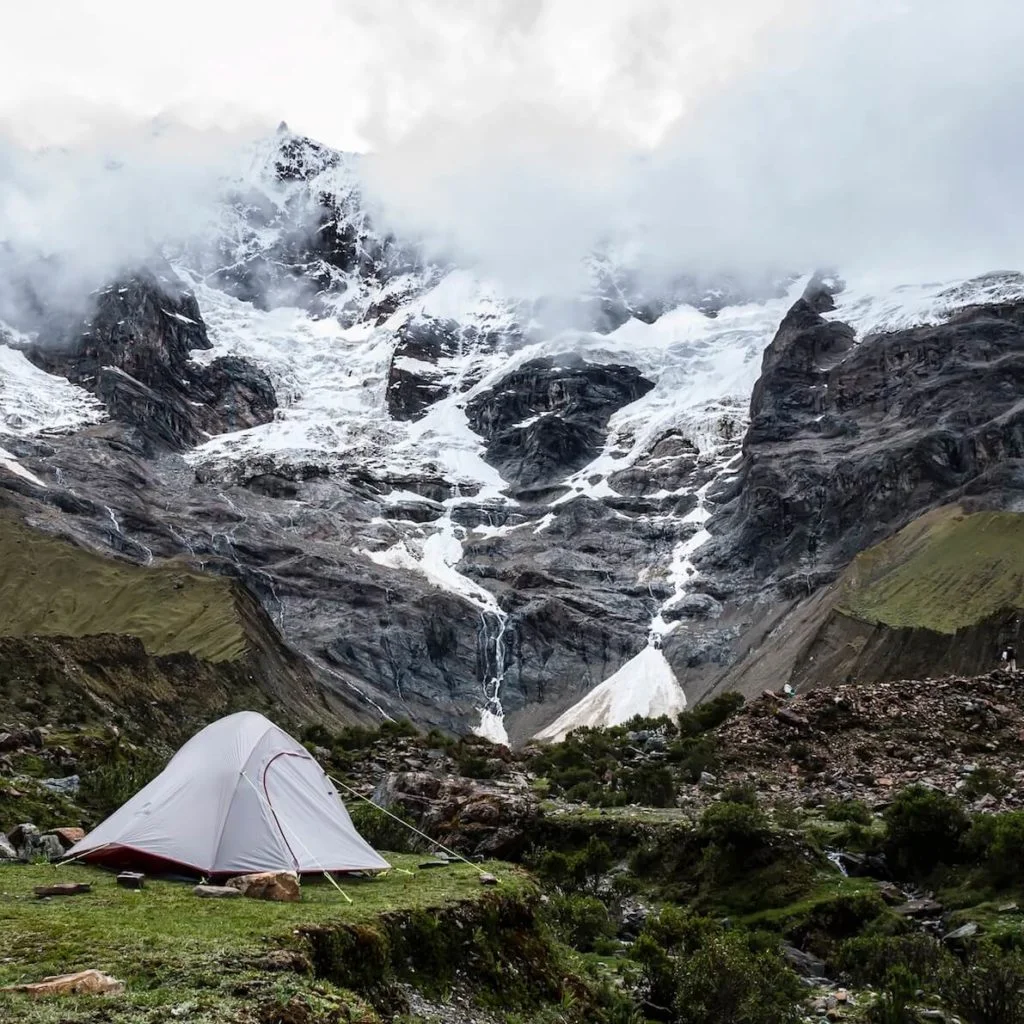
What is Salkantay Trail?
The Salkantay trek is one of the most popular alternative treks to Machu Picchu besides Inca Trail, the reason is because it offers to hikers an incredibly diverse trekking experience.
The National Geographic Adventure Magazine rated this Salkantay trek as one for the 25 Best Treks in the World .
This popular trek is one that you completed in 5 Days /4 Night; however it is possible to do the trek on a 4 Days.
The name of the trek comes from the mountain named as Salkantay (Quechua) Salcantay (Spanish).
The Salkantay Mountain
Salkantay Mountain or Nevado Salcantay is one of the most iconic mountains in the Cusco region and the highest mountain on the Willkapampa range, it is 6,271 m (20,574 ft). It is 12th highest mountain in Peru and the 38th highest in the Andes.
If you want to read more about this mountain read in wikipedia .
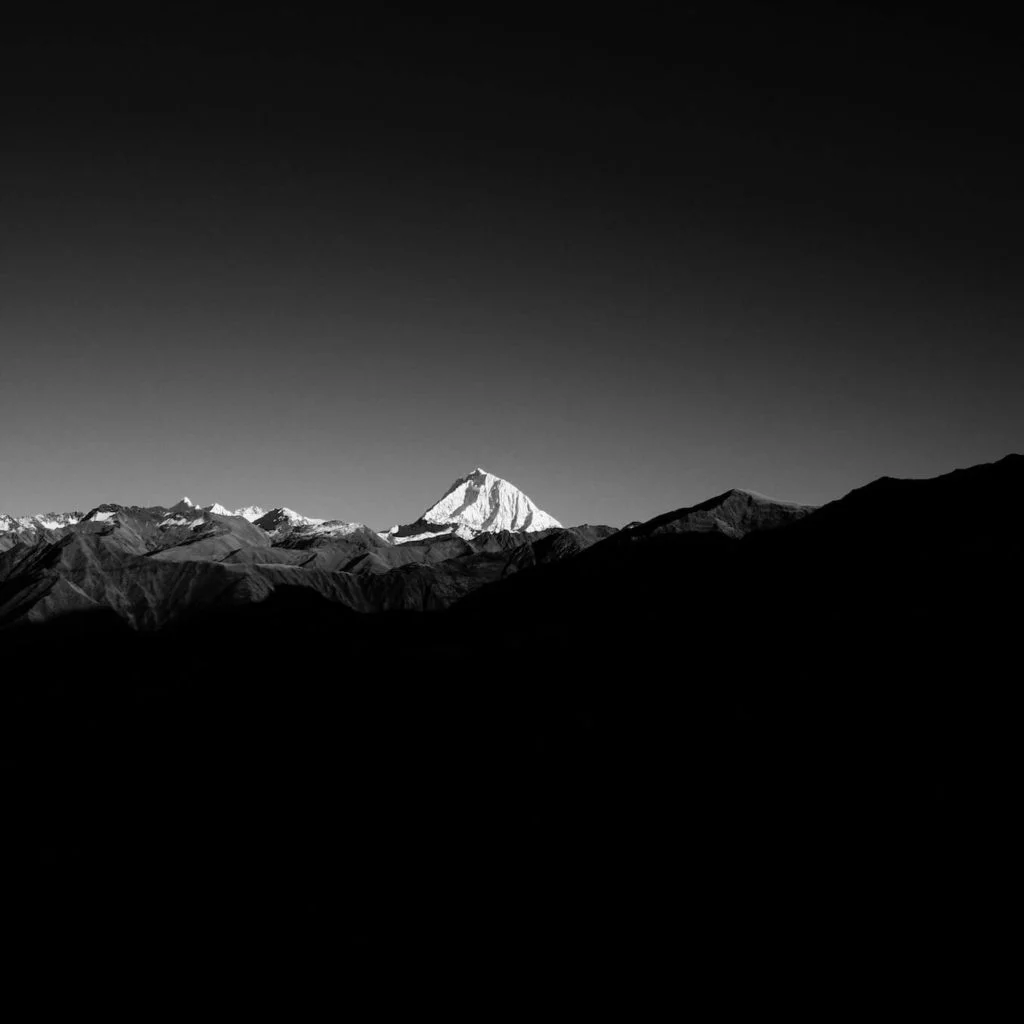
The Best Experience Ever
All our treks to Salkantay are custom-designed tours alternative to the traditional Inca Trail. Off the beaten path, this is a cutting edge experience for adventure travelers looking for a little more privacy and authenticity. With more spectacular views, the salkantay trek offers the solitude and quiet contemplation such a sacred path deserves.
Salkantay Trek to Machu Picchu: The best alternative trek to Inca Trail
The Salkantay hike crosses the Salkantay Pass, witch it is at 4600 m above sea level. Then descends into the cloud forest and passes Llactapata ruins, a Inca citadel, the trek includes an incredible view of Machu Picchu.
- Altitude: 6,271 m / 20,574 ft.
- High Season: April – November
- Duration: 5 days / 4 nights
- Level of Difficulty: Challenging due to the altitude: we recommend a period of at least 2 days for acclimatization in Cusco or over 3000m/9840ft.
- Route: Open all year round, there are no permit limitations like Inca Trail.
- Type of Tour: Best Alternative Trek to Machu Picchu
- Departures Day: Daily departures are available during the year.
Salkantay Trek Tour Itinerary
- DAY 01 : CUSCO – MOLLEPATA – SORAYPAMPA
- DAY 02 : SORAYPAMPA – SALKANTAY PASS – HUAYRACPUNKU – CHAULLAY
- DAY 03 : CHAULLAY – COLLPAPAMPA – LA PLAYA – SANTA TERESA
- DAY 04 : SANTA TERESA – HIDROELECTRYC – AGUAS CALIENTES
- DAY 05: AGUAS CALIENTES – MACHU PICCHU SANCTUARY – AGUAS CALIENTES – OLLANTAYTAMBO – CUSCO
Salkantay Trek Tips and Advices
- No matter what time of year, the road cools at night. Bring a warm sleeping bag and put your clothes in layers.
- You will need a good warm sleeping bag. Whenever possible, we recommend that you bring your own sleeping bag, however, the appropriate ones can be hired locally (for approximately US $ 25) but we can not assume any responsibility for the standard.
- If you plan to hire a bag, it is a good idea to bring a silk sleeping bag liner to use on the inside for extra warmth and comfort. A bag of four seasons (or -10) is recommended for the winter months.
- At other times, it will probably be fine in a bag of 3 stations (or -4 / -5), although this depends on how much you feel the cold and is administered only as a guide. On the trip from Salkantay to Machu Picchu wheeled mats are provided; However, for comfort and warmth, the thermal-style mattresses can also be purchased in Cusco for US $ 15.
Traveling in right season and what to bring
- If you travel in winter and do not want to invest in a 4-season bag, you can consider buying a bag of 3 more stations a sleeping bag liner and bring additional clothes.
- Whatever you wear on your feet, the most important thing is comfort. It is vital to make sure your boots are well-placed and light.
- The ankle and waterproofing is recommended, but if you already have something comfortable with a good grip on the rocks, do not rush to buy new boots. You’ll be better off with your well-used pair!
- Other mandatory items: sturdy shoes, a flashlight (with new batteries), tablets to purify water, high-calorie snacks and a basic first aid kit. Swimsuit for the hot springs of Aguas Calientes.
- You can rent towels for 3 soles. Flipflops / thongs / jandals – If you want to take a shower on the third night.
Some tips for Altitude sickness
- Altitude sickness is serious and can ruin your trip. The biggest mistake you can make is to fly directly to Cuzco (3326 m / 10,910 ft) and expect to walk the next day. Take a few days to adjust to the altitude first.
What Company Choose?
- Choose your trekking agency with care. Compare and ask many questions: what will you have to take, how many people will go to the tent, how many porters for the group, if there are arrangements for special diets. It is worth paying more for a reputable agency that treats its porters well and respects the environment.
About weather
- At any time of the year, the weather in Machu Picchu can change in an instant. Prepare with a poncho or a light rain jacket, only in the case.
Other advices
- Be sure to get your passport stamped with the Machu Picchu seal. There is a small office just after the entrance where you can do this.
- Only small backpacks of less than 20 kg are allowed in Machu Picchu. There is a storage office just after the main entrance that charges 3 soles (US $ 1) to store your things for the day.
- To the left of the entrance to Machu Picchu there is a pharmacy and a medical service available. The service is operated by Clinica ‘s Pardo and San José (from Cusco).
- The entrance to the Huayna Picchu mountain is limited to 400 people per day, 200 at 7-8 a.m. and another 200 from 10-11 a.m. Machu Picchu tickets must be purchased in advance.
- If you are afraid of heights, it is not recommended to walk through Huayna Picchu. At the top, the road is very narrow and very steep.
Salkantay Trek Without Guide
Is it possible to go to Machu Picchu by Salkantay Trek Without Guide?
The answer is yes, but you have to take several things in mind before going on your own and without a guide.
- Be prepared for height.
- Be in good physical condition
- Wanting to go to Machu Picchu.
- Check the cost below.
Costs of Salkantay Trek Solo
Going to salkantay trek without guide will be not a good idea, but even we don’t recommended you can do it.
Here a list of Cost for going to Machu Picchu by Salkantay Alone or Without a Guide.
- Bus from Cusco to Mollepata (Colectivo – like public trasnportation): 15 soles
- Taxi from Mollepata to Soraypampa: 80 soles for 3 people
- Mollepata Tickets: 10 soles
- Rent a tent in Chaullay: 10 soles
- Sahuayaco to Hidroelectrica (Colectivo): 15 soles
- Hostel in Aguas Calientes: 30 soles
- Machu Picchu main grounds ticket: 152 soles
- Group tour in Machu Picchu: 30 soles
- Bus from Hidroelectrica to Cusco: 30 soles
Total food costs (food we packed for camping, one restaurant meal in Aguas Calientes): 50 soles
TOTAL COST: 422 soles ≈ $125 USD (Price will change, and depends what time of the year you are going)
Other optional prices below.
- Hostel bed/tent at a guesthouse in Chaulley: 20-30 soles
- Macchu Pichu main grounds + Montaña Machu Picchu ticket: 200 soles
- Macchu Pichu main grounds + Huayna Picchu ticket: 200 soles
Read This Next
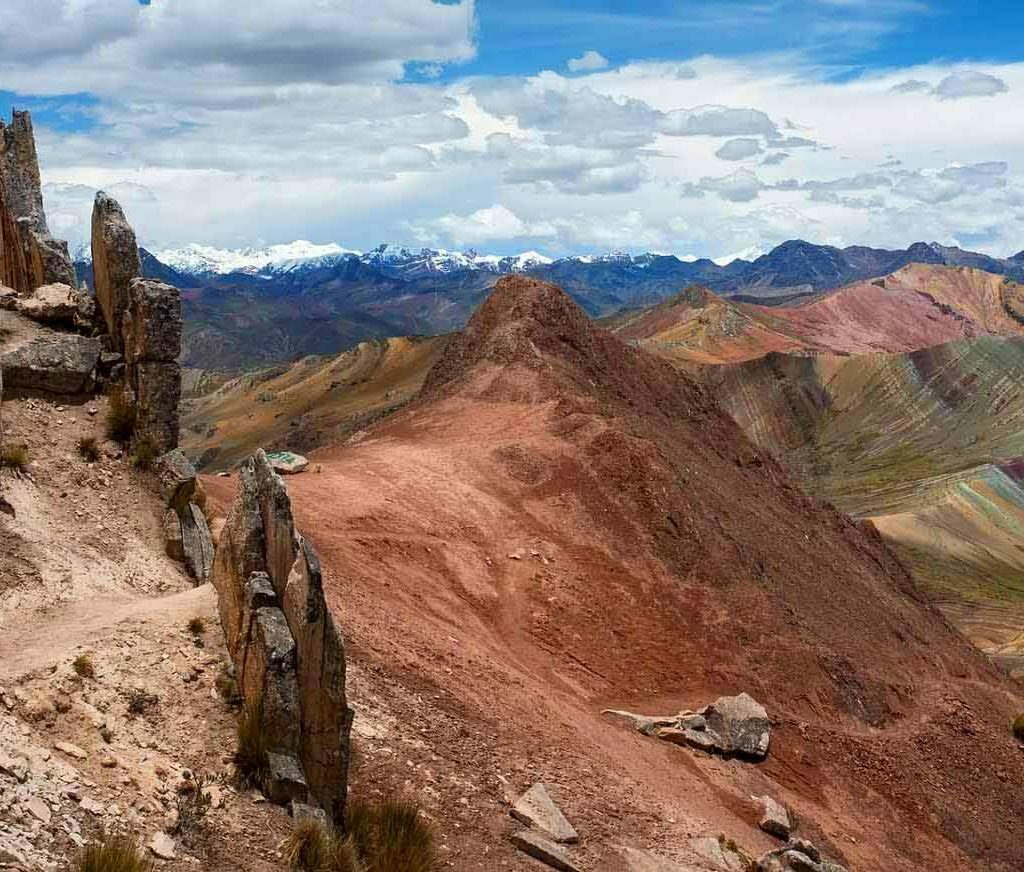
Palccoyo Rainbow Mountain
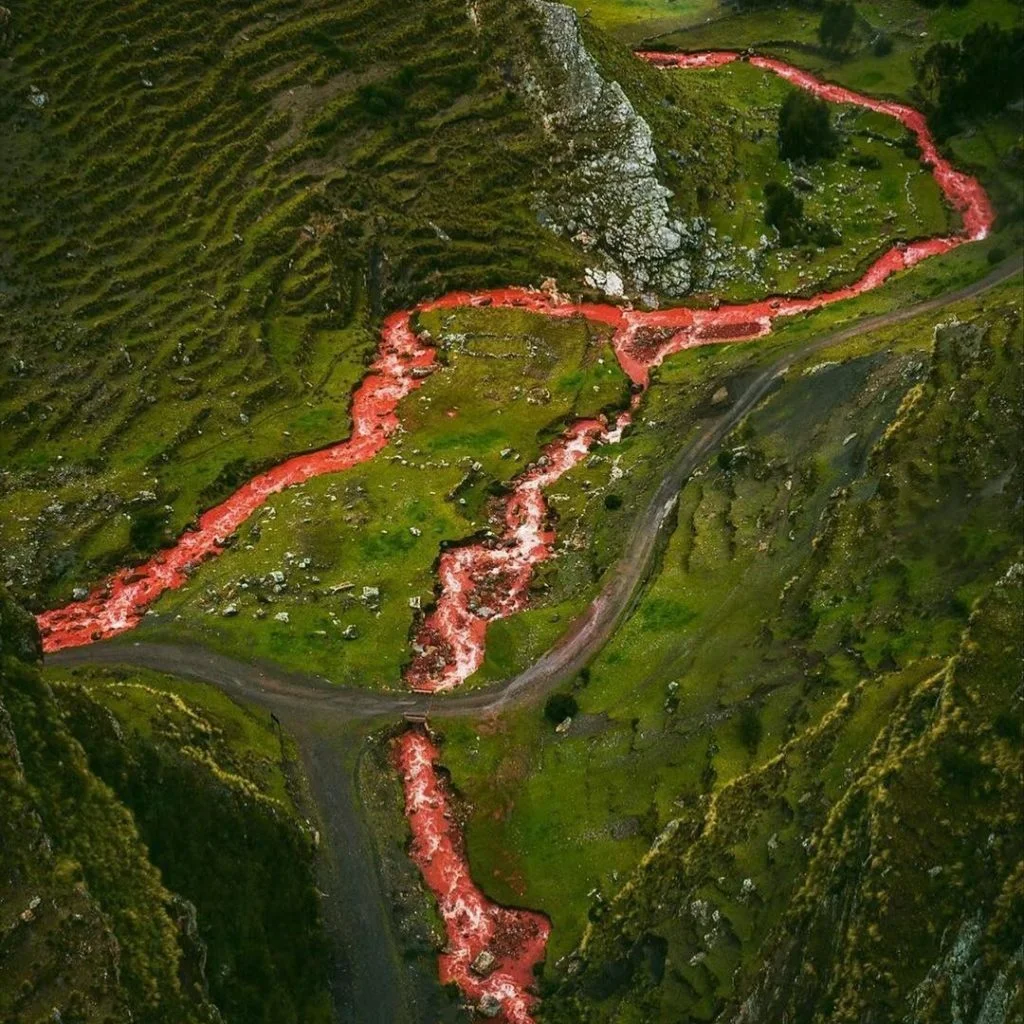
Red River in Cusco Peru
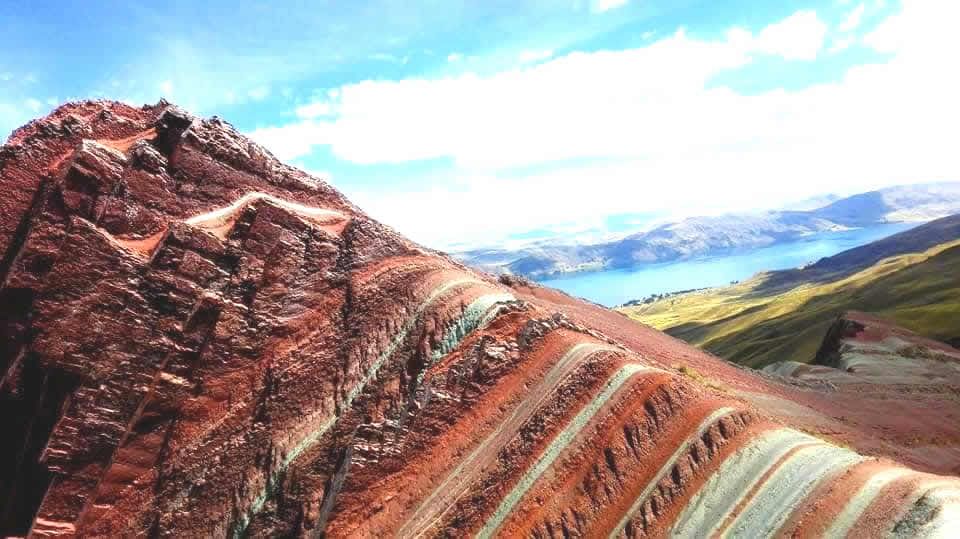
Pallay Punchu the new Rainbow Mountain in Cusco
Leave a comment cancel reply.
Your email address will not be published. Required fields are marked *
- Call Us: +51 958 191 179
- Toll Free: +1 800 916 9859
- ES +1 800 916 9859
- MX +1 800 916 9859
- UK +1 800 916 9859
- Travel Blog
- Client Reviews
- Social Projects
- Mon-Sun 9am-7pm (Peru Time PET)
- +51 958 191 179
- Enquire Now
We are here to make your Salkantay trek unforgettable from the very first step.
Salkantay Trek FAQs
We have carefully compiled our travelers' most frequently asked questions for Salkantay Trek address all your concerns.
Are you planning the exciting Salkantay trek to Machu Picchu ? We understand that you may have many questions during the process. But don't worry; we're here to help! We have carefully compiled our travelers' most frequently asked questions for Salkantay Trek address all your concerns.
Before sending us a general inquiry, we recommend exploring this page. Here you will find all the information you need about the Salkantay trek and your visit to Peru . From practical tips to important details, we have all the answers you're looking for.
Frequent Questions
Here is a list of the frequently asked questions of our passengers
Is the Salkantay Trek worth it?
Without a doubt, the Salkantay Trek is known as the best alternative route to Machu Picchu , and many would even argue that it’s better than the world-famous Inca Trail . It’s an adventurous route and comes with some challenges, but you’ll also be rewarded with incredible views and fantastic, unique experiences.
Is the Salkantay trail Difficult?
The Salkantay Trek to Machu Picchu is a moderate to challenging trek. The most challenging part of the route is day 2, when you hike up to the Salkantay Pass —reaching an altitude of 4,600 masl. It’s a 3-hour stretch and is challenging due to the uphill climb and the high altitude.
Day 1 is relatively challenging in the afternoon during the hike up to Humantay Lake. Days 3 and 4 are much more manageable and are mainly downhill—you’ll cover more distance, though.
It’s important to remember that most people would class any trek in Cusco relatively challenging due to the high altitude.
Can I do the Salkantay Trek if I have no previous hiking experience?
Absolutely! The Salkantay Trek is well-suited for individuals without prior hiking experience. You can hike at your own pace and will receive support from local guides and muleteers.
Nevertheless, it's important to note that even though you'll have the guidance of an expert hiking team, some moderate preparation is advisable. Be sure to carefully review the information under the question "How can I prepare physically for the trek?" 😉
Is Salkantay Harder than the Inca Trail?
The Salkantay Trek and the Inca Trail have their challenges, but the difficulty level can vary based on personal preferences. The Salkantay Trek can be more challenging in terms of terrain and altitude, while the Inca Trail may present difficulties due to its length and steep steps.
The choice between the two will depend on your level of physical fitness and the amount of time you have available.
What are the main differences between the Salkantay trek and the Inca Trail?
- The Inca Trail is significantly more crowded than the Salkantay trek.
- The Salkantay trek offers greater comfort with more excellent bathrooms and accommodations than the Inca Trail.
- During the Salkantay trek, you will spend a night in a hotel before entering Machu Picchu, unlike the Inca Trail.
- The Inca Trail has a considerably higher cost than the Salkantay trek.
- The Inca Trail presents a slightly higher difficulty level than the Salkantay trek.
- We require a minimum of 2 people to form a group for the Inca Trail. In contrast, we offer departures almost daily for the Salkantay trek, allowing individual travelers to join existing groups.
How Far Do We Walk Each Day?
On average, you’ll walk around 7 hours daily, but day two will be longer and the most challenging. You can find the exact hiking times per day on our itineraries. Here’s a brief overview of how far you’ll walk each day on the Classic Salkantay 5 Days trek:
- DAY 1 — 10 km / 6.21 mi
- DAY 2 — 22 km / 13.67 mi
- DAY 3 — 18 km / 11.18 mi
- DAY 4 — 25 km / 15.53 mi
- DAY 5 — No exact distance as you’ll wander around Machu Picchu at your own pace.
How Much Does the Salkantay Trek Cost?
The price of the Salkantay trek varies according to the option you choose. Below is a summary of the costs for each option. Keep in mind that the value is per person for a group trek:
- SALKANTAY CHALLENGE 3 DAYS — US$ 520
- SALKANTAY SHORT 4 DAYS — US$ 520
- SALKANTAY CLASSIC 5 DAYS — US$ 550
- SALKANTAY PREMIUM PRIVATE 5 DAYS — US$ 795
- SALKANTAY & INCA TRAIL 6 DAYS — US$ 900
- SALKANTAY & INCA TRAIL 7 DAYS — US$ 1100
- SALKANTAY IMPERIAL 8 DAYS — US$ 800
- SALKANTAY CHALLENGE 3 DAYS — US$ 420
- SALKANTAY SHORT 4 DAYS — US$ 470
- SALKANTAY CLASSIC 5 DAYS — US$ 495
- SALKANTAY PREMIUM 5 DAYS — US$ 695
Can I Rent Equipment for the Salkantay Trek?
For all of our treks, we provide you with accommodation. In addition, we have several camping items available if you wish to rent.
All our rentals are top-of-the-line equipment and can be booked in advance or at the briefing. Available rentals are:
- A sleeping bag for -15°C and a sleeping bag liner.
- Thermarest luxury air mattress.
- Adjustable walking sticks.
Of course, if you already have these pieces of equipment, you’re more than welcome to bring them along with you. Remember to keep the weight restrictions in mind, of which you have 7 kg per person.
Is it necessary to use Trekking Poles during Salkantay Trek?
Trekking poles during the Salkantay Trek is optional and depends on your personal preferences. However, we recommend bringing a pair to provide additional stability and reduce the impact on your knees while ascending and descending on uneven terrain.
How Can I Prepare Physically for the Trek?
The Salkantay Trek to Machu Picchu is a relatively challenging trek, especially on the second day. The biggest challenge is the altitude, as you’ll be hiking up to 4,600 m. You can expect to hike up to 10 hours some days, which can be very difficult at this height.
To enjoy a more pleasant and hassle-free hike, it is recommended to have proper physical preparation. What can you do to be better prepared before the trek?
- Before departing, exercise cardiovascular exercises, such as walking regularly for several days.
- Maintain a healthy and balanced diet to keep your body in optimal condition. During the journey, we will provide you with highly nutritious and varied meals to give you the energy you need daily.
- Make sure to arrive in Cusco 2 or 3 days before starting the excursion to acclimatize properly. Please do so to avoid increasing the risk of experiencing altitude sickness during the route which may require you to return to Cusco.
- Use well-worn hiking boots. New footwear on the trail can cause unwanted pain.
Is Water Included on the Trip?
Yes. You’ll need to ensure you have enough water to last the first morning, but after this, we’ll provide boiled water at every breakfast, lunch, and dinner. The water is clean and safe to drink, so you don’t need to worry about that.
You will need to bring your own water bottle or Camelbak to refill. We don’t recommend plastic bottles, as we believe in sustainable tourism and take great care of the route.
If you need extra water at any stage or any other drink, you’ll find the occasional shop or kiosk along the way that sells them and snacks.
What Is the Food Like on the Trek?
Our professional chefs are experts in creating delicious dishes that make food one of the highlights of your Salkantay Trek journey. With careful nutritional planning, we have crafted an exceptional menu that will provide you with the necessary energy throughout the route.
Each meal offers various options with fresh, local ingredients, covering all food groups. If you have allergies or dietary preferences, don't worry. If you inform us in advance, we will ensure that you enjoy meals tailored to your needs.
Additionally, we will provide you with a cloth bag to fill with snacks each day. During the "tea time" around 5 pm, you can enjoy hot beverages and appetizers at all the campsites, keeping you active until dinner. You can rest assured that you won't go hungry and will have the opportunity to taste many typical Peruvian dishes during this unforgettable experience.
Do I Need to Bring Extra Money for the Trek?
Although everything is included and paid in advance, you must bring extra money. We suggest 300 or 400 Peruvian soles. This is because, in rural areas of the country, there will not be the option of paying in dollars.
You will likely not need this money, or not all of it. However, it is always better to carry cash in an emergency.
Do I Need a Permit for the Salkantay Route?
Except for the Salkantay routes that combine with the Inca Trail, the Salkantay treks do not require a permit. However, you will need to pay 20 soles upon entry, but this does not mean that you get a permit in advance.
Can I do the Salkantay Trek with young children?
It is possible to do the Salkantay Trek with young children. However, we recommend consulting with a doctor before embarking on the hike with children, especially if they have any pre-existing medical conditions.
It is also essential to consider the pace and needs of the children during the journey. They may require frequent breaks and proper hydration to maintain their energy levels. During the first two days of the route, you can find locals offering horseback services, which can greatly help the more challenging sections of the Salkantay Trek.
What is the Recommended Age for the Salkantay Trek?
The Salkantay Trek is relatively challenging. Therefore, we suggest a minimum age of 12 years, with good health, physical preparation, and at least three days of acclimatization to successfully complete the journey.
What type of Accommodation is Provided during the Salkantay Trek?
At Salkantay Trekking, we offer different campsites for each night during the Salkantay Trek. If you choose to do the classic trek, you will have the opportunity to spend the night at:
- Sky Camp in Soraypampa: The first night, you will sleep in glass domes located in front of the sacred mountains of Humantay and Salkantay.
- Mountain Sky View in Collpapampa: Here, you will enjoy the comfort of glamping.
- Jungle Domes in Lucmabamba: Designed to blend in with the surrounding nature.
- Andean Huts in Chaullay: These huts are constructed with local resources (ichu grass and wooden sticks), providing a harmonious environment.
Salkantay Trekking offers the most incredible and exclusive campsites to relax after a long day of hiking.
Can I request the accommodation service separately?
We regret to inform you that we do not offer accommodation services separately. Each of them is designed as part of complete itineraries that has a minimum duration of two days. If you would like more information about any of our itineraries, please contact us ; we will be happy to provide you with additional details.
What is the Difference between the Classic Salkantay Trek and the Premium Salkantay Trek?
What is the difference between the 4 and 5-day treks to salkantay, will i have wifi during the trek.
If you’re hoping to contact friends and family back home, you’ll find we have WiFi available on the second and third nights of the Salkantay Trail. Please note that the service costs an additional cost of 10 soles.
The fourth night will be spent in a hotel in Aguas Calientes, where you’ll also have access to WiFi.
Will I Be Able to Charge My Devices During the Trek?
Yes. You’ll have the chance to charge your devices at each of our campsites. However, not all of them can leave your device charging overnight.
Will I Have Access to Bathrooms Along the Trek?
Yes. At each campsite, we have bathroom facilities. You’ll also find the occasional bathroom along the trek and at each lunch stop.
Will I Be Able to Have a Shower During the Trek?
Not in all campsites, you’ll find showers. However, please note the following:
- Soraypampa (1st camp): No showers.
- Collpapampa (2nd Campsite): Hot showers are available at no extra cost.
- Lucmabamba (3rd Campsite): Hot showers are available at extra cost.
- Hotel in Aguas Calientes (4th Night): Hot showers are available at no extra cost.
The camps provide facilities from local families, so you have to pay 10 soles to use the showers. You'll be in a hotel on the last night in Aguas Calientes, so there’ll be no extra charge.
Should I Rent an Extra Horse on the Trek?
If you're concerned about the hike's difficulty or the impact of altitude, we offer you the option to rent a horse at an additional cost .
- If you wish to rent a horse on the first day of the hike (from Soraypampa Humantay Lake), the approximate cost is 80 soles.
- If you wish to rent a horse on the second day of the hike (from Soraypampa to Salkantay Pass), the approximate cost is 120 soles.
It's important to note that renting a horse will take you on a different route from the group on the first day. It's not necessary to pre-book the additional horse. If you take advantage of this option, you can do so immediately without any inconvenience.
What is the Best Season to hike the Salkantay to Machu Picchu?
The answer to this question varies according to your preferences. If you want to visit Cusco during the dry season, then it is best to arrive between May and October. The rest of the year it rains most days and we can never be sure of a rain-free trip. June and July are the busiest months, so you should book well in advance. Also, at this time of year it gets cold at night.
On the other hand, you might not be too worried about the weather and would prefer to enjoy the trek without many other visitors. In this case, traveling during the wet season means there aren’t many people on the trail. Do keep in mind, though, that it’s closed during February.
Overall, the best time of year to come is in May or October. The crowds aren’t too big, and the weather is generally lovely. This way, you enjoy the best of both worlds.
Can I Join as a Solo Traveler?
Yes, you can! Solo travelers join us almost daily for our treks. Just keep in mind that you’ll likely have to share the accommodation with another solo traveler of the same sex, of course. If you prefer to have a single hotel room, we can arrange it for you for an extra.
What is the Weather Like during the Salkantay Trek?
The weather in and around Cusco can be unpredictable, making it difficult to predict exactly what kind of weather you will encounter during the trek. However, we can assure you that the first night will be very cold, with temperatures that can drop as low as 0°C (32°F).
As you descend to lower altitudes and enter the Peruvian jungle, the nights will be warmer. The rainy season in Peru generally runs from late October to April, although there is always the possibility of rainfall. Therefore, we recommend that you bring a raincoat or poncho to protect you from the rain.
Can the Salkantay Trek be done in reverse, from Machu Picchu to Soraypampa?
Yes, it is possible to do the Salkantay Trek in reverse, from Machu Picchu to Soraypampa. However, it is important to note that this option is less common and less popular than the traditional route from Soraypampa to Machu Picchu. If you are interested in doing the Salkantay Trek in the reverse direction, we recommend consulting in advance to plan your trip and ensure you have an unforgettable experience.
Find the Perfect Destination in Peru
With astonishingly varied landscapes, stunning scenery, compelling history, and a legacy of fascinating cultures, there is truly something for everyone. Our expeditions in Peru are designed to showcase all that this country has to offer.
Our expeditions in Peru are designed to showcase all that this country has to offer.
Choquequirao
Rainbow mountain, travel associations & certifications.

Start a Conversation
Hi! Click one our members below to chat on WhatsApp
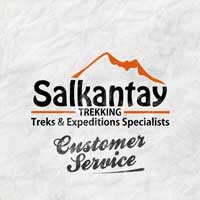
CUSTOMER SERVICE - CONTACT US
Our friendly local experts will respond to your request.
Please complete the form to request more information about any of our experiences. One of our travel specialists will contact you, often within two business hours, to confirm availability on the trip and provide you with other options.
- Traveler Blogs
- Social Projects
- Inca Trail Availability
- Office: +51 84 254278
- WhatsApp: 202-550-8534
- USA Rep: 202-550-8534
- Manager's WhatsApp: +51 986 029262
- Owner's WhatsApp: +51 947 824774
Salkantay Trek – What You Need To Know
Though somewhat lesser-known than the world-famous Inca Trail , the Salkantay Mountain trek is stunning and ranked by hikers and travel publications as one of the best treks in the world. Travelers on the Salkantay Trail take a remote footpath through lush rainforests and travel through an archeological site, a stunning vivid lagoon, and breathtaking mountain views on the way to Machu Picchu.
Are you interested in learning more about this incredibly underrated adventure? Here’s everything you need to know before trekking at Salkantay!
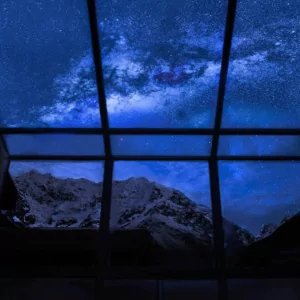
History of Salkantay
The massive Salkantay Mountain is the highest point of the Peruvian Andes Mountains. “Salkantay” is a Quechua word meaning “savage mountain.” The name originates from the Quechua term “Salka,” meaning “Wild.” This name reflects the abundant vegetation and diverse wildlife in the cloud forest that dominates the entire geographic area traversed by the pass.
Before it became a popular tourist attraction, the Salkantay trail was primarily used as a mule track by muleteers who transported various goods, including fruits, vegetables, and other items from the jungle. These skilled individuals relied on the route to transport supplies to different areas of the region, quickly navigating the challenging terrain.

Why Trek Salkantay?
There are several reasons you should consider the Salkantay Trek for an intimate look into the area around Machu Picchu.
Fewer Crowds Than the Iconic Inca Trail Every year, roughly 66,000 hikers trek the Inca trail. In comparison, the Salkantay trek only has an average of 30,000 annually. That means far fewer people to navigate on the path and at the stunning viewpoints.
Breathtaking Views It’s impossible not to use words like magical, enchanting, and surreal when hiking the Salkantay Trek. From lush jungle scenery to awe-inspiring mountain vistas, there are a vast array of sights to appreciate at every step of the trip.
Stunning and Creative Glamping and Accommodations Taking part in our Super Salkantay Trek (5D/5N) offers our visitors exclusive accommodations, including glamping accommodations with hot showers and a campsite with unforgettable Machu Picchu views. All of our accommodations are very private, ensuring that hikers have enough quiet space to relax before the next day’s trek.
Enjoy Humantay Lake Without Crowds Our trips prioritize a pristine, private Humantay Lake experience by visiting this famous sight before sunrise. As a result, you’ll get to take in the views of the lagoon, often without another hiker in sight.
Witness Rare Perspectives of Macchu Picchu Many of our trekker’s favorite view they get to experience on the trip is from our private campsite facing the backside of Machu Picchu. This is the first glimpse of the iconic archeological site, and many people that travel to Machu Picchu won’t have the chance to witness the scenery from this angle. As you relax at our campsite after a day of hiking, you’ll get to take in this Inca masterpiece as the sun sets over the historic peaks.
Closer Encounters with the Flora, Fauna and Culture of the Area Because this trail isn’t as well-known as the Inca trail, trekkers have a unique opportunity to embark on “the road less traveled.” The Salkantay trail can feel more intimate and help you further connect with these mountains’ stunning nature, culture, and history.

Frequently Asked Questions About The Salkantay Trek
Why choose salkantay over the inca trail.
Both trails are worth exploring, each offering unique pros and cons. However, hikers may choose the Salkantay trek over the Inca trail to avoid crowds and enjoy a more intimate hiking experience.
Where do you sleep when trekking Salkantay?
Contrary to what you may believe, you don’t have to spend every night in a tent when hiking the Salkantay Trek! On our most popular 5-day Salkantay Trek , a couple of nights are spent in tents with stunning views, but we also offer unique and beautiful glamping accommodations that feature:
- Glass Cabañas in Soraypampa with out-of-this-world southern hemisphere star gazing.
- Custom-built glamping accommodations featuring views of the mountain ranges, jacuzzi pools, and hot showers.
- Cozy “Hobbit Houses” near the river that transport you right to “Middle Earth.

Who Can Trek Salkantay?
With its extreme elevation changes and ever-changing terrain, this trek is not for the faint of heart. But fear not! Alpaca Expeditions is here to help you conquer the Salkantay trek with a smile on your face. Our expert guides are masters at making sure everyone, no matter their experience level, has a blast while trekking through the mountains.
What is the best time of year to Trek Salkantay?
The dry season from May to September offers optimal hiking conditions on the Salkantay trail , with warm, tropical weather in the jungle and clear views of the mountains.
During the dry season, days offer spectacular views of the towering mountain ranges and their snow-capped mountains and nights complement the days of hiking nicely with cloud-free, starry skies.
March, April, October and November are also acceptable for hiking, but you may run into some weather on the trail. Though in most cases, such weather conditions occur in the early morning hours and have minimal impact on visibility and hiking conditions.

What Do We Eat While Trekking Salkantay?
Did you know that Peru has one of the world’s most highly-respected and revered national cuisines? Every meal you’ll experience during a guided trek through Peru’s most sacred mountain range reflects this passion for flavor.
Each day of hiking is broken up by fresh, deliciously prepared food by the best chefs in the mountains . You can expect three hot meals daily and more than enough food to energize your body for the strenuous hikes ahead.
What are Some Highlights of the Salkantay Trek?
What types of sights and experiences will you encounter on your Salkantay trek? Here are just a few!
- Andean Enchantment – you’ll encounter majestic sights that include glacial peaks, stunning cloud forests, historic Incan mountain passes, and dazzling mountain scenery—all of which seem designed for the camera.
- Humantay Lake – The stunning natural scenery, unique geological features, spiritual significance and vibrant lagoon color make Humantay Lake a truly memorable part of your Salkantay trek. The turquoise-blue waters and rugged mountain terrain create beautiful photos and memories to last a lifetime.
- Ruins of Llactapata – These ruins are believed to have been built by the Inca civilization around the 15th century. They are situated on a hilltop overlooking the Urubamba River and the famous Machu Picchu.
- Machu Picchu – A UNESCO World Heritage Site , Machu Picchu is located in Southern Peru on an eastern slope of the Andes Mountains. The 15th-century Inca citadel is perched 2,430 m above sea level, complemented by lush mountain forests, waterfalls, and other visually arresting scenery. This archaeological site is the culmination of the Salkantay Trek. Witnessing Machu Picchu is truly an experience hikers will never forget.
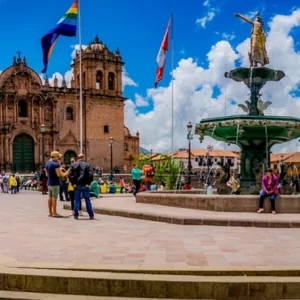
What is an example trip itinerary?
There are multiple trip options to tackle the Salkantay trek , but the most popular is the Classic 5 Day5 Night Salkantay Trek . This unforgettable adventure takes you to several stunning sites around Salkantay, including Humantay Lagoon and Machu Picchu. Here is an example itinerary:
- Begin the trip from your Cusco hotel and meet the Alpaca trekking team.
- You will drive along the Sacred Valley and into the mountains to the glamping Glass Cabanas in Soraypampa. That evening, you will enjoy one of the most beautiful sunsets in the world.
- At the campsite, your guides settle you comfortably in your tents. Next, savor a delicious dinner prepared by our top-rated chefs. Later that night, take in the view of the brilliant night sky adorned by countless stars.
- After a night’s rest, you will wake up before dawn to eat a hearty breakfast before the first trek. The first day’s hike begins with a visit to the Humantay Lagoon. Take in the crystal-blue waters at this famous site. Some believe that touching the icy waters ensures you’ll stay young forever!
- At this point, you then hike to Salkantay Pass, the highest point of your trek. You’ll enjoy an incredible hot lunch just before the top of the pass, with views of the glaciers on Salkantay “Savage” mountain.
- From here, you descend to your campsite.
- Your second day of hiking begins in the cold mountains but ends at a lower, warmer altitude. Explore stunning waterfalls and the lush flora and native fauna of Peru. Each day of the journey brings you up close to the gorgeous land and people of the area.
- Day 3 provides your first glimpse of Machu Picchu. Savor the sunset over this Inca masterpiece at our private campsite.
- Viewing an incredible waterfall that currently generates electricity for the Cusco region.
- You will marvel at the natural beauty by hiking the same path as the man who rediscovered Machu Picchu in 1911.
- Your hotel awaits you at the end of a long day of hiking. Rest well; the next day, you will explore Machu Picchu!
- Your final day is what you’ve been waiting for. Visiting Machu Picchu with our expert guides is an experience like no other. There is also time to look around the site on your own. Or, arrange to hike Huayna Picchu. Either way, your time at Machu Picchu will be an incredible one.
What People are Saying About The Salkantay Trek
BEST VACATION EVER!!!!
I have done my fair share of traveling, of all types. Without a doubt this was THE BEST TRIP OF MY LIFE!!!!!!!!!!!!!!!!!!!!
We did a private week-long trek to Salkantay and the Inca Trail. What a bargain for $1200 USD per person. I read over and over from satisfied clients that the food was better than restaurants and that they came back gaining weight. My first interpretation was that of course food was going to taste good after being starving from hiking all day. No, the food really is terrific and MUCH MUCH better than what we ate at restaurants in Peru. We were thoroughly pampered by our wonderful crew, Cesar (guide), Julian (head chef), Francisco (aka Pancho, sous chef), the chaskas – Cipriani, Beltran, Ephrahim, and Benefio, and our horseman.
Cesar, our guide, is truly passionate about the history and archeology of Peru. Nothing made him happier than having u7 Day Salkantay and Inca Trail Trek – Alpaca Expeditionss ask him questions about the various archeological remains. He did everything to make our trip memorable. When I accidentally broke my camera on the first day, he gave me his camera to use. He was able to balance time in such a way that we had plenty of time with him and his guidance, but wasn’t always around so that we felt that we had a babysitter. It was the perfect amount of time with a guide and having privacy. Because of our great experience with Cesar, we know consider him a good friend. Every morning we were woken up with a cup of hot coca tea. Then we were delighted with a hot breakfast (various different kinds of porridge, pancakes, fruit, eggs, etc). Before we left, we got a snack (fruit and some kind of cookie or cracker) and we went on our hike. The chaskis (porters) packed everything up and beat us to our lunch time location. Then they set up the dining/cooking tent and prepare a wonderful multi-course hot lunch – appetizer, several courses (meat and vegetables) and dessert. After stuffing ourselves, we took a quick nap. Then we went on our afternoon hike. Again, the chaskis packed everything up and beat us to our evening camping spot. When we arrive, it was happy hour time with tea, hot chocolate, cookies, and freshly popped popcorn. Next was dinner, another multi-course meal. They fed us so well that we usually couldn’t eat our snack
Are you ready to book your adventure trekking through the beauty of the Andes? See all of our Salkantay Trek options here!
Alpaca Expeditions Recognitions
Iso (international organization for standardization).
In the pursuit to stand out from the rest, Alpaca Expeditions has obtained four ISOs plus our carbon footprint certificate to date. These achievements result from our efforts to implement the internationally-recognized integrated management system. They also represent our commitment to all of our clients and staff of operating sustainability and responsibility in every way possible.

World Travel Awards
Alpaca Expeditions is internationally recognized as a leading tourism company in Peru. As proof, we have been awarded the World Travel Award for Peru´s Best Tour Operator 2021 for the second time.
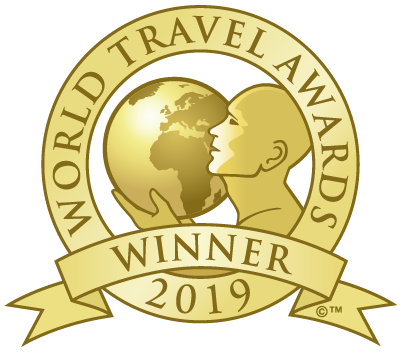
TRIPADVISOR RECOGNITIONS
Our goal at Alpaca Expeditions is to create the best experience for all of our clients. We create journeys that are to be remembered for a lifetime. Journeys you can be proud of and can share with everybody around you.
As Featured In

Hotel to Hotel service
Regarding the transportation provided by Alpaca Expeditions, we are committed to delivering a quality service. We strive to ensure that passengers feel supported throughout their journey. To achieve this, we coordinate closely with our guides and representatives to ensure timely pick-up at the start of their tours. Additionally, we have representatives responsible for escorting our passengers to their hotels at the conclusion of any tour.
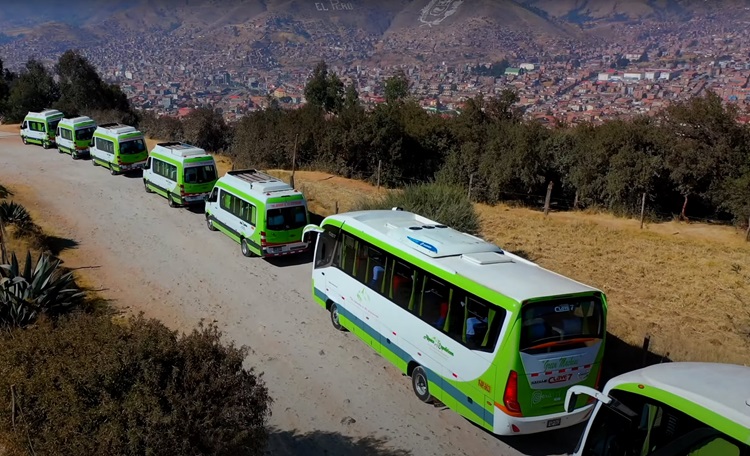
Our drivers are not only trained in customer service but also come properly uniformed, and many are fluent in English.
Typically, all transportation types are included in each of our services. For instance, if you have booked a trekking tour, we will pick you up early, typically between 4 AM and 5 AM. When visiting Cusco, it's important to note that traffic here is generally moderate. However, there are peak traffic times, such as between 7 AM and 8 AM, which coincide with school hours, and in the evening between 6:00 PM and 8:00 PM. Therefore, if you have a flight during these times, it's crucial to be at the airport at least 2 hours in advance. The drivers of Alpaca Expeditions ensure their vehicles are prepared with all necessities before each service. They are acutely aware that delays can lead to missed trains, flights, or other connections. Consequently, they are always more than punctual, arriving at least 10 minutes before the scheduled time for any service, understanding the responsibility they carry in executing these tasks.
Personal Porter of 7KG
Remember that Alpaca Expeditions offers an extra 7 kg allowance for your personal belongings on any of our tours. We include a personal porter who is responsible for carrying your duffel bag without any additional fee. You will not have access to your duffel bag until you reach your evening campsite. The bag should not exceed 7 kg, which includes 4 kg for clothes and 3 kg for your sleeping bag and sleeping mat.
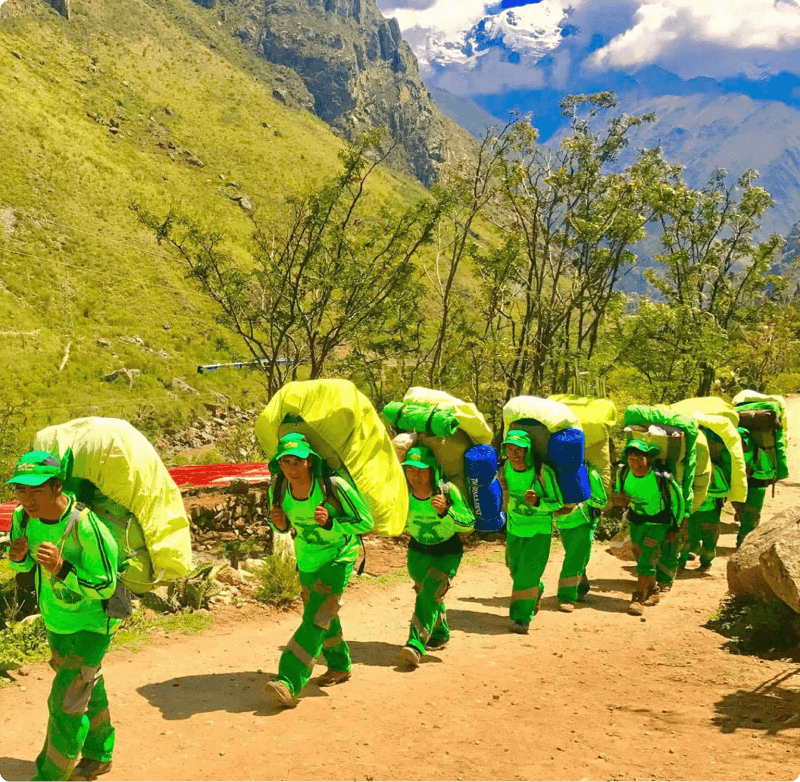
Each Alpaca Expeditions porter is paid directly after each trek, allowing them to return home more quickly. They receive better wages than our competitors, health insurance, and all their equipment free of charge, including hiking boots, pants, jerseys, fleeces, jackets, hats, flashlights, sleeping bags, and high-quality food. We ensure each of our porters has a comfortable bed in a pleasant room to sleep in before and after each trek. We also visit the communities they live in, providing toothpaste, toothbrushes, soap, and other necessary supplies to their families, along with books for their children.
This is just the beginning for us, and we are always looking for ways to do more. While the government allows each porter to carry up to 25 kg, we limit this to 20 kg to prioritize their health and safety. Each porter carries up to 15 kg of company equipment and 5 kg of personal items. This is why it is crucial to keep your personal duffel bag weight under our 7 kg limit. You might see other companies allowing their porters to carry more than the allotted weight, but at Alpaca Expeditions, we strictly adhere to these limits to ensure our porters' well-being.
Clases de Cocina
Alpaca Expeditions offers its passengers the chance to experience local cooking. We aim to immerse trekkers in Inca life by walking them through the original Inca paths and teaching them about Inca culture. Food is a significant part of Inca life, making it a special element in any tour or trek with Alpaca Expeditions.
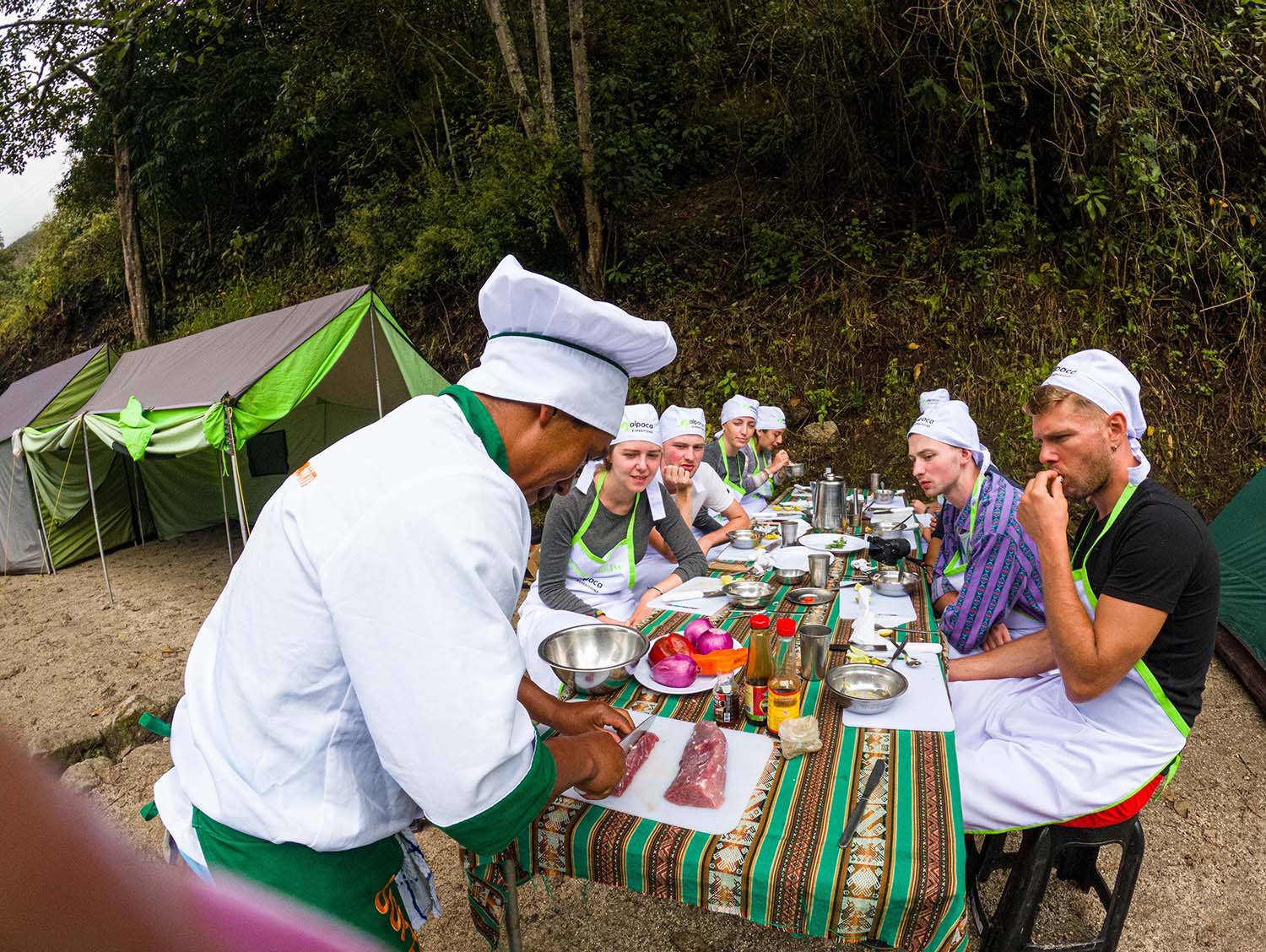
In 2022, Alpaca Expeditions introduced a cooking class as part of each of our treks, conducted by our amazing trekking chefs and interpreted by our guides.
We will transform your dining tent into a makeshift kitchen, providing all the necessary supplies to prepare a Peruvian specialty. Your chef will guide you step by step through the process of making a traditional Peruvian meal, such as Lomo Saltado, and share some essential mountain cooking tips.
Peru is recognized as a top culinary destination, largely thanks to the popularity of our renowned beef dish, Lomo Saltado. This is most often the meal you will learn to cook, but there is also the opportunity to learn how to prepare other dishes like traditional Peruvian ceviche or even our signature drink, the pisco sour.
Cooking Class on the Inca Trail: These classes are voluntary and designed to be a fun, educational experience. Our clients consistently marvel at the amazing ability of our chefs to create culinary magic on a mountaintop. As you learn to prepare and cook Peruvian specialties, you will also see firsthand how such elaborate meals can be created on a small campsite stove.
Enjoy a cooking class in the mountains and be sure to take plenty of photos, just in case your friends won't believe your incredible experience.
Satellite Phones
The best way to hike in the mountains of Peru is to completely disconnect from technology, especially the internet and cell phones. The most impressive and exciting aspect is the opportunity to experience the true and wonderful nature that we often miss when we are at home, watching TV or absorbed in our cell phones during our leisure time. The feeling of being disconnected from work and the daily routine left at home is incredible.
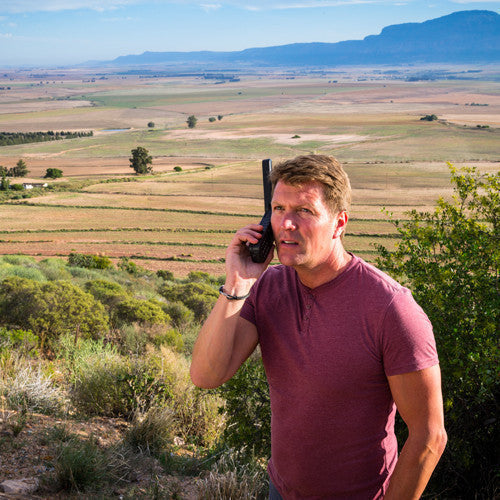
However, this remoteness means limited access to emergency resources. That's why Alpaca Expeditions has invested in satellite phones for every trek.
We are prepared to assist you in case of any emergency, particularly health-related issues. For this reason, Alpaca Expeditions has invested in satellite phones, as they are one of the most crucial tools for any operator trekking in remote areas where telephone or television signals are absent. This means that every guide on our treks will be equipped with a fully charged satellite phone as well as radios. While these are primarily for emergencies, we allow our clients to use them at any time.
We ask that you cover the cost, which is $2.50 per minute. This fee can be paid in cash at our office or via PayPal once you have completed the trek.
Being just a phone call away from any doctor, hospital, or friend helps everyone feel assured of their safety. Radios, which all our guides carry, have limited reach, so Alpaca Expeditions includes satellite phones to ensure that we can connect no matter where we are on the mountain.
Portable private toilet
We understand that our clients will need restroom facilities at various times and locations during their journey. Along the Inca Trail, there are restrooms available, particularly those belonging to the communities near the trail. Alpaca Expeditions provides portable toilets to enhance this service, which will be set up at each meal site or campsite.
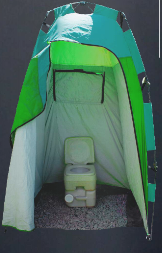
As with any mountain trip where we are exposed to nature, it is possible to use natural areas as restrooms. However, it is crucial to be mindful of the waste we generate, such as toilet paper or wet wipes used for cleaning. These should be carried with us and not discarded on the ground or left along the trail. Remember, the Inca Trail is a protected area overseen by a government institution. In places where garbage bins are unavailable, particularly at our camps, we provide special plastic bags for waste. Our porter team will be responsible for carrying out our waste.
Please be aware that although there are designated bathrooms for men and women, in practice, both genders often use the same facilities. Functionally, there is no significant difference between men's and women's bathrooms. Therefore, it is common for people of all genders to use whichever bathroom is available.
The Moscow metro will remain without advertising
- Vladimir Chernikov
- Gyula Kogan
- Konstantin Gorokhov
- Government of Moscow
- State Unitary Enterprise "Moscow Metro"

Related materials
- Vladimir Yevtushenkov wants to slip the left microchip into the subway Business | 17.09.2020
- Kambarskiy regional plant risks remaining without orders Business | 18.06.2018
- TRK Company did not pay Moscow for billboards Business | 10.01.2018
- Andrei Kostin knocked out German Gref from the Moscow subway Business | 27.11.2017
- One day in Moscow feeds for the whole year Business | 22.08.2016
- Why Moscow sinks: how reconstruction of streets clogged drains Society | 26.07.2016
- Arkady Volozh's son gets rid of real estate development business Business | 17.02.2016
- Moscow earns nothing on paid parking Officials | 25.01.2016
- Advertisement in the metro drove a wedge between the Moscow officials Officials | 26.11.2014
- State order for Artemy Lebedev Society | 26.08.2014
- Who and what makes money on provision of urban amenities in Moscow Business | 03.07.2014
- Profitable dump: billionaires and state-owned companies joined the struggle for the wastes market Business | 12.02.2014

Moscow Sky Lights Up With Strange Glow After Explosion at Electrical Substation: Reports
N ew footage has emerged showing bright flashes lighting up the night sky in southern Moscow during the early morning hours of November 22.
Knewz.com has learned that there was an explosion at an electrical substation on the outskirts of Russia's capital city followed by an alleged power outage in "several" homes.
Video snippets, shared on Russian news channels like ASTRA , captured a series of flashes that caused the sky to change color. Smoke could also be seen rising from a building.
Corroborating the video, several Russian Telegram accounts reported an explosion near the south of Moscow and a subsequent fire at the Lyublino electrical substation, southeast of central Moscow, per Newsweek .
The local authorities from the area have since confirmed that an explosion occurred in the village of Molokovo, but they reassured the public that all vital facilities were operating as normal.
Russian outlet MSK1.ru reported the blaze at the substation and noted “several” power outages.
The town of Lytkarino, located to the southeast of Moscow, was one of the affected areas, as reported by the independent outlet, Meduza .
Additional power failures were reported in the southern Domodedovo section of the city. However, electricity was later restored to these areas.
One local resident speculated that a drone may have been responsible for the explosion, but additional sources are yet to support this theory.
Newsweek reported that messages on the ASTRA Telegram account run by independent Russian journalists showed residents near the substation panicking. One concerned Russian called it a "nightmare."
The incident follows an attack by Russia on a power station in southwestern Ukraine that left 2,000 people without electricity .
Knewz.com reported previously:
“ Russian forces launched a total of 38 Iranian-made Shahed-136/131 drones during the later hours of November 17 and 18.
The Ukrainian Air Force Command reported that 29 of these drones were shot down [...].
One civilian was injured as a result of the attack that targeted energy infrastructure in the southwestern Odesa Oblast.”
The assault came after repeated warnings by Ukraine’s President Volodymyr Zelensky that Russia would try to cripple its power grid as winter approaches.
Ukraine's leader warned that if Russia resorted to attacking its power utilities, it would respond in kind.
Ukraine has conducted numerous long-range aerial drone strikes on Moscow since May 2023.
Most recently on November 20, it was reported that one such incursion was intercepted close to the city, per Kyiv Post .
Moscow’s Mayor Sergei Sobyanin confirmed this and elaborated that the region's air defense systems intercepted the unmanned craft over the city of Elektrostal to the east of Moscow, as well as another over the Bogorodsky district, northeast of central Moscow.
The details of the recently surfaced video footage have yet to be independently verified.


IMAGES
COMMENTS
The Salkantay Trek is a trekking route to arrive to Machu Picchu. It is an alternative to the more famous, but much more regulated Inca Trail, which has a limited number of trekkers allowed per day and gets full months in advance. This is not the case in Salkantay, as there is not a limit in the number of trekkers allowed.
Salkantay Trek Prices. The average price of a guided tour of the Salkantay Trek is anywhere from $350 to $700 per person. This includes everything from transportation, food, accommodations (usually in a tent) and Machu Picchu entrance tickets. The total cost we spent $725 as a couple or $362 per person.
Trail Information. 4. 5-Day Itinerary. Day 1: Cusco to Soraypampa to Laguna Humantay. Day 2: Soraypampa to Collpapampa. Day 3: Collpapampa to Lucmabamba. Day 4: Lucmabamba to Aguas Calientes. Day 5: Machu Picchu. 5. Basic Precautions for the Salkantay Trek without a Tour.
Discover the beauty of the Salkantay Trek without the expense of hiring a guide. Follow our comprehensive guide for an unforgettable adventure. Skip to content. PERU: +51 992 509 095; ... You can also stay in campgrounds that provide tents, mattresses, and sleeping bags. Glass domes are one of the more opulent options available in some cities.
Day 1 of Unguided Salkantay Trek: Cusco to Soraypampa. From Cusco, you can hire a private car, taxi or public bus to take you to Mollepata or Challacancha. You can also find transport from the Sacred Valley areas of Urubamba and Ollantaytambo. Costs vary depending on the mode of transport and departure town.
They had either gotten a ride from a guide service or taken an additional collectiva or a taxi after arriving in Mollepeta. In addition, only one place allows travelers to stay without a guide called "Salkantay Hostels.". The cost is 67 soles per person for 1-night accommodation, breakfast, and dinner.
The Salkantay Trek is about a 45-mile (75 km) trek from the town of Soraypampa, up over Abra Salkantay Pass, down into the jungle, and all the way to the ancient Incan archaeological site, Machu Picchu. Along the way you hike over the 15,092 foot (4600m) Abra Salkantay Pass, then quickly descend down into the jungle for the next few days of ...
The Basics About the Salkantay Trek. The Salkantay Trek has long been known as a less-busy alternative to the famous Inca Trail, the original trail created by the Incan people to Machu Picchu. With the limited number of permits available for the Incan Trail, and with how hard it is to snag one of those spots, this is an incredible alternative.
Humantay Lake is a stunning alpine lake sitting at almost 14,000 feet in elevation. We embarked on the Salkantay Trek 5 days without a guide, tent or reserv...
Here is a comparison of these three hikes to Machu Picchu: Salkantay Trek: Distance: 74 km (46 miles) Time: 4-5 days. Altitude: 4,580 meters (15,026 ft) at the highest point. Things to do/see: Humantay Lagoon, Santa Theresa hot springs, Apacheta Pass, views of Salkantay Mountain, ziplining. Price: $550+ USD.
What we found the most difficult about the Salkantay Trek was the constant changes in elevations and temperatures. From about 4600 meters, you will descend to 2000 meters above sea level, and from cold, harsh, windy, and possibly rainy weather, you will appear in the hot and humid areas of the Peruvian jungle.
If you are short on time, give it 2-3 days minimum before starting out on the Salkantay Trail. Here are a few tips to prevent altitude sickness. Coca leaves are a traditional way to relieve altitude sickness by chewing it or making tea with it. Coca leaves can be bought at any local supermarket and are available in most restaurants.
Salkantay trek - a 5-day itinerary. Day 1. Bus Cusco - Mollepata, 100km. Mollepata - Soraypampa, 22km. Cusco (3400m) - bus to Mollepata (2900m) - Soraypampa (3900m), 22km/13,6 miles. If you want to walk all the way to Soraypampa we'd recommend to start the day early and take a morning bus from Cusco.
Yours truly and Ryan "Dirtmonger" Sylva on top of Machu Picchu Peak - finishing point of our Salkantay Trek. Highest Point: Salkantay Pass 4630 m (15,190 ft) Lowest Point: Hydroelectric Plant 1800 m (5906 ft) Difficulty : Easy to moderate. Transport: Mollepata - Three hours by regular buses from Cusco.
The Salkantay trek starts at Soraypampa at an elevation of 3,900 metres above sea level. The elevation profile for the rest of the hike is as follows: Day One: Soraypampa (3,900 metres) - Humantay Lake (4,200 metres) - Soraypampa (3,900 metres) - Salkantay Pass (4,620 metres) - Wayramachay (3,800 metres)
Salkantay Trek to Machu Picchu: The best alternative trek to Inca Trail . The Salkantay hike crosses the Salkantay Pass, witch it is at 4600 m above sea level. Then descends into the cloud forest and passes Llactapata ruins, a Inca citadel, the trek includes an incredible view of Machu Picchu. Altitude: 6,271 m / 20,574 ft.
Without a doubt, the Salkantay Trek is known as the best alternative route to Machu Picchu, and many would even argue that it's better than the world-famous Inca Trail. It's an adventurous route and comes with some challenges, but you'll also be rewarded with incredible views and fantastic, unique experiences.
Contrary to what you may believe, you don't have to spend every night in a tent when hiking the Salkantay Trek! ... Without a doubt this was THE BEST TRIP OF MY LIFE!!!!! We did a private week-long trek to Salkantay and the Inca Trail. What a bargain for $1200 USD per person. I read over and over from satisfied clients that the food was ...
Emergency situation declared in Elektrostal of Moscow region as eastern districts of the city are without heat since November Moscow - Map of Latest News and incidents from Russia in English - russia.liveuamap.com. source On live map. Tell friends. Hide advertising, enable features from $8/month.
The Moscow metro will remain without advertising. Pre-term breach of contracts with Moscow is becoming the norm on the advertising market. As it became known to RBC, the Moscow Metro is willing to break with its advertising partner, Auto Sell. 16.07.2015. RBC Origin source.
In 1954, Elemash began to produce fuel assemblies, including for the first nuclear power plant in the world, located in Obninsk. In 1959, the facility produced the fuel for the Soviet Union's first icebreaker. Its fuel assembly production became serial in 1965 and automated in 1982. 1. Today, Elemash is one of the largest TVEL nuclear fuel ...
New footage has emerged showing bright flashes lighting up the night sky in southern Moscow during the early morning hours of November 22. Knewz.com has learned that there was an explosion at an ...